





































AND YOU CAN TOO, AS WE CATCH UP WITH SOME OF THE CONSTRUCTION INDUSTRY’S MOST INTERESTING AND KNOWLEDGEABLE CHARACTERS ON THE NEW GROUND BREAKING PROFESSIONAL BUILDER PODCAST WITH SMITH AND JONES.












LEARN A NEW BUSINESS SKILL OR FINE TUNE AN OLD ONE FROM THE GUYS AND GIRLS AT THE SHARP END, WHO HAVE BEEN THERE, DONE IT AND GOT THE PB T SHIRT TO BOOT!


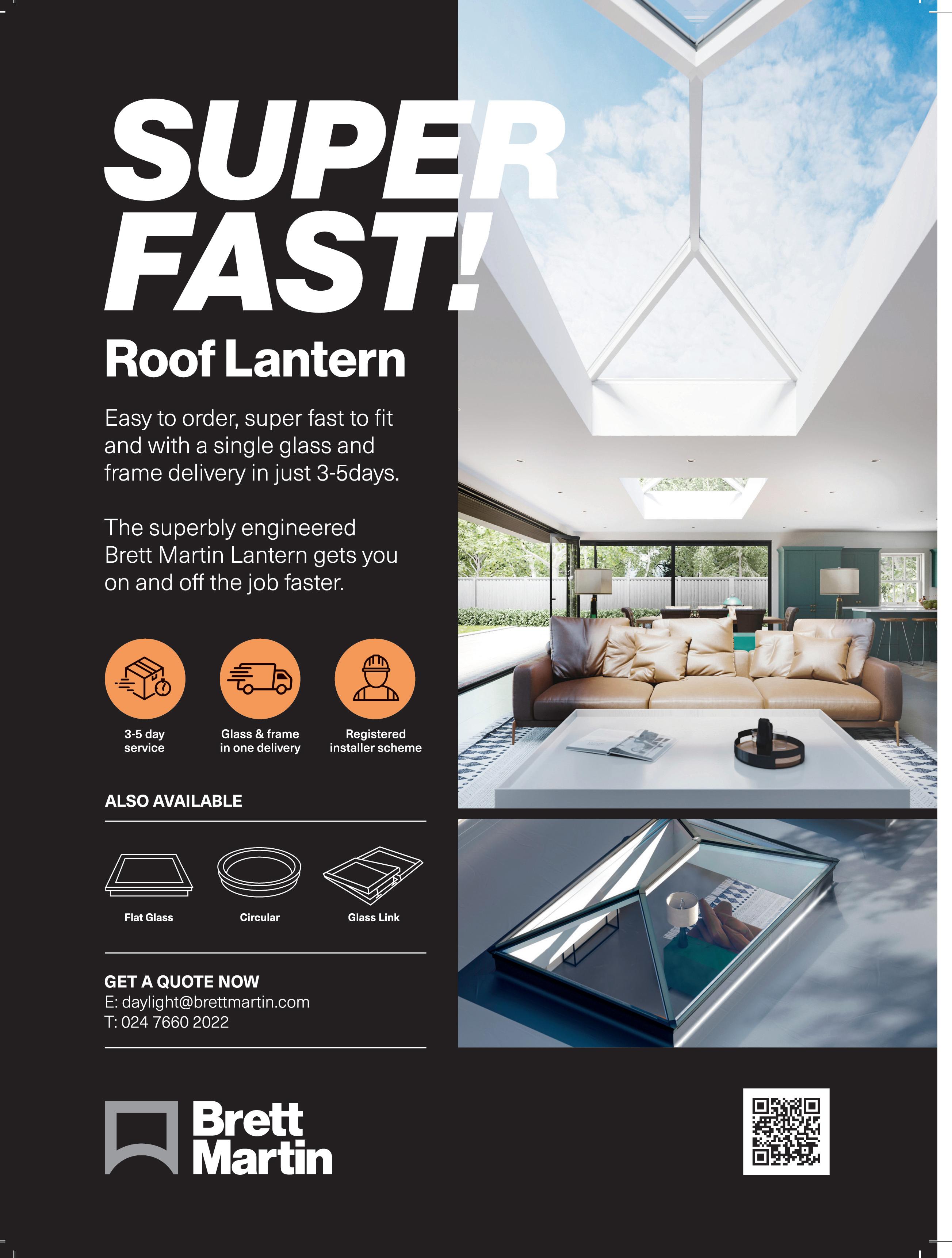
Total Average Net Distribution 131,640 July 2021 –June 2022
EDITOR
LEE JONES
EMAIL: ljones@hamerville.co.uk
EDITORIAL ASSISTANT
EDWARD KELLY
EMAIL: ekelly@hamerville.co.uk
GROUP ADVERTISEMENT MANAGER
CRAIG JOWSEY
TEL: 07900 248102
EMAIL: craig@hamerville.co.uk
NORTHERN ADVERTISEMENT MANAGER

IAN DUFF
MOBILE: 07810 353525
EMAIL: probuilder@sky.com
GRAPHIC DESIGNER
DONNA BOOTH
GROUP PRODUCTION MANAGER
CAROL PADGETT
DIGITAL MANAGER
JASMINE SMITH
EMAIL: jsmith@hamerville.co.uk
DIGITAL ASSISTANT
LYDIA MCFARLANE
EMAIL: lmcfarlane@hamerville.co.uk
DISTRIBUTION MANAGER
KARL CLARK
PRINTED BY
PCP TELFORD
PUBLISHED BY
HAMERVILLE MEDIA GROUP

Regal House, Regal Way, Watford, Herts WD24 4YF
Tel: (01923) 237799
Fax: (01923) 246901
Email: pb@hamerville.co.uk
If the pandemic taught us anything it’s that we are social creatures, and when basic levels of human interaction are denied us it can have a serious impact on our wellbeing. That’s not to say that digital channels of communication are not of equally vital importance either – and covid-19 certainly accelerated their adoption – but there is a balance to be struck, and it’s becoming increasingly apparent that builders are finding it.
A recent report from NBG, a major buying group for independent merchants, included the results of a survey of UK tradespeople. The research found that 92 per cent of trade sales continue to be made over the counter. Not only that, but digital tools are more often than not used to support and complement those inperson sales rather than replace them. Research on new products, price checking, videos, reviews and business administration are the online activities of choice, but buying is mostly still done at the builders’ merchants.
Professional Builder is a business magazine for firms and individuals involved in all aspects of the building industry. It is available nationally –free to the trade through leading builders’ merchant outlets. © 2023
To be removed from this magazine’s circulation, please call 01923 237799 or email circulation@hamerville.co.uk.
Subscriptions to Professional Builder are available at the following rates:
UK: 1 year (11 issues) –£30.00 post paid
Europe & Overseas: 1 year (11 issues) –
£50.00 post paid
Airmail: 1 year (11 issues) –
£65.00 post paid
There are a whole range of factors that still draw tradespeople to their local merchant, and those who make their living in the sector will be all too aware of them. Levels of customer service, product knowledge and advice are at much higher levels than you’ll find in other retail environments, and the best merchants work hard to ensure that their staff are well-informed when it comes to the available product range. Moreover, many builders may well be on site all day alone and in that context a trip to the merchants has a social element. Personal relationships can be forged, and builders can feel part of a wider community.
The primary motivating factors for consumer shopping online are
convenience and price. Whilst the latter will, of course, always be an important consideration for the trades as well it is often overridden by other factors. The local jobbing builder who generates new work on the basis of recommendation –and, as a consequence, is only as good as their last job – is far more concerned with quality, and suppliers that can provide solutions that won’t let them down are championed. Trust becomes a real issue, and that’s more likely to be established with face-to-face contact, not just with individuals but with a hands-on experience of building materials. As it has been for more than fifty years Professional Builder is, of course, still available at your local builders’ merchant trade counter. Like manufacturers and suppliers, however, we’ve worked hard to ensure that all the information, advice and support available in this and every other issue is available online and via email. Indeed, our publication is now accessible in any format or via any platform that our readers care to engage with. Whether print or digital –including our new podcasts and videos –the choice is for tradespeople to make. Similarly, it is a hybrid blend of physical and non-physical which distinguishes the builders’ merchant sector and satisfies the unique needs of trade buyers.
The spike in e-commerce that the pandemic precipitated is now well documented, and certainly saved many retail outlets from ruin. What is more intriguing in the construction industry is that almost as soon as tradespeople could get back to the builders’ merchant they did just that.
To read the report – Valuing Local Independent Trade Merchants in a Digital World – visit www.rdr.link/BAU89
“There are a whole range of factors that still draw tradespeople to their local merchant, and those who make their living in the sector will be all too aware of them, including higher levels of customer service and product knowledge”

There has been a rebound in repair, maintenance, and improvement (RMI) building work for the first three months of this year according to the latest State of Trade Survey from the Federation of Master Builders (FMB). Workloads are reported to be up by 12% compared to Q4 2022 and reported enquiries up 14% on the previous quarter too.


Brian Berry, Chief Executive of the FMB, said: “The rebound in domestic building work at the start of this year compared with the pessimistic forecasts towards the end of last year is an encouraging sign that parts of the building industry are bouncing back. It’s a positive sign for the overall economy

that homeowners are continuing to invest in their homes.”
FOR MORE DETAILS VISIT: WWW.RDR.LINK/BAU001
The Construction Leadership Council (CLC) welcomes the Government’s proposals to improve industry payment practices and cashflow.
The Government’s proposals were part of a consultation to address challenges within the current payment landscape and is part of a wider suite of SME focused legislative change. Key points that the CLC agreed with were the extension of current regulations on payment practices and cashflow beyond April 2024, a change in regulations to report on the total monetary value of payments as well as their volume, and that regulations should apply to clients too. The CLC is open to further policy change, provided it is proportionate.
FOR MORE DETAILS VISIT: WWW.RDR.LINK/BAU002
The Consumer Code for Home Builders will be strengthened to provide more comprehensive protection for new build home buyers following an independent review led by John Bridgeman CBE, former Director General of the Office of Fair Trading. The Review will result in the most significant enhancements since the Code was launched in 2010. These enhancements include broadening the scope to add customer pre-inspections, how ‘snagging’ issues are dealt with, and raising the maximum claim limit for complaints.
FOR MORE DETAILS VISIT: WWW.RDR.LINK/BAU003
Demand for heavy-side building materials improves in the first quarter
Producers of heavy-side building materials, including mineral products such as aggregates, asphalt and concrete, have recorded a much welcomed and broad-based rebound in demand, according to the Mineral Products Association (MPA) industry sales survey.

Sales volumes for ready-mixed concrete rose by 9.8%. Mortar sales were up by 6%, and primary aggregates –including crushed rock, sand and gravel –saw a 3.3% rise, according to the data.
New LCV market is on the right road again
Figures published by the Society of Motor Manufacturers and Traders (SMMT) show the UK new light commercial vehicle (LCV) market recorded its fourth straight month of growth with 22,665 new units registered in April. This was a 4.9% growth, regaining ground on prepandemic levels.

The largest volume growth was recorded for vans weighing greater than 2.0 to 2.5 tonnes, which more than doubled to reach 4,318 registrations.



FOR MORE DETAILS VISIT: WWW.RDR.LINK/BAU005


The Direct Line analysis shows that tools were stolen every 15 minutes in 2022 across the UK. There were 35,098 incidents of tool theft reported to police forces in the year, 55% of which from a vehicle. This is a 13 per cent increase in total incidents from 2021. Alison Traboulsi, Product Manager at Direct Line business insurance commented that this research highlights: “the importance of keeping tools secure, as well as having the correct insurance in place if theft does occur.”
FOR MORE DETAILS VISIT: WWW.RDR.LINK/BAU006
1% of green belt land could deliver 738,000 homes with a market value of £317.5bn
Research from Searchland shows the green belt across England currently covers an estimated 16.382bn square metres. With the average new-build plot requiring an estimated 222 square metres of space, 1% of the nation’s green belt could deliver an estimated 737,905 new homes.

Co-founder and CEO of Searchland, Mitchell Fasanya, commented on the misconceptions around green belt land: “The reality is that there is a great deal of green belt that simply isn’t classified correctly and the green belt itself is actually a buffer between urban sprawl and the countryside.”
FOR MORE DETAILS VISIT: WWW.RDR.LINK/BAU007
UK being flooded by illegal plumbing equipment, investigation finds
An investigation by Grundfos and the BPMA (British Pump Manufacturers Association) estimates that at least 10% of the annual one million UK sold circulator pumps carry fake CE labels. These falsely certified Far East imports can cost as little as a third of a real energy-efficient one but are nowhere near efficient enough and can end up costing buyers up to £110 a year in missed energy savings.
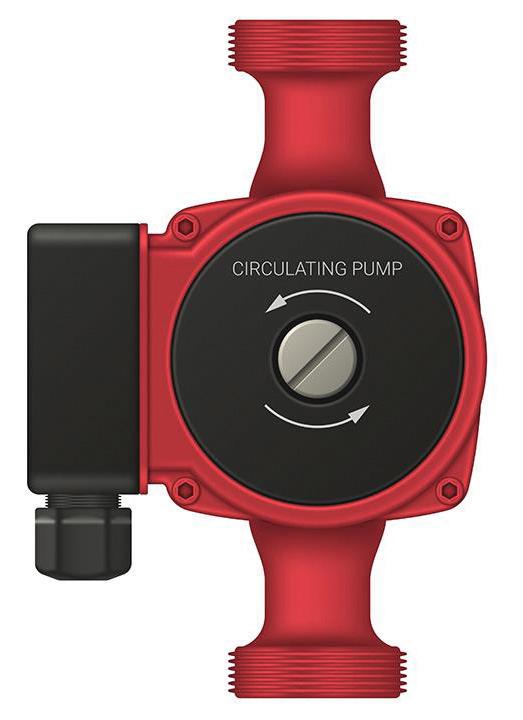
There are calls for the Government to clamp down on this with concerns for the job security of certified pump manufacturers being raised.

Failure to prevent life-threatening diseases caused by dust at work is unacceptable, says the Health and Safety Executive (HSE), as it continues its summer inspecting construction sites across Great Britain. The inspections will end in July and focus on respiratory risks from exposure to dust. They are supported by the Dust Kills campaign which offers free advice on dust exposure control measures. Each year in the construction industry, there are thousands of preventable cases of irreversible lung disease due to past exposure to dust at work.
FOR MORE DETAILS VISIT: WWW.RDR.LINK/BAU009
Keyfix shines a light on sun protection with an awareness campaign





A new study funded by the Institution of Occupational Safety and Health has found that, every year, there are more than 3,000 cases of skin cancer caused by working outside. With this in mind, Keyfix is using its Rays Awareness campaign to educate on the importance of sun protection for construction workers on building sites, who are particularly at risk from exposure. This includes tips on its website for staying protected, as well as a weekly Summer Song Quiz on its social media channels until the end of August with fantastic summer goody bags to win.
FOR MORE DETAILS VISIT: WWW.RDR.LINK/BAU010


The best time to submit your Self Assessment tax return is now HMRC are looking to convince self employed tradespeople to fill out their tax return sooner rather than later. Because filing early doesn’t change the payment deadline of January 31st, the main benefit to doing this is being able to plan ahead.

Tradespeople can know what they owe in taxes advance, budget accordingly and avoid the last minute stress. Those that do this early can also get tax refunds earlier if


Trades Business Support Solutions has announced the launch of its new business support SaaS, the Solo Explorer. Through individually tailored action lists, the online platform looks to help businesses reduce costs, simplify business processes, improve customer service and provide expansion support. It is designed specifically to help small trade businesses grow and reach their goals.
Lopay analysed the experiences of small construction firms across the UK and found that 50% ranked late payment as the greatest danger to their business. This ranked higher than any other factor. The research also revealed that 34% have refused

Impressed and inspired by the lifechanging work that the Band of Builders charity was doing for those in the construction sector living with illness and injury, V12 Footwear was determined to show its support. But it was equally determined to show it in a visible, memorable and high-impact way.
Developing a charity boot in collaboration with Band of Builders seemed like the perfect way to show this support. It represented V12’s passion for safety footwear and protecting people, but would also act as an instantly recognisable symbol of the charity and its work.
Collaborating with Band of Builders, in 2021, V12 launched the exclusive V2150 BoB safety boot. For every pair of the BoB boot sold, V12 donates £5 to the Band of Builders charity to support it in its mission to help those in the industry in their hour of need.
Incorporating V12’s 25-years of experience in safety footwear and working with those in the building trades, with its lighter construction, quicker and easier lacing system and enhanced comfort collar, the BoB boot truly was a boot built for builders.


In 2021, the BoB boot launched in collaboration with Band of Builders.
We launched with a photoshoot –featuring Band of Builders’ supporters.

V12’s social media campaigns make awareness of the BoB boot explode! Wearers were encouraged to share their support using the hashtag #tradelaces along with a photo of their boots at work and an influencer campaign asked tradespeople to send funny selfies whilst wearing the boot at work.
These online strategies have generated millions of impressions since the boot was launched.



The BoB boots came with a free pair of Band of Builders branded orange laces which have become a symbol of the charity and spread its brand awareness even further.
To show just how committed V12 is to spreading awareness of this charity, it bought a co-branded hot air balloon! It wanted to shout about Band of Builders and its work from the roof tops – and it certainly achieved it. The balloon has the Band of Builders logo emblazoned on it, and has become a much-loved and well-known sight, frequently

photographed and shared online.
V12 collaborated with Snapfeet, who developed an app letting people scan their foot size and try on footwear ‘virtually.’ Those interested in wearing the BoB boot can use this innovative foot scanning app for free.
In 2022, when a video for the BoB boot was shot, an actor who could do a somersault as part of the advert’s script was required. The star of the show was the son of one of the beneficiaries of a Band of Builders’ project.
V12 Footwear ended the first quarter of 2023 by donating over £10,000 to Band of Builders from selling over 2,000 pairs of BoB boots.



The BoB boot is available through builders’ merchants, so even more people across the country have greater access to a boot raising both levels of safety and money for the charity.

TO FIND OUT MORE ABOUT THE V12 BOB BOOT VISIT: WWW.RDR.LINK/BAU016
FOR MORE INFORMATION ON BAND OF BUILDERS VISIT: WWW.RDR.LINK/BAU017
V12 explains how its Band of Builders (BoB) boot was born and the story so far



This September will see one of the building industry’s biggest events make its return. The Federation of Master Builders (FMB) Master Builder Awards celebrates the sterling – and often otherwise unsung – work of SME construction firms. Before the national verdict is revealed, however, a host of regional winners are rewarded with a worthy FMB accolade, and amongst them is Pencil and Brick, who recently received recognition in the Large Renovation category in the London area.

“We’re trying to promote craft and the use of simple materials,” enthuses company Director, Seán McAlister about his award-winning work, “and I believe the Southwark refurb reflects that. So much of the detail and the skilled work that builders undertake is covered up when it should be on show.”
The Pencil and Brick property renovation was beside a railway line, and adjacent to a line of monumental Victorian arches. A Sir John Soane built church on the same street exhibited some beautiful 1820s examples of brick arch work and Seán choose to use the proximity of both those styles to his advantage by creating a design that reflected them. The result was the symmetry of arched joinery on the interior and arched brickwork on the exterior of the extension. Even before then, however, Pencil and Brick had to maintain the structural integrity of the property through stitching cracks, the use of concrete elbows and underpinning to the rear.
“We created a brick portico with two semi-circular brick arches. The chamfered brick details are different heights under each arch, which mirror the clients’ Becky and Dan’s shoulder heights, and the arch motif is carried into the kitchen with the bespoke joinery.”
The team designed –and had built by carpenters, Goldfinch –a large plywoodstructure extension to the kitchen. This separated the kitchen and dining areas, with an arched opening, and two concealed skylights to bring in light. Pencil and Brick was also commended for its consideration to neighbours and the local community, and its very satisfied clients were equally full of praise, describing them as “a respite in the storm of complexity that is project design and build. We would wholeheartedly recommend this excellent practice and both its brilliant principals and
whole team.”

The Brick Lane-based design and build firm has been trading for more than four years and operates across the north and east of the Capital. The company specialises in high end refurbishment work, with experienced experts on hand to guide their clients on the journey from drawing board to completed project. “As a qualified architect, as well as the project manager, I know that the homeowners really like having that one point of contact throughout the job. A large renovation can be a stressful experience for them, and I can be a reassuring presence.”
“Almost all our work now has a sustainability angle, and a degree of retrofit,” continues Sean, as he guides as around a job in Finsbury Park that exhibits just those attributes and will ultimately benefit from an air source heat pump, UFH (Underfloor heating) and external wall insulation. “Of course, you can’t do


what we’re undertaking on this property on every house, so a fabric first approach, by getting the insulation right, is the best way forward, and a real difference can be made regardless of budgets.”


In addition to his role with Pencil and Brick, Seán is an active member of the FMB, sitting on the organisation’s London Board as well as working on the Standards Committee. Seán explains his roles: “The board functions to represent the interests of members in that area. As an example, we recently communicated their concerns over the expansion of the ultra-low emission zone (ULEZ) to Transport for London representatives and suggested policy changes, including exempting builders and a longer timeframe for implementation.”
The Board also functions as a focus group for new ideas, as Sean reveals: “One idea we had was to develop an FMB App – which will allow communication between members to be easier and more collaborative – and that’s now been approved by the national organisation and
is being developed.”
“The Building Safety Act is another huge policy change that will affect our members and the industry at large and we have some construction insurance brokers and solicitors who are advising on the implications. No-one is really sure how that’s going to work in practice, so there’s lots of work to be done there.”
The Standards Committee exists to ensure that the code of conduct that


members have signed up to is adhered to in practice and is integral to the integrity of the trade association itself, as well as its wider mission to improve the industry’s image and that of builders.
“The FMB is an invaluable resource for time-poor tradespeople,” concludes Sean. “Whether it’s on legal or insurance issues, or in promoting the industry through its awards, there’s a lot of good work being done. Any reputable builder will applaud efforts to raise standards – as well as the reputation of the construction sector as a whole – and that’s exactly what the Federation of Master of Builders works to achieve. It’s also a great networking opportunity. Individual building firms can often operate in silos – without any direct contact between them – but the FMB can bring them together.”
FOR FURTHER INFORMATION ON PENCIL AND BRICK VISIT WWW.RDR.LINK/BAU018
FOR FURTHER INFORMATION ON THE FEDERATION OF MASTER BUILDERS (FMB) VISIT WWW.RDR.LINK/BAU019

Plasterer, Rachel Williams has enjoyed a highly distinguished career in women’s football and plans to return to a hawk and trowel when she’s hung up her boots. Professional Builder’s Lee Jones finds out more from the Red Devils forward.
Next time you’re struggling to get a job done on time spare a thought for Rachel Williams, star of the Women’s Super League (WSL) – and experienced plasterer. When the now Manchester United W.F.C. player was wearing a Birmingham shirt –and playing in the UEFA Women’s Champions’ League – she had to confess to her then coach that she couldn’t make the away fixture because she was needed on site.



“It was 2012 and we’d already won the FA Cup that year. It was only because the club agreed to fund what I would have lost in earnings plastering that I was able to make it – basically, they really wanted me to play.”
In fact, Rachel has balanced the demands of the building industry with the highest level of the women’s game for much of her career. “I started as a plasterer when I was 19, in around 2008,” recalls the 35-year-old, “and was initially just helping out my ex-partner, Matt, as a labourer. I’ve always been quite physical, so it was something I really enjoyed. Then, on a very hot day, the finish was going off so I set to work trowelling it up. He couldn’t really believe the job I’d done
and that’s when I started to learn the trade in earnest.”
Maintaining both roles would, however, require huge levels of commitment: “At the beginning of my career there was no prospect of making a living from football. I’d work on site all day, and train twice a week in the evenings, then play on a Sunday. When the Women’s Super League (WSL) was formed by the FA in 2011 that all changed, because we were training four days a week across two sessions – one in the gym and the other
on the pitch – plus the matchday.
“That meant I only had two days a week off from football, but I still used that time to undertake plastering jobs. A lot of the other girls thought I was mad and would tell me they just don’t know how I did it. As anyone who has done it can testify plastering is demanding physically on your body but I found it actually really helped with my training and conditioning and I was able to use it to my advantage.
“It did make for long days, though. When I was at Chelsea I’d finish at three, and my partner Matt would drive me and a teammate to the club’s Cobham facility. We wouldn’t get back until midnight and could
be up at four the next day for work.”
Whilst women’s football has gained mainstream recognition, female plasterers are still quite unusual today – and even more so when Rachel started as a spreader – so we asked her what attitudes she encountered on site? “I’ve had mixed reactions, to be honest. There were times when the homeowner thought I was Matt’s daughter and just there to help out for the day rather than a tradesperson in my own right. There was also one occasion when a chap refused to let me in. I told him that if he didn’t like what I did he could have the work for free. When he saw how good the job was, and how clean and tidy, he soon changed his mind. In fact, he made contact just a couple of months later with more work.”
“I’ve also had fellow builders who’ve been very supportive. Once you’ve shown you can do the job as well as anyone you’re almost always accepted. When they found out about the football they’d invariably like to chat about that as well.”
“Of course, as the game has progressed football is very much full time.

One of the consequences of that, however, is that I’m doing more work on the gym because I don’t have the baseline strength that I got from plastering, and if I could still ply my trade I would. Having said that I do keep my hand in by helping out friends, teammates and family. I’m at a stage of my career now when I only play when needed,” Rachel admits, “and I’m also thinking about what I’ll do when I finish. The building industry is definitely something I’d like to go back to, and the PFA do run courses for ex-players who want to retrain, so I’m considering other trades as well.”
The last couple of years have seen a seismic transformation in women’s professional football, as Rachel reveals: “The standard today is on another level from when I started. The analysis, and the focus on technique and tactics, means girls are actually learning about the game as well as just playing. There has to be a balance, of course, because you don’t want to detract from the enjoyment. I

have always played football because I loved it and there have been so many professional highlights including the FA Cup triumph in 2012, and this season’s run with Manchester Utd that saw us come so close to toppling reigning champions Chelsea. By contrast I’ve lost the league twice on the final day and suffered defeat in the 2023 Cup Final.”
Whilst the female game is making huge leaps forward, sadly, women are still woefully under-represented in the building trades, but Rachel firmly believes that it doesn’t have to be that way. “I fell into it because of the relationship I was in, but more could be done to convince new entrants that it’s not just a man’s job. In the same way that football’s for everyone, so should any profession, and I would encourage any woman to have a go. There’s no doubt more needs to be done to demonstrate the positive side of it to young girls in particular.”

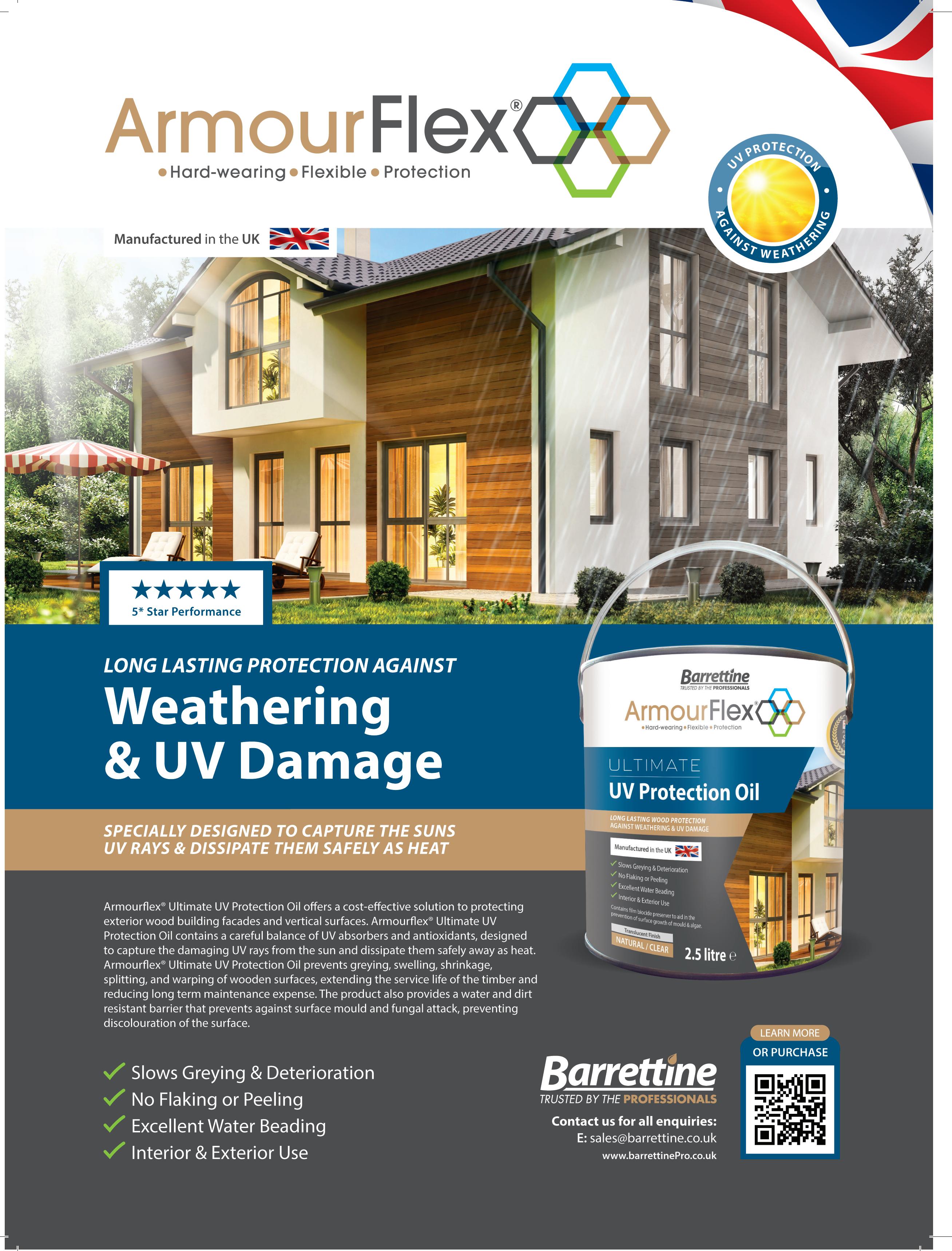
We give our verdict on new products in our unique site tests, but now we want to give you the chance to try them – AND KEEP THEM – for yourself! All you have to do to enter the free draws is simply just type in www.rdr.link followed by the unique code.





66
An InSinkErator food waste disposer provides a hygienic method to dispose of inedible food waste down the sink. The unit connects to standard plumbing, is designed to fit easily under all sinks and simply needs an electrical connection. All the components required, information outlining the installation criteria and a check list are also supplied. To enter simply use the rdr.link below where you’ll also find some additional T&Cs

FOR YOUR CHANCE TO WIN VISIT: WWW.RDR.LINK/BAU021
MCR SAFETY
OLBA
Win hand protection for your team! The winner will receive 12 pairs of these multipurpose work gloves from Tornado (powered by MCR Safety).

Olba is lightweight and comfortable with excellent grip and dexterity and is highly abrasionresistant.
It could be glove at first sight with 12 pairs for one lucky winner to give a helping hand to their team.
FOR YOUR CHANCE TO WIN VISIT: WWW.RDR.LINK/BAU023
ESTWING
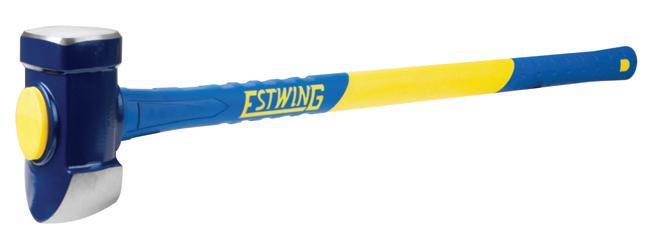

SCRUFFS
WORKER T-SHIRT, NAVY Work hard and play hard with the Scruffs Worker T-Shirt. Made from a stretch, easycare fabric for all-day comfort, the slim-fit silhouette is both stylish and practical. And the longer length body ensures you won’t reveal too much while you’re in action – both on and off-site. Don’t sweat this summer – use the rdr.link below to enter and the chance to win a t-shirt!
FOR YOUR CHANCE TO WIN VISIT:
10LB DEMOLITION HAMMERS
The Estwing 10lb Demolition Hammer is forged from alloy steel with a uniquely shaped head and is induction case hardened to withstand repeated impacts. It is fitted with a 36” ergonomic fibreglass shaft which is light, strong and will not rot or warp. The handle features a textured rubber overlay to ensure a comfortable and secure grip which helps to dampen vibrations during use. It’s hammer time in our great “Freefor-All” giveaways. Three of these Estwing hammers must be won.
FOR YOUR CHANCE TO WIN VISIT: WWW.RDR.LINK/BAU024
PRO
The Stabila Pro Set 80 AS – in standard lengths of 120cm, 60cm and 30cm –will ensure that you’re perfectly equipped for your projects. The vial installation technology guarantees long-term accuracy and a long service life. The integrated slipstoppers ensure that the spirit level is seated firmly during marking, and the sturdy case keeps your tools well protected during transportation. Find your level on site with these three professional tools.

FOR YOUR CHANCE TO WIN VISIT: WWW.RDR.LINK/BAU025
www.rdr.link/BAU026
Easy to Enter! It’s now easier than ever before to enter the competitions on our website. We’ve collected all the competitions on one handy page, meaning you only have to enter your details once!
We set up East Coasts Group in 2015. I’m an electrician by trade but after a while I wanted to do something different. I started doing general building and converted an outbuilding into two holiday apartments for some customers called Chris and Diane. We struck up a great relationship and, after the job was complete, we thought “why don’t we do this again?” and East Coasts was born.
We’re a small developer working mostly on new builds in the coastal areas of Suffolk. Typically, we buy the land, build the home and then sell it on. However, as I’m sure other builders-


turned-developers are finding right now, land prices have gone up so much that we’re doing more custom build-type projects where customers buy the land and work with us to build their property.
When I first made the move from electrics to general building –and for some years after –I was estimating projects myself. While I’d plan a job in stages, I would easily spend at least a full day working out materials needed, costing them and trying to build some sort of schedule.
I’d then have to repeat that at different stages of the build, as well as make sure we had what we needed on site, ordering
it from the merchant, etc. And usually, we have two builds on the go at once, so it was double the work at the same time.
Doing it all myself was taking me away from running the sites and when any of the team were off or ill, for example, I couldn’t just jump on the tools, and I would need to pay for extra labour.
I heard about Build Aviator from my merchant, and thought I’d give it a try. I’ve
used the company’s estimating services over 20 times now. It basically involves me giving them the plans for the project and then I have a chat with Ian Stacey our estimator and he does the rest. I get back a report for me which has a bill of quantities, build schedule and costs, which are personalised to our labour rates and terms.
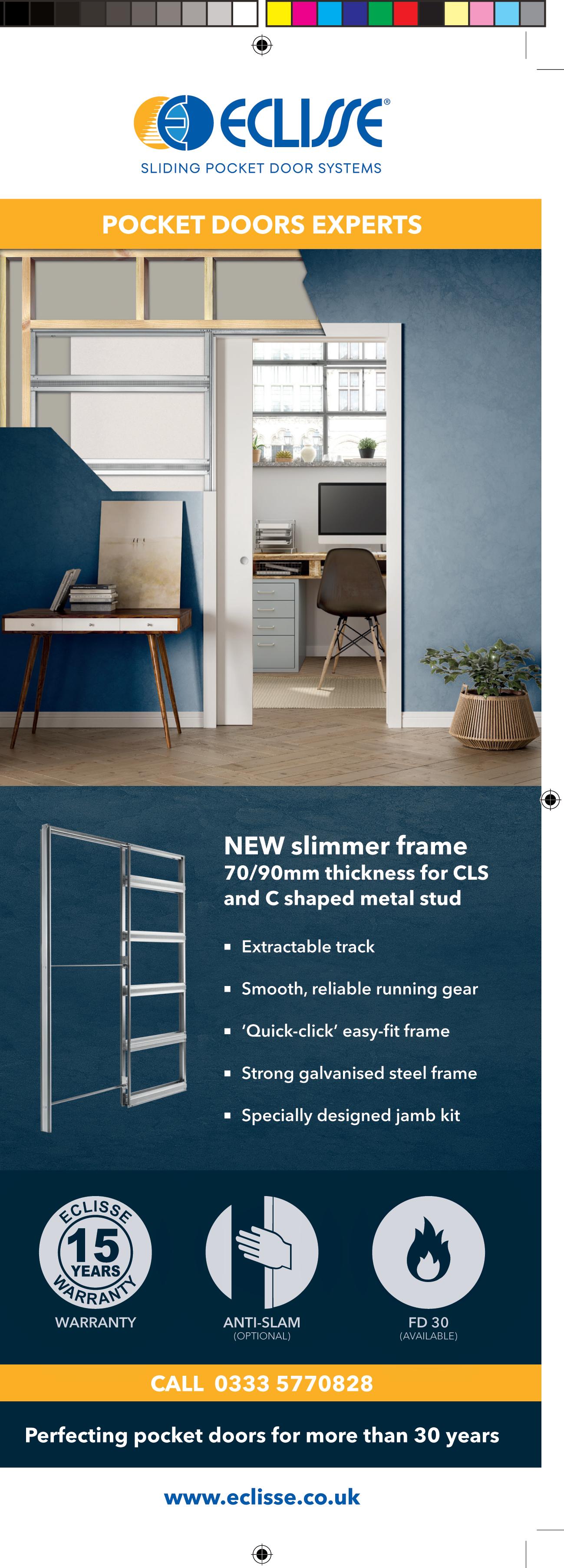
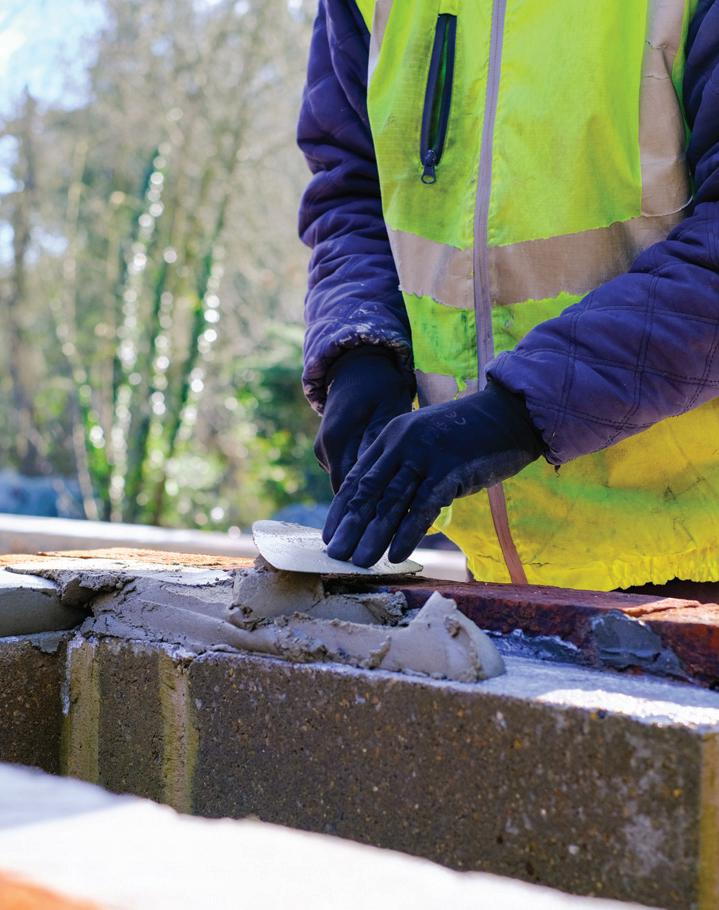

I also get a customer report with less detail, but has a breakdown of costs, invoicing schedule and timelines. We’re now a Build Aviator Business class customer too so we get a report with our branding that looks really impressive. Now we’re doing more customer-facing projects, it’s great to take this report, sit down with the customer and talk through the timescales and costs. It really helps with the relationship and having good communication.
Where Build Aviator has really made the difference is time and accuracy. I can now focus on running our sites and business or being on the tools if I need to be. I don’t need to be estimating the next job or scheduling materials because our local branch has a copy of the report too and knows where we are on the job so can order what we need on time and in advance.
That was particularly helpful when materials were in short supply as the merchant had a much better idea of lead times than us. While lead times have got a lot better recently, I’m sure other builders are still finding that prices are up and down. Build Aviator helps here too because the reports are based on live material prices. They also have a service called Profit Check where they’ll re-run our original estimate when we start the job. We get a document back that shows any changes in prices line-by-line and then can update the customer or be aware of it in terms of our profits. We’re much more in control.
We now use Build Aviator on every project and have recently used the services for a two-bedroom bungalow we’re building for a customer in Woodbridge. We started on site in December and we finished at the end of May. The estimating service helped it all go really smoothly and efficiently for us and our customer, which is exactly what you want on a job.
In part two of our feature, AllCover Insurance explores the essential coverage for the trades.


QI’ve told my insurance company I’m a builder, surely this covers me to do anything?
A. Be very careful! Nowadays you need to tell your insurance company everything you do in isolation, from bathroom fitting to property maintenance to fencing. There are so many different occupations, you need to inform your broker or insurance company exactly what you do. Saying you are a builder is considered too much of a generalisation and won’t necessarily cover you, for example, to fit a bathroom or repair a flat roof.
As a further example, property maintenance has emerged as its own category over the past few years, so if you could ‘just repair a roof ‘, ‘fix a wall’, ‘repair a leaking tap’, check that your policy covers you to carry out this type of work.
QAre there any other terms I should look out for within my insurance policy?
A. As an example, some insurers may apply percentage restrictions on what you can do, for example they might say you can do up to 15% painting and decorating, or 10% roof work, while others will only cover you for specific types of work you have disclosed to them. Be aware of your
such as “private dwellings, shops, offices, hotels only”. Read it word for word. For example, work carried out in schools, hospitals or factories may not be insured, or blocks of flats over a certain height may be excluded. Know your policy limitations and cover before it is too late.
QWhat should my level of cover be?
A. Public liability cover is generally available for a minimum indemnity limit of £1,000,000, although limits of £2,000,000, £5,000,000 and £10,000,000 are also readily available. Whilst it sounds a lot, £1,000,000 is likely to be insufficient these days, with £2,000,000 or £5,000,000 becoming more accepted as the minimum level of cover required. Again, it depends on your circumstances and the type of work carried out.
QAre there any additional policies or covers I should consider?
A. Commercial legal expenses can prove to be a very valuable cover extension. For a sole trader, this can cost as little as £52.00 a year, and even for a limited company or partnership with a wage roll up to £499,000 it could cost as little as £89.00. Apart from providing access to
helplines for legal & tax advice, the policy can cover employment protection and compensation awards, tax protection, legal defence costs from business related prosecution, contract and debt recovery. This is an extremely valuable policy to have and could end up saving you an awful lot of time, money and worry.

Know your insurance policy!
Despite many beliefs, insurance does not cover everything that goes wrong! Every policy will have conditions/ restrictions and endorsements. Whilst this may look like too much hard work, take the time to read your documentation. It can be the difference between being covered or not. Make sure it covers you at the premises you work at and for the work you do.
To have a proper break, where trade business owners can really kick back and relax, hinges on a little bit of planning. You can do just that by ticking off the five steps in this action plan before you jet off to the beach.


If you know you’ve got enough cash in hand to cover time away, then chances are you’ll be in a position where you can switch off, slow down and enjoy the holidays.
If you have a few staff, it’s amazing how much summer holidays can cost you. Think about paying staff and any other commitments. The best thing to do is contact your accountant or payroll person and ask them to work it out for you well in advance of holiday season. If you know what you need, you won’t get caught short.
While you’re sorting out your wage obligations, work out what you need to fork out for all your tax bills, like VAT, too. There’s nothing worse than holding off until tax deadlines hit and then not having the cash to pay up.

While making sure all of your invoices are out the door is critical before you sign off for the summer break, actually collecting the money is what matters. You need to know whether you’ll be paid on time or not, so if you haven’t started calling your customers, do it as soon as possible. It’s likely your customers will be planning a summer holiday as well, so ask for clarity around when you can anticipate receiving payment. If you don’t have the time to call customers who owe you money, rope in a
family member, friend or contractor to make the calls for you.
3
Everyone needs to take a break, and while customers will be putting pressure on you to get things finished before you leave, it’s unlikely you’ll close all your jobs out. With this in mind, you’ll need to clearly communicate your holiday plans to staff and customers to manage expectations and avoid disappointment. Customers will want to know any closure dates, as well as whether anyone from your team will be available for emergency call-outs (and how they can get in touch). As a bare minimum, change your voicemail recording and set up your out-of-office or holiday reminders on your email account.
There’s a chance some trades businesses won’t be in the position to take a long summer break. If this is you, you may consider a shorter break so you can bridge any cash gaps. With much of the competition potentially going on holiday too, you may be able to win new customers by fulfilling emergency work. Another potential avenue for income could come from approaching larger
companies in need of maintenance while their own offices/ factories/warehouses are unoccupied.

Don’t leave your finances or your holiday spirit to chance! Make that call to your accountant now, or just do it yourself and put the plans in place. Consider job management software like Fergus, which can really help you plan properly and get your business humming, even when you are on your holidays. Find out what your financial obligations are and make a plan from there. When you’re kicking-back, you’ll be glad you did.
Lee Halstead, Technical Sales Engineer at RWC, provides useful examples of how products from JG Speedfit can revolutionise installations for kitchens and bathrooms.
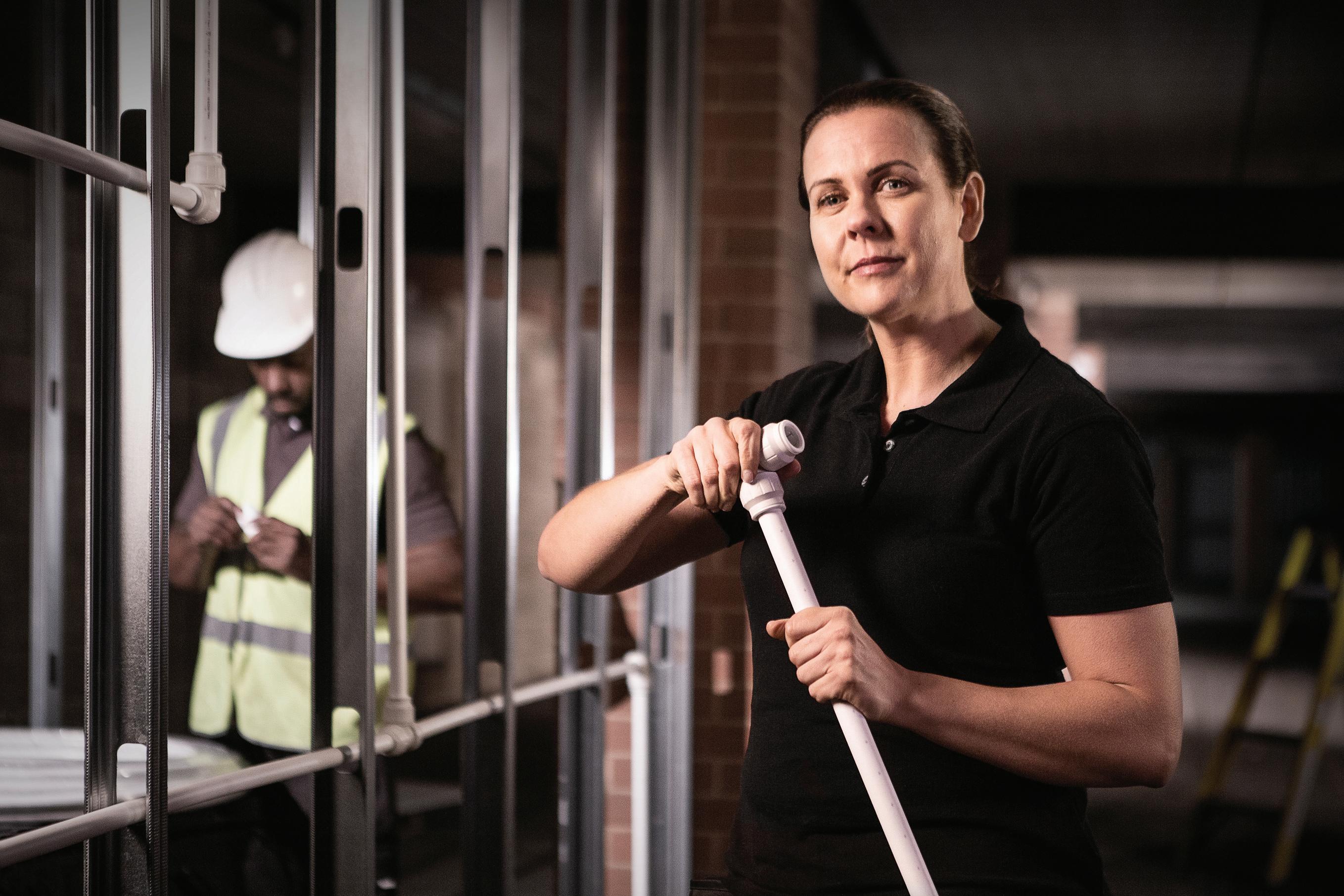
If we think about modern kitchens, simply fitting appliances is getting increasingly more complex. The number of appliances seen as standard is higher than ever before, especially in new-builds and retrofit projects. But the amount of space available to fit them all is slowly but surely decreasing, too. Newer kitchen trends, such as instant hot water taps and larger fridge freezers with water coolers, only add to the existing mesh of pipework stemming from the dishwasher, washing machine and sink.
In modern bathrooms, hiding all of the pipework in wall cavities poses the same issue. Indeed, even an experienced contortionist would find it difficult to use tools in these kinds of situations, which is where plastic push-fit fittings can be a real lifesaver.
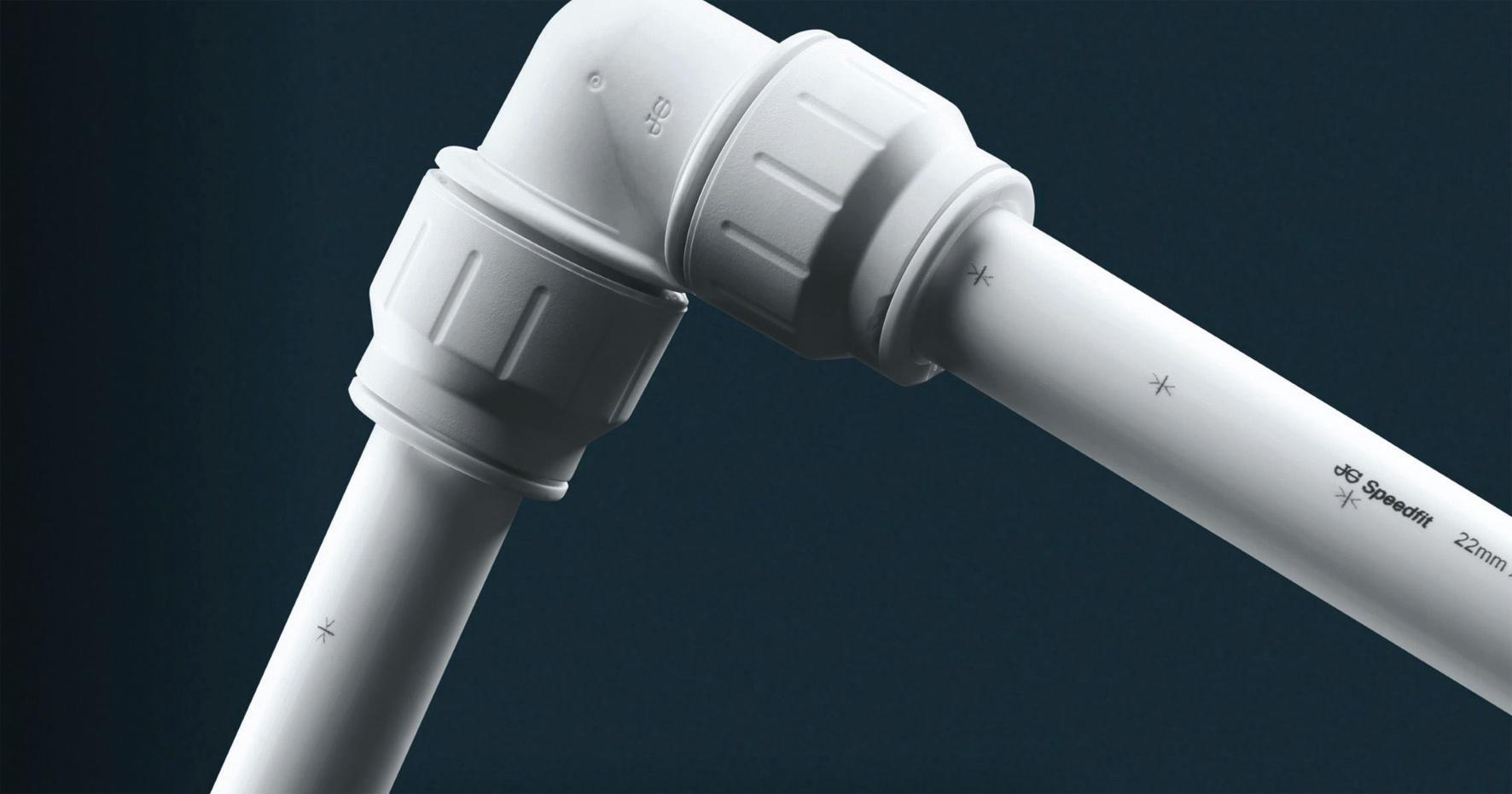
Connections are made by simply pushing the pipe end into the fitting, without the need for any tools. The JG Layflat pipe from JG Speedfit, is available in long length coils and can bend and flex
behind the cabinets to enable a fast and easy connection to appliances. From elbows to tees to service valves and flexi hoses and more, JG Speedfit push-fit products help simplify installations under the kitchen sink, behind the cabinets and

backflow protection valves must be installed on the kitchen’s main water supply to comply with water regulations. This is because a variety of fixtures and equipment, including kitchen sink taps, washing machines, and dishwashers, as well as outdoor hosepipes, can cause backflow. Wastewater from these areas can include everything from cleaning agents to stagnant water from garden pools, all of which may pose a major health risk if they were to enter the mains water supply.
A type of backflow prevention valve, such as a JG Speedfit Double Check Valve, should be installed on the outlets of appliances that provide a higher risk of back-siphonage to offer appropriate protection from backflow. This valve has two internal valves for added safety and only allows water to flow in one direction. Even if one fails, the other can still stop backflow and contamination.

With smaller spaces in mind, having another set of valves to fit presents an additional challenge for installers. So, to enable faster installation of backflow prevention valves, the JG Speedfit push-fit double check valve is easy to install, as no tools are required. Additionally, a push-fit double check service valve with an integrated water isolation feature is provided. This 2-in-1 valve offers extra advantages by making repair and maintenance work faster and simpler too.

While some people do like the industrial look of exposed pipework in their bathroom, or even their kitchen, it is more of a niche style than a mainstream one. In most cases, pipes that connect to showers and sinks, need to be hidden behind walls, under floors, or beneath free-standing fixtures.
Soldered copper pipes give the ideal look for exposed pipework. However, when this is not the preferred aesthetic, these pipes and fittings are simply too rigid to easily conceal them behind walls without expending more time and effort than you should. Flexible polybutylene
pipes are a perfect solution that can be easily cabled through joists, behind walls, or fixtures.
Pipes such as the PEX and polybutylene pipes from JG Speedfit, can bend and flex around tight spaces, which make them the natural solution for those type of installations, whilst minimising the need for joints, too.

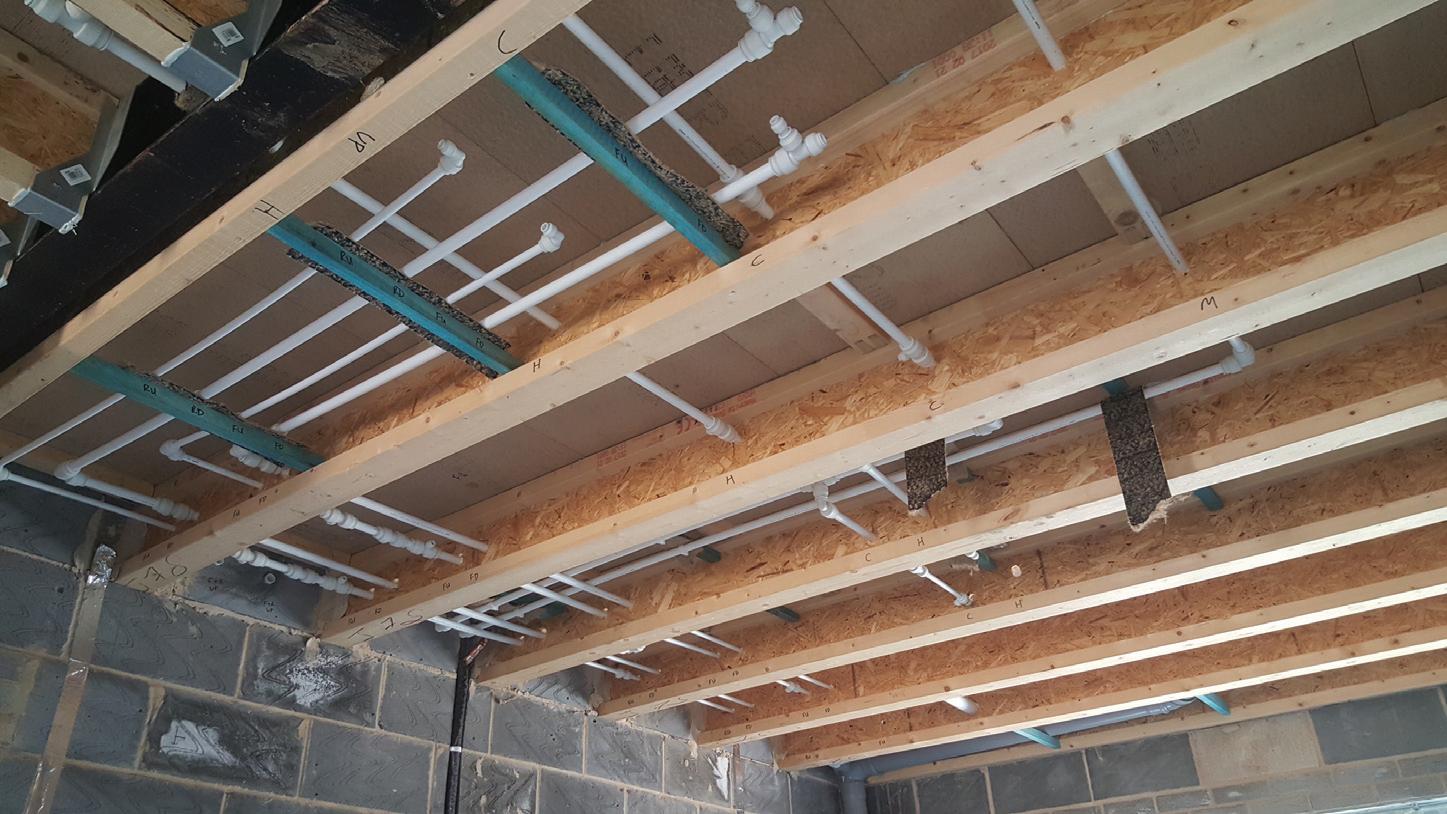
Twist and lock
kit. The fittings primary O-Ring seal and Grip & Seal collet with stainless steel teeth mean that each piece in the Twist & Lock range creates a quick push-fit connection that can be swiftly mounted and dismounted, in a flame- and tool-free manner. The push-fit fitting’s primary ORing when combined with the JG Speedfit Superseal Pipe Insert, which feature twin O-Rings, also create a unique multi seal.
The fittings’ non-toxic polybutylene construction makes them durable and watertight, while preventing the need for maintenance. This material is also resistant to corrosion and scale accumulation, which makes for an allaround more ecologically responsible plumbing solution. Furthermore, the fittings come in a number of bends, including straight, tee, and equal elbow connections, meaning the perfect kitchen or bathroom can be fitted easily from every angle.
Compact spaces can make installations more complex and slow down project completion times. For installers it pays to remember to work smarter and not harder.
Having a selection of smart products such as push-fit pipes, valves, and fittings from the JG Speedfit range can make delivering a contemporary kitchen or bathroom a much easier and quicker affair.
TO LEARN MORE ABOUT JG SPEEDFIT IN KITCHENS AND BATHROOMS USE THE RDR.LINK BELOW WWW.RDR.LINK/BAU030

Portugal was the setting for a major occasion in the kitchens & bathrooms sector with the Grohe X Professional Event. PB’s Lee Jones reports on some of the highlights
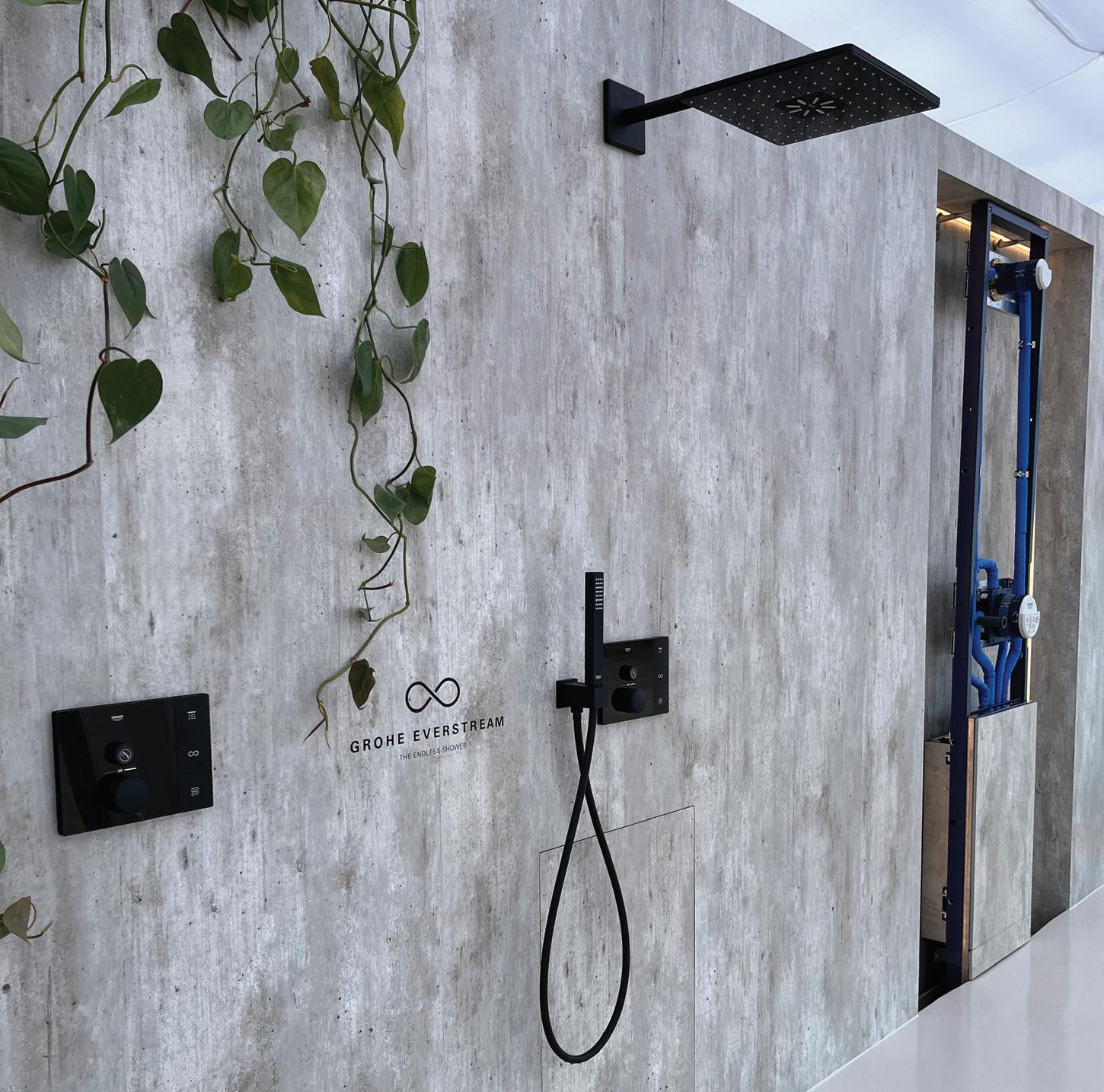
As a manufacturer, Grohe prides itself on a portfolio that comes together as a complete solution for the two most important rooms in the home. The breadth of that range – and some of the latest innovations – were recently revealed to visitors at the Grohe Experience Centre in Lisbon, and its Albergaria plant. It is at the latter where the company’s commitment to quality is dramatically demonstrated, with a production line that takes command of the whole process of producing thermostatic showers, kitchen products and thermostats.
The plant produces more than 7,000 tonnes of molten brass every year, for example. The copper and zinc derived alloy is then moulded, cut and painstakingly ground and polished to the most professional finish possible. An advanced PVD (Physical Vapour Deposition) process that was originally developed by the aerospace industry produces the nine options in the Grohe Colours Collection, which are all available across the tap, shower, thermostat and flush plates offerings. The technique provides a highly durable surface and is at the cutting edge of thin film coating technology. Indeed, PVD results in finishes three times harder and ten times more scratch-resistant than galvanised alternatives, while the process also allows the company to deliver on a broader range of colours.
That theme of innovation was continued at the highly instructive brand
space in Lisbon. It is here that the latest Grohe developments were showcased, including a Phantom Black colour that will represent a tenth choice for customers. This sleek, matt black finish benefits from a three-layer lacquer coating process which makes these products far more hard-wearing than their powder-coated counterparts – and more resistant to visible fingermarks.
The Grohe Professional range encompasses over 700 products, which will soon be joined by one of the stars of
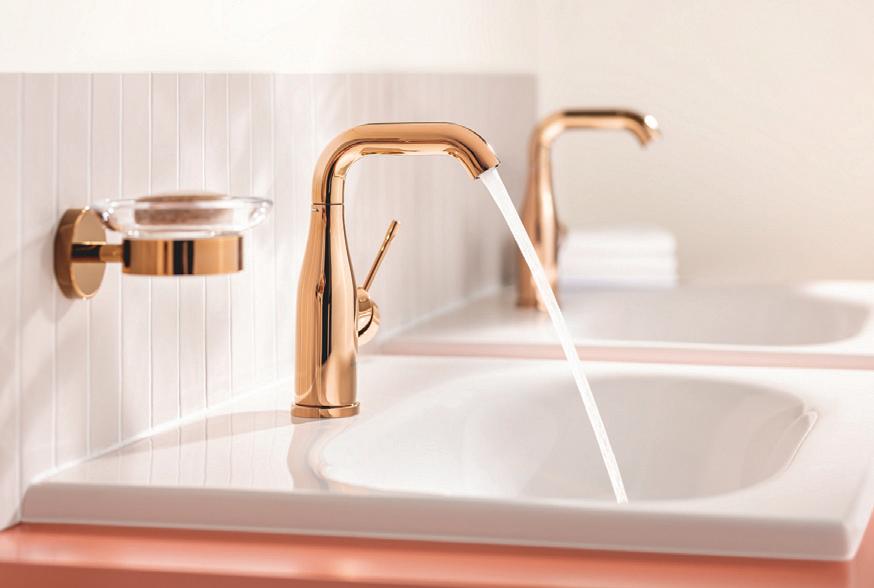
the Lisbon show – the Everstream waterrecirculating shower. It is estimated that by 2030 more than 3billion people around the globe will not have access to adequate amounts of water, and even in the relatively rain-soaked UK climate drought conditions could cause regular shortages. That makes conservation a priority, including a rethink of our showering habits.
The Grohe Everstream unit has three settings, with the fresh water function the first to be activated. The recirculating mode is then engaged when the second infinity symbol marked control is pressed – and here comes the clever bit. From that point 4 litres of water is collected in a tank, and is then recirculated three times every minute. Each time, the water passes a UV lamp, which kills germs and bacteria. A filter removes any other material, such

as hair and other particulates, and a reheater maintains the temperature set by the end user.
The third of that trio of buttons allows you to refresh the shower with a new 4litres of water at any time. Once you’ve finished, the system is automatically flushed with clean water, and a pump also blows air through the pipes – all ready for the next occupant. At no stage is there any detriment to the showering experience, but there is a very positive impact on individual sustainability.
Given that a conventional shower will use around 10 litres of water a minute, the savings are considerable. In fact, the manufacturer claims that existing water consumption through showering can be reduced by over 70 per cent. Moreover, because the reheater uses only 3kW of energy to bring the water temperature up to the required level, there’s further savings to be made. Installation is no different to other Grohe showers currently on the market, the filter can be cleaned in a dishwasher and, depending on levels of usage, the UV lamp has a working life of around seven years.
Other product highlights include the Grohe Tempesta hand shower, which features a simple switch function to activate different sprays at the touch of a fingertip, and the new softedged BauEdge ceramics, among others.
Support for the trades
Grohe is also committed to supporting tradespeople. The Professional sub-brand in the portfolio includes some of its most popular lines, backed up by service and training initiatives, and with the promise of an easy installation. In addition, the Perfect

Match design commitment allows installers to adopt a holistic approach to a project, where products can be effortlessly brought together to complement each other, and upselling opportunities more easily communicated to clients.
As well as supporting individual installers the German-based firm is committed to confronting one of the industry’s most pressing issues. Its GIVE (Grohe Installer Vocational Training and Education) programme has the worthy ambition of nurturing the next generation of plumbers. The manufacturer is supplying each participating institution across the EMENA (Europe, Middle East, North Africa) region, a fully functioning training space and a comprehensive case of essential tools free of charge, as well as helping to find new entrants to the industry valuable

work experience. The first college in the UK to get involved is the Colchester Institute, with more to follow.
Finally, the new GROHE+ loyalty scheme and app allows installers to more easily access technical expertise, installation techniques and maintenance training. Moreover, a certified GROHE installer can offer clients an extended warranty whilst tradespeople can also acquire customer leads through the Grohe website. Currently, GROHE+ is available in France, Belgium, and the Netherlands only with the view to expand it across other markets such as the UK.

“Grohe is committed to supporting tradespeople. The Professional subbrand in the portfolio includes some its most popular lines, backed up by service and training initiatives, and with the promise of an easy installation process”

According to the Energy Saving Trust, bathroom showers, toilets, baths and washbasins consume more than two-thirds (68%) of household water. This makes the bathroom the ideal place to start when trying to reduce water usage. With that in mind, here are our top tips for builders looking to incorporate water-saving products into their development:
It’s estimated that an average household uses more than 33 litres of water from flushing every day, so introducing dual flush technology is the most effective way to reduce water consumption. Manufacturers are increasingly producing dual flush plates, which have the added functionality of a ‘low’ flush option, reducing water usage even further with every flush.
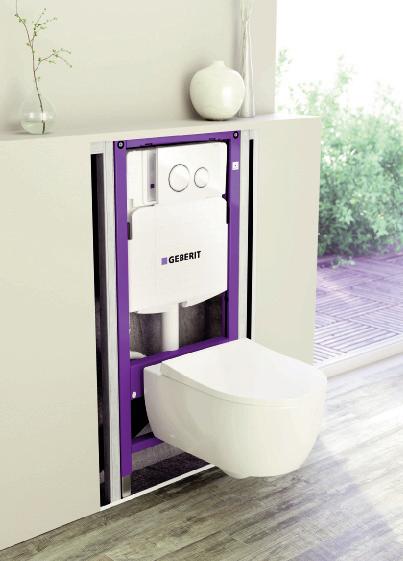
However, water-saving cisterns are only the first step. Maintenance and upkeep are essential. The integrity of washers in valves and flat rubber seals can degrade over years of usage so remind your customers to check their WCs for running water in the bowl when the toilet has not been flushed. In fact, water charity Water Wise estimates that between five and eight per cent of UK households have appliances which leak due to lack of maintenance, particularly the WC.
At Geberit, we believe that sustainability starts with design and, therefore, consider this in every product we create, because even small changes in the bathroom can have a significant impact on a property’s water consumption. For instance, brassware with built-in watersaving technology offers better control of water usage.

Infrared taps that are proximityactivated eliminate the risk of accidentally leaving the water flowing. Taps fitted with this technology will usually halt the water
even for the briefest of absences, such as when brushing teeth.
Showers and baths that save
To reduce water usage in the shower without compromising on performance, tradespeople should consider fitting showers with a regulator or aerator. An aerator combines air with water to give the feeling of power while regulators place an upper limit on flow rates.
Despite a shower using less water than a bath, people still like the choice. Manufacturers are continuing to develop
space-saving tubs with a lower water capacity, providing the perfect option for saving water while still enjoying the occasional soak.

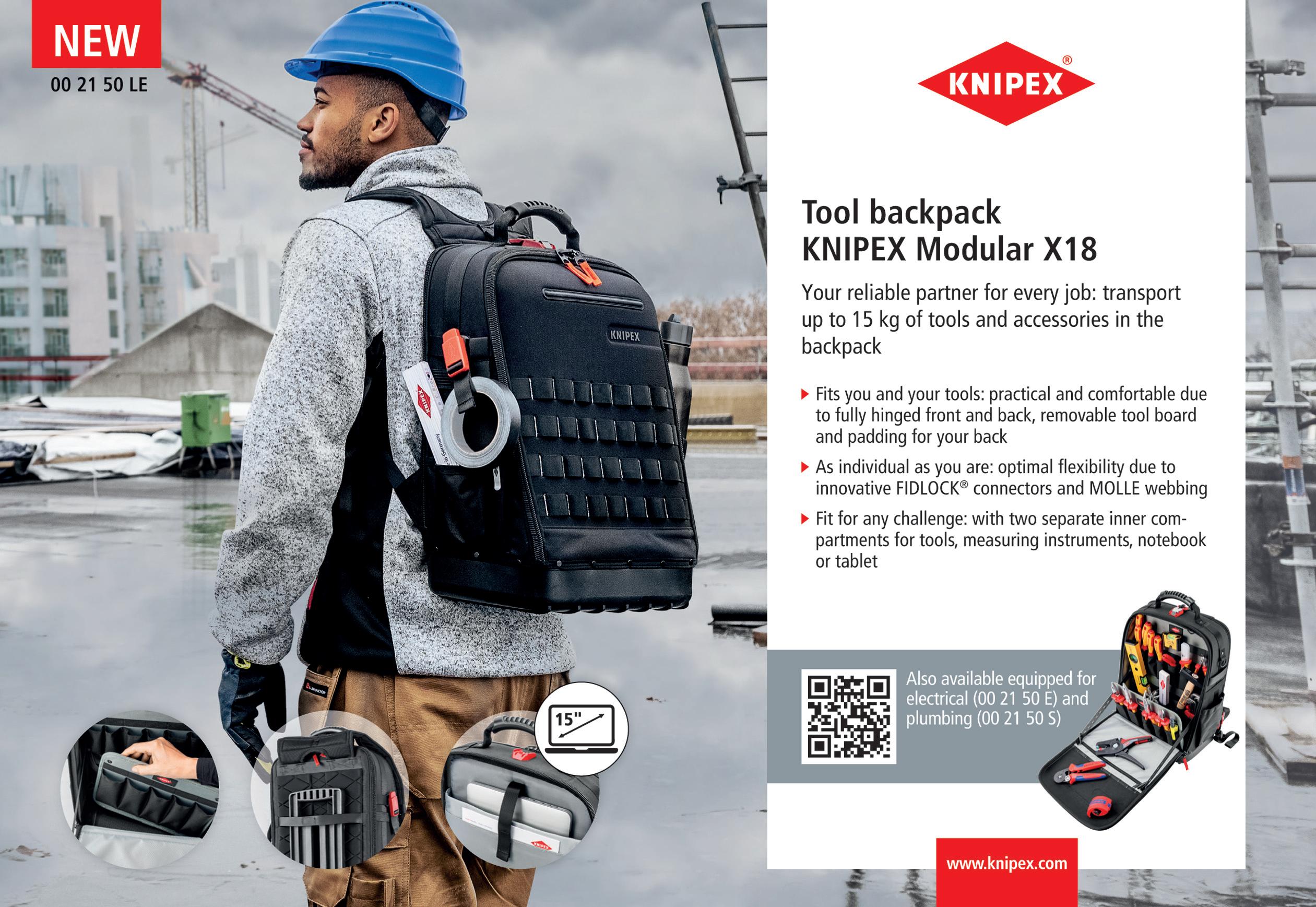
Water saving in homes is important. However, projects with higher footfall areas are just as essential in the bid to tackle water wastage. For commercial washroom projects, specifying the right urinal system can offer real water-saving opportunities. Manufacturers are now incorporating innovations such as different operation modes, with associated low operation and maintenance costs. For example, Geberit manufactures an integrated urinal flush control which can be operated using three power supply variants, while flushing out the urinal ceramic appliance with 0.5 litres per flush.
decreased when user frequency increases – so, for instance, the pre-set flush time is halved when another user approaches the urinal within one minute after the most recent flushing. Flow rate can also be reduced by changing the duration of the flush.
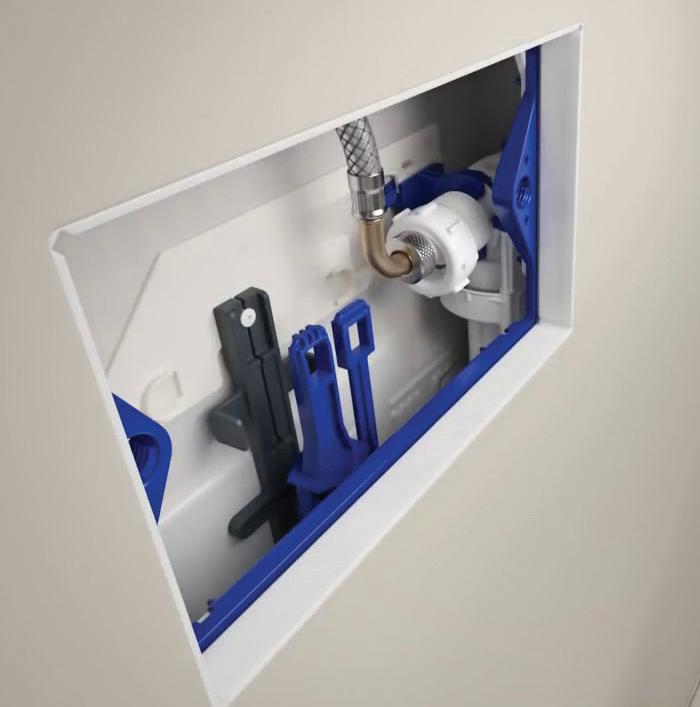
“According to the Energy Saving Trust, bathroom showers, toilets, baths and washbasins consume more than two thirds of household water, making

3RD IN A NEW SERIES
Choosing a cordless plunge saw will eliminate the need for power cables and provide greater flexibility and freedom, especially when working with large sheet materials. Advancements in battery and tool technologies mean that there are now cordless options available that match the power and performance of corded alternatives. For example, tools from the Makita 40VMax XGT range, such as the SP001G XGT Plunge Saw, have been engineered to deliver the output and runtimes that professionals require.
These flexibility benefits can be enhanced further by investing in a cordless dust extractor unit, such as the VC006G XGT 80VMax (Twin 40VMax) MClass Dust Extractor. Both the VC006G and SP001G include the Auto-Start Wireless System (AWS), which uses Bluetooth to run the dust extractor automatically when the tool is in use.
A plunge saw will most often be used with a guide rail to ensure precision and quality, so it is important to also consider
the choice of guide rail carefully as not all the available options will provide the same benefits. It is typically advisable to buy the saw and guide rails from the same manufacturer. For example, Makita plunge saws, as well as many of the same manufacturer’s circular saws and routers, will connect directly to the Makita 1-metre, 1.5-metre and 3-metre guide rails without the use of an adaptor.

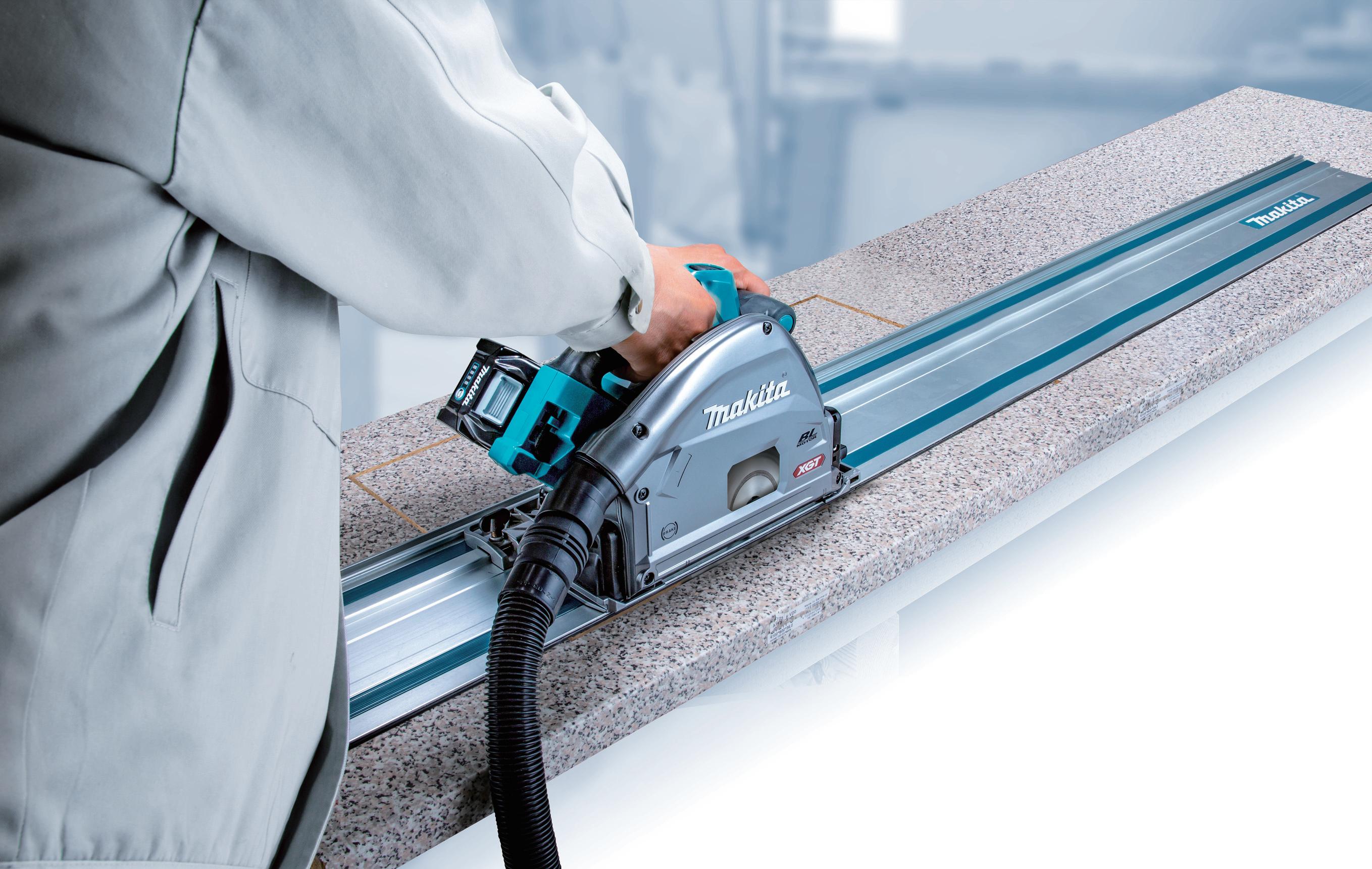
Furthermore, choosing a guide rail with a splinter guard will help ensure a highquality edge as it will prevent the action of the blade tearing the surface of the material. Similarly, to ensure the guide rail
remains in place once positioned, it is worth looking for one with anti-slip measures with the ability to easily clamp it to the material if additional security is needed.
Kitchen fitting jobs can require working with a range of different materials and these can vary from project to project depending on the customer’s specifications. For plunge saws specifically, this means a range of blades may be required for different tasks. As an example, for cutting fibre cement board a blade with fewer teeth, such as a 4T blade, is required. In contrast, when cutting laminate worktop, a blade with a much larger number of teeth, such as a 60T, is needed to achieve a quality cut.
Therefore, it is important to look for a saw that not only has a wide range of compatible blades, but also enables quick and easy blade changes. For example, the Makita SP001G has a specially designed mechanism to lock the blade in the correct position for easy access to remove and fit different blades. It also has the required hex key stored on the tool,
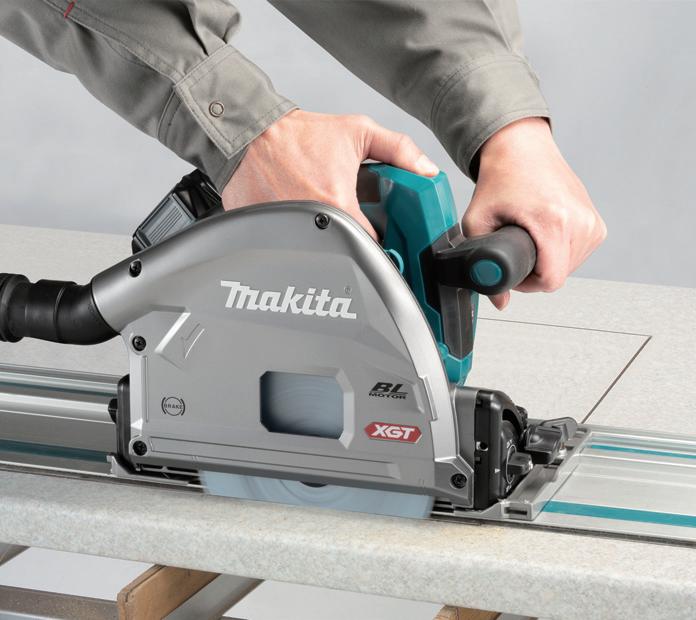
Next up in our series of power tool buyers’ guides, Makita provides useful guidance on what to look for when selecting a plunge saw for kitchen fitting.
so it is always at hand when required.
In addition, the blade speed can make a significant difference to the quality of the cut in different materials. A slower blade speed is more suitable for plaster board, while a higher speed should be used for solid wood. For this reason, it is important to select a tool that has simple variable speed control.

Another useful feature to look for on a plunge saw is a depth stop, which limits the plunge depth to a few millimetres.
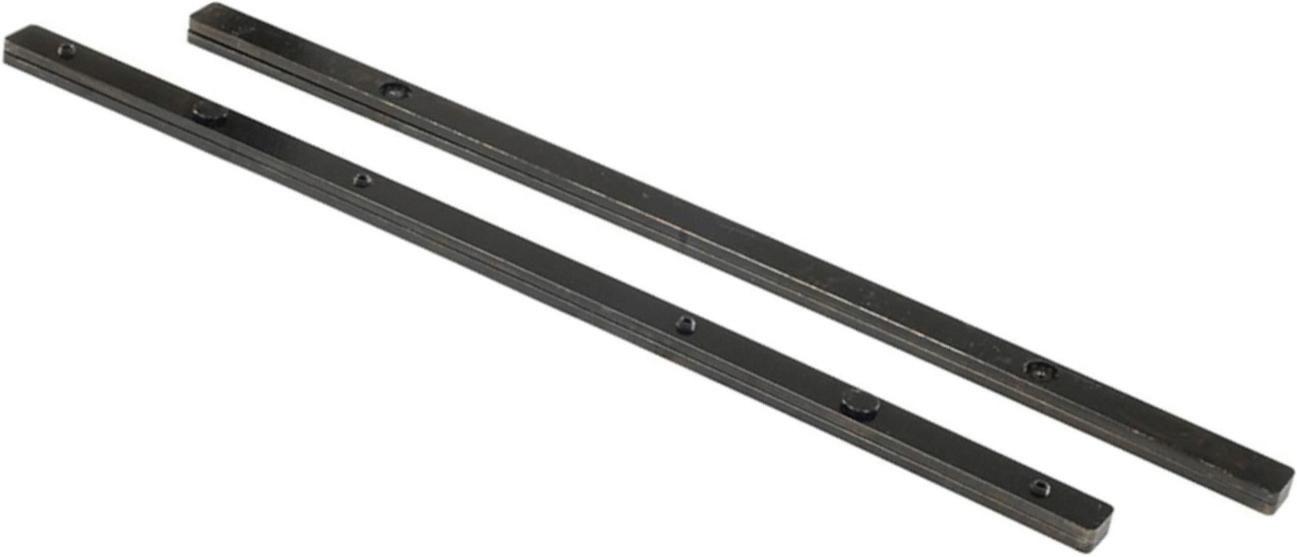
ENTER OUR GREAT MAKITA GIVEWAY COULD WIN THIS PRIZE BUNDLE, INCLUDING TWO 1.5M GUIDE RAILS FOR PLUNGE SAWS, CIRCULAR SAWS, JIGSAWS AND ROUTERS. THERE’S ALSO A GUIDE RAIL BAG AND CONNECTOR SET INCLUDE IN THE PRIZE. USE THE RDR.LINK BELOW TO GO TO THE ENTRY DETAILS

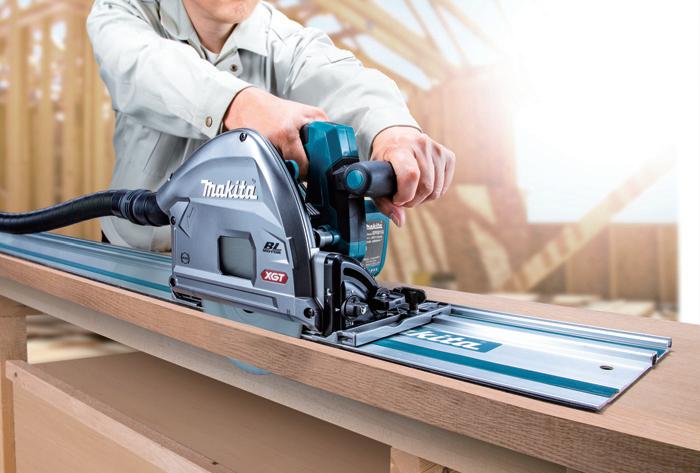
WWW.RDR.LINK/BAU034
is made. This is an importantconsideration when cutting laminated materials such as veneered wood used for kitchen cabinets.
When making a plunge cut, the blade can sometimes bind in the material. Therefore, features that prevent kickback,
speed and immediately shuts down the tool if the blade rotation suddenly slows. It is also valuable to look for a plunge saw that has an effective brake to ensure the blade stops quickly when deactivated to prevent accidental contact with the rotating blade.



Bushboard walks us through installing its redeveloped Alloy kitchen splashback range
The following is an installation process from Bushboard that should be followed. Before you begin, make sure all electrics have been disconnected as a safety measure and check the hob manufacturer’s guidance on the safe distance for install.
Bushboard has reimagined its kitchen splashback offering with its upgraded Alloy range. This new collection lets builders and kitchen fitters offer a range of splashbacks, which can be used as a cost-effective option for a quick kitchen update.
Divided into Alloy Décor and Alloy Colour, the revamped collection boasts 27 designs, including marble, stone, wood and industrial concrete looks, available in four varying sizes. The range has been developed to suit a range of design briefs with the added ease of versatility regardless of the shape or size of the space.
Alloy Décor offers 14 luxurious patterned designs inspired by natural elements, ranging from wood and stone to a style that emulates the look of tiles. The collection consists of 11 new designs alongside three of Bushboard’s bestsellers.
Alloy Colour is completely new and has 16 striking solid colour options. These range from light to dark, featuring both gloss to matt finishes and are influenced by nature. These are accompanied by four brushed metal designs.
Thanks to its 4mm aluminium composition, every splashback is fire-resistant, waterproof and anti-scratch, making it perfect for use behind any hob or sink and easy to maintain for homeowners.
The splashbacks can be easily cut, drilled and shaped to fit required measurements using standard tools. The installation should be hassle free too as they can be installed directly onto a pre-existing surface or on top of tiles with little preparation needed.



As an added bonus, when installed and used in line with Bushboard’s installation instructions and accessories, Alloy splashbacks are covered by a lifetime guarantee.
Wall preparation: Make sure the surface is flat, clean and debris-free. If an existing upstand is in place, make sure you remove any existing sealant first. Once this has been done, check for any wall
Measuring: Measure the opening where the hob panel or wide splashback needs to sit, then mark this measurement on the top, middle and bottom of the panel itself. If the panel needs to be shaped around sockets or upstands, ensure these measurements are also marked onto the rear of the panel.
Cutting: PPE is a must when cutting the panel, so please ensure this is taken into account. Using your plunge saw and guide rail, trim away the amount required, taking the sharpness off the edge by deburring using a sanding block. Wipe the splashback down with a microfibre cloth.


Dry-fitting: Remove the backing from the splashback panel, marking the top of the panel so the orientation remains as intended. From there, place the panel in position to ensure it fits the space, and note the alignment of any features such as plug sockets of upstand corners.

Fitting: Once the adhesive is applied, push the splashback into the desired position, firmly, ensuring all areas are pressed in. Insert spacers to avoid the panel from slipping
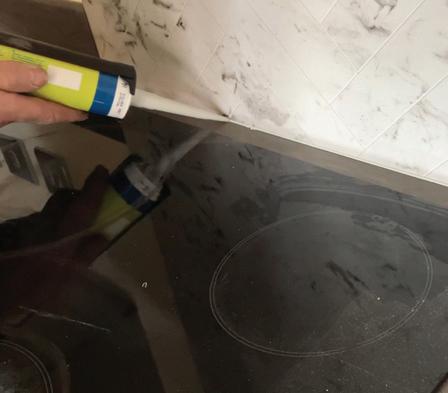

Adhesive application: Mark 40mm around the perimeter of the panel as all adhesive needs to sit inside this zone. Cut a 5mm hole in the adhesive nozzle and apply a reasonable covering in a zig-zag pattern.
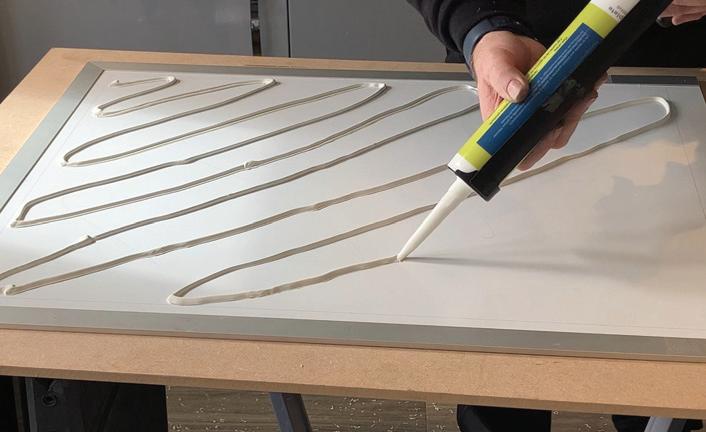
TO FIND OUT MORE ABOUT THE BUSHBOARD ALLOY RANGE, VISIT: WWW.RDR.LINK/BAU036
Sealing: Apply a thin bead of sealant and smooth out. Allow for it to cure and your install is complete. Any sockets removed


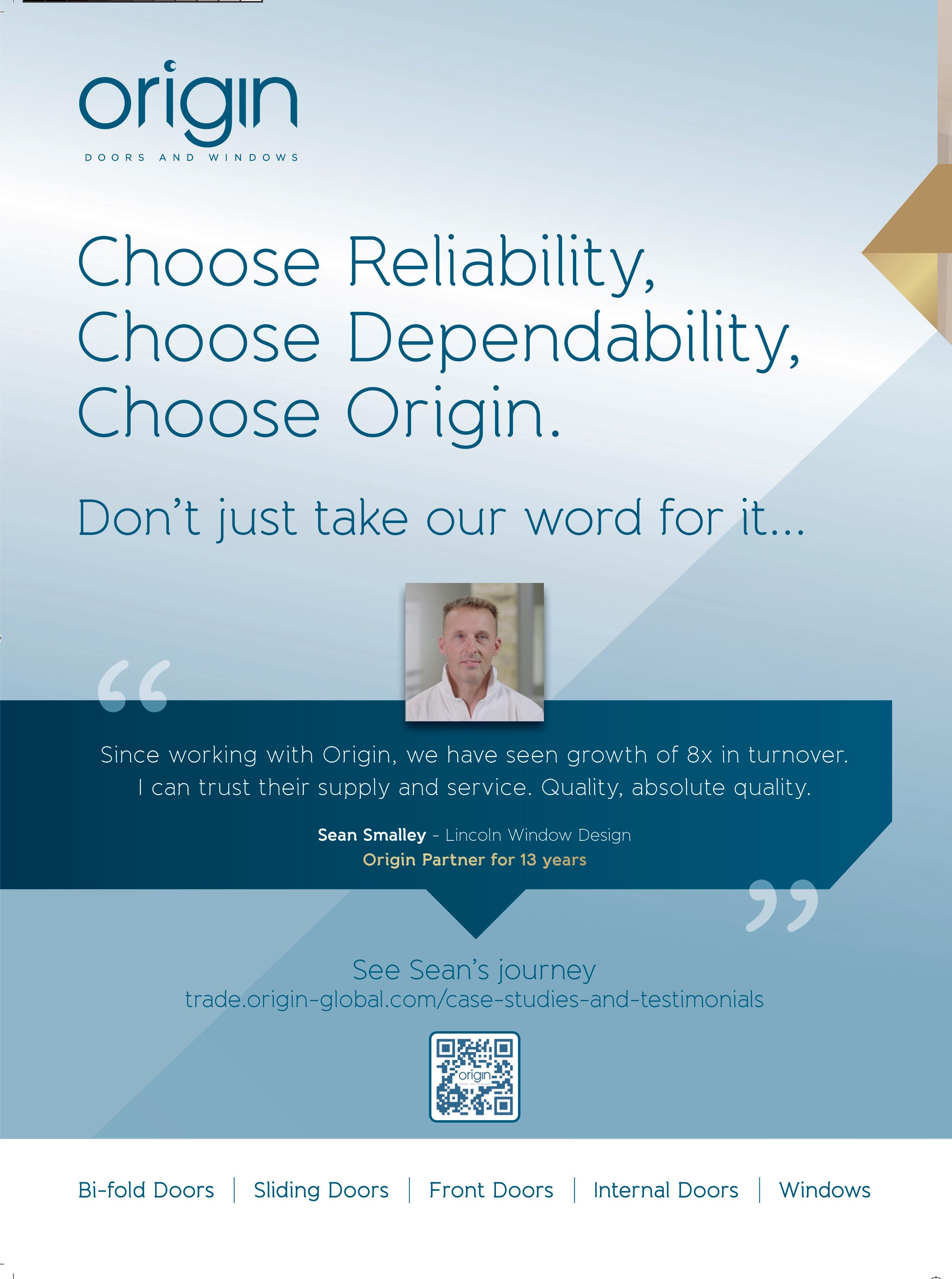


According to recent reports, turbulent property prices, restricted housing supply, and rising moving costs have seen a surge of homeowners pausing their moving plans in favour of improving their homes. As household budgets come under pressure, many homeowners are looking to try and save money by spending their leisure time at home, this is reinforcing the aspiration to create rooms where they can relax, with one of them being the bathroom. Whether that be creating a spa-style environment or a luxury family bathroom, how can installers help homeowners to achieve their desired look within a strict project budget?
There is no doubt that the bathroom has changed from being a purely functional space to one that can really wow. The demand for stylish and trendled bathrooms is on the up. However, with limited budgets, it may be that customers are looking to revamp certain parts of the bathroom rather than a whole renovation project, such as the replacement of brassware, a new lick of paint or an upgrade to their tiles. This is where the benefits of wall panelling comes in.
Over the last few years wall panelling has increased in popularity, thanks to its ease of fitting, its hygienic properties due to lack of grouting and the fact that it’s simple to clean. With shower panels being quicker and easier to install than tiles, installers can save time and money, helping to keep projects –and the client’s budget –on track. In addition, specialist wet trades aren’t required to install bathroom panelling, which offers an opportunity for any tradesperson to carry out the work themselves without having to bring in a subcontractor, making a

difference to the bottom line and project timings as they’re not having to rely on someone else.
This opens up the sector to bathroom installers who are looking to diversify their offering and capitalise on this expanding market. The large-scale panels are easy to fit with near invisible joins, saving time for installers and speeding up bathroom projects.

In fact, it is estimated that bathroom

retrofitted over existing tiles, reducing preparation time, which would otherwise add more labour on to a job –simply cut to size, fix to the wall, fit the finishing trims and seal.
No grout means less gaps and grooves for the build-up of dirt, soap residue and
maintain with a simple wipe down.
Plus, there are hundreds of design choices available, ranging from tile-effect panels and replica marble finishes to wallpaper-inspired prints. Homeowners can choose panels that recreate the look of metro, scallop or herringbone tiles; all popular on-trend looks that can be intricate and time-consuming to achieve with individual tiles. There are also mineral and marble-inspired finishes available that give the effect of these stunning natural materials, but without the expensive price tag. And for homeowners looking to create a feature wall effect, there are a whole host of designs that reflect wider interior trends, from natureinspired botanical prints to vintage floral patterns and travel-inspired safari-scapes.
An array of accessories are also available to ensure the bathroom has a top-notch finish, such as black trims to accentuate darker panels and complement popular matt black enclosures and brassware, these
accessories also create a watertight fit and forget solution.
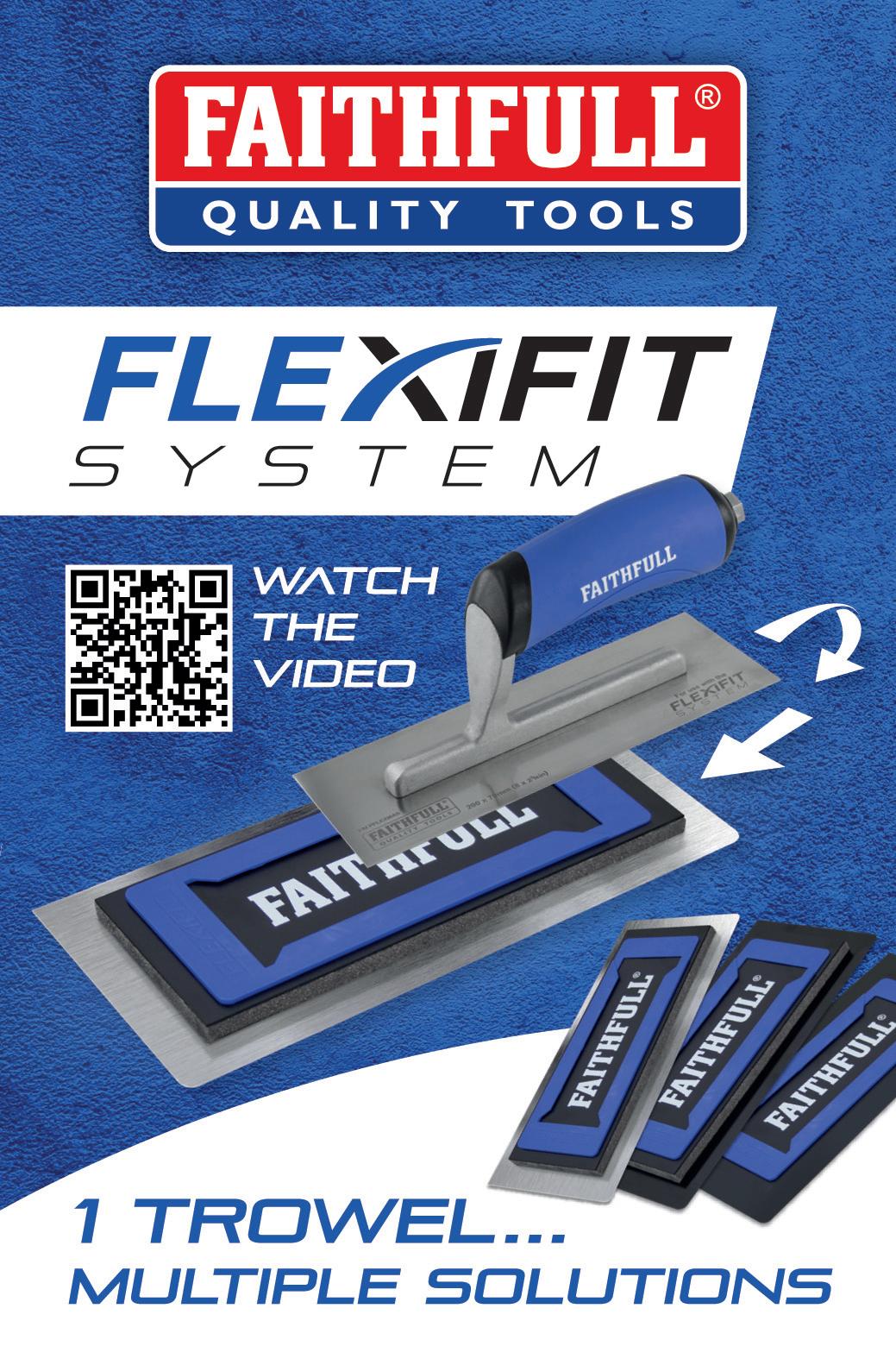

With many homeowners looking to achieve a high-end look on a budget, wall panelling offers the ideal solution. Being able to provide customers with a lower cost yet visually striking solution to their bathroom renovation is a win-win situation for installers as well as the homeowner.

The full Showerwall collection offers over 100 decors to suit all tastes, with Laminate panels available in 600mm, 900mm and 1,200mm x 2,440mm, Acrylic available in 896mm and 1,200mm x 2,400mm and Compact available in 1,220mm x 2,440mm.
All panels purchased and fitted using Showerwall’s recommended fitting guide and accessories are also now guaranteed to remain waterproof for 30 years.
Save time, make money all year with the reliable, easy to use and clean, pneumatically powered, vibration free Pnu-Point pointing tool.

GARADOR OFFERS FREE UPGRADE ON ITS SECTIONAL GARAGE DOORS.

Garador is now offering a free upgrade to Secured by Design accreditation on all its sectional garage doors. There are certain eligibility requirements. Find out more at www.garador.co.uk
sales@pnupoint.co.uk

Perfect when optimising space in the kitchen, System Sync from Abode allows homeowners to select a sink format that is right for them, with three available bowl sizes crafted from 0.8mm 304 grade brushed stainless steel. The sink was designed alongside three complementary accessories, a multi-functional prep board, stainless steel colander, and a roll-up FlexRack to create a customisable sink solution.
PJH has added a number of products to its Bathrooms to Love brand. This includes additions to its Washbowl Collection (with the circular Matt Deep Blue Luxey model), Traditional range (with the brushed brass Berwick thermostatic shower mixer), and shower tray products (with the ultra slim RefleXion Slate Grey Shower Tray).
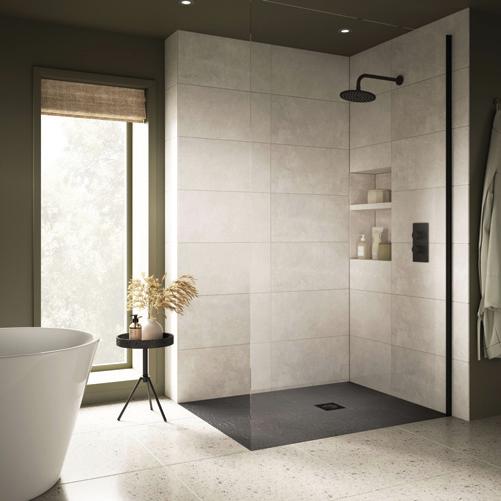
GET MORE DETAILS AT:
With stainless-steel retaining its position as the material of choice in kitchen sink design, Clearwater has introduced Monza, an inset sink that is big on both form and function.
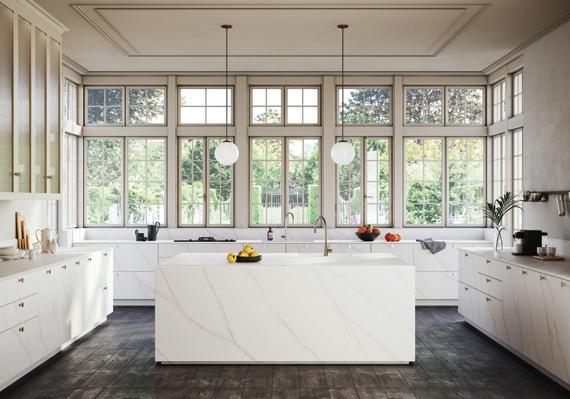
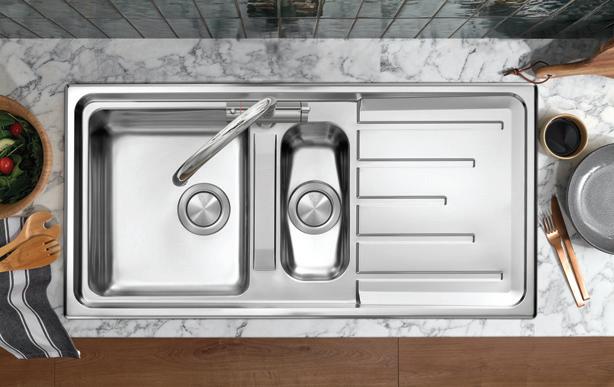

The sink is available in three options and is designed to be inset into any worktop, with a pre-fitted seal making seamless installation and a water-tight finish simple.
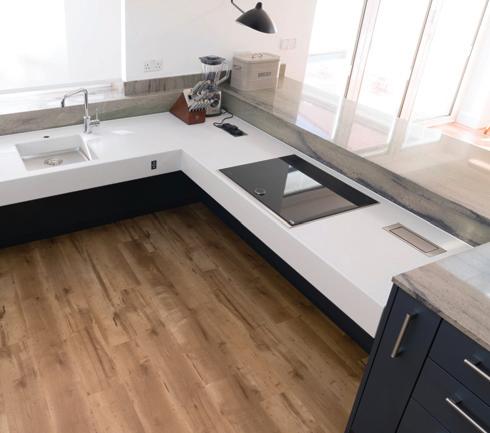
WWW.RDR.LINK/BAU040
In order to offer further versatility, Kudos has once again expanded its Pinnacle8 shower enclosures collection. The additions are sliding door models that have been designed without the need for a bottom rail, providing a level access. These are suitable for either a corner or a recessed installation, the units stand 2,000mm in height, with 8mm toughened safety glass, and come with LifeShield protection.

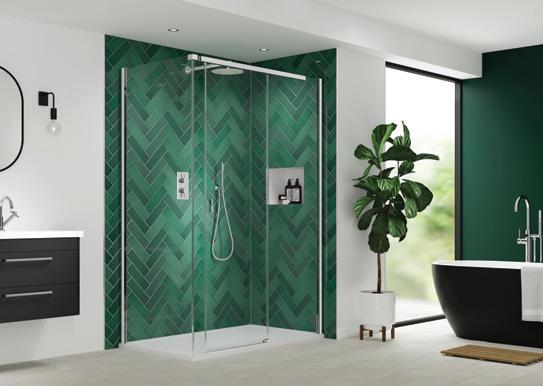
GET MORE DETAILS AT: WWW.RDR.LINK/BAU041
Extending its AQ mixer shower collection, Aqualisa has three new models in a matt black finish. The showers are available in different shaped dual outlet shower columns, or a round bar valve option with adjustable handset. They also offer innovative safety features and are supplied with easy-fit wall brackets, allowing for straightforward installation.

GET MORE DETAILS AT: WWW.RDR.LINK/BAU042
The Freedom collection from Symphony is designed for accessible and multigenerational living and on the key principles of safety, flexibility, storage and style. The features of the kitchen collection include electric rise and fall surfaces and wall cabinets, innovative oven housings and pull-out tables with storage drawers. These will all help to create a safe and usable
GET MORE DETAILS AT: WWW.RDR.LINK/BAU043
Designed with installers’ needs in mind, MERLYN’s IQ easy-fit shower door range is the result of extensive inhouse research and development to tackle common pitfalls inherent with traditional door assembly. The result is an easy-fit ‘slot and lock’ mechanism which can be fitted safely and securely by one installer. The company has been awarded two British patents for the technical solutions used in this design.
GET MORE DETAILS AT:






100% natural, made in Italy and appreciated for its aesthetic and performance characteristics, Lapitec is a cladding material for kitchens. With a formula that is free of crystalline silica, it comes in large ‘full body’ slabs in a range of thicknesses with unprinted mineral colours present in the mix. The company has also added five new shades to its popular Musa collection.
GET MORE DETAILS AT: WWW.RDR.LINK/BAU045
Liam Hale, construction director at Taylor Lane Timber Frame, explains more about timber frame as a modern method of construction and how it can save SME and micro builders both time and money.


Timber frame construction is increasingly popular with larger house builders and developers due to the many associated benefits, but did you know that these benefits can be appreciated whether you are building one or one thousand homes?

But first, what is timber frame construction?
Timber frame is an offsite construction method. This means that many of the elements – the walls, floor and roof – are precision-engineered in a factorycontrolled environment, which avoids delays caused by inclement weather. Often the manufactured panels also
include a membrane and insulation to help achieve the desired thermal performance. The component parts are then delivered to site for erecting.
have on your business, overheads, and schedule? Let’s outline some of the advantages...
It’s fast.
Over the years timber frame construction has been synonymous with speed. It’s a fast yet high quality build method. Using

Kinspire Homes is a SME developer based in Herefordshire. They are currently onsite with their fifth development comprising five houses and four house types, and a sixth site is being purchased. They have been a committed user of timber frame since day one…
“We went into our first project knowing that it was going to be a winter build,” says director, John Parker. “Speed was critical if we were to stay on schedule and within budget. We needed the properties to be dry as soon as possible, this meant
working week. It also enables other trades to start work inside the property before the brickwork is complete. This makes for a more predictable build programme and can help reduce costs.
It’s green.
Furthermore, as attitudes change and demands for better quality housing resonate across the land, timber frame is now valued for its environmental credentials. Much of this is down to sustainability. Timber is the only truly renewable building material and reputable suppliers will only use timber from PEFC or FSC certified sources. Typically, for every tree cut down, three or four are replanted.
Timber also has the lowest CO2 value of any commercially available building material. Trees capture the carbon and isolate carbon dioxide. This is retained inside the timber throughout its life as a structural building material, and beyond if recycled!
It’s future-proof
Timber frame is highly engineered and can offer extensive design flexibility. It lends itself to an abundance of tastes and property styles enabling you to meet most structural and visual requirements while adhering to the appropriate standards and regulations.
What’s more, smart design can future proof a property. Whether you are building a home for yourself, a one-off client or a small development, work with the architect to create an adaptable layout. Knock-out panels can be added for flexibility – turning a fourth bedroom into
looking beyond traditional build methods.
“We quickly identified timber frame construction as the solution, having weighed it up against the time taken to build in traditional brick and block, cost of brickies etc.
Kinspire are now building their fifth development and “…To be honest, it’s unlikely that we will go back to traditional building,” continues, John. “The speed and accuracy of timber frame has been extraordinary. The dimensions are pretty much spot on every time.
“We are proud to show prospective buyers around when the properties are under construction. They are able to see the quality for themselves, especially the timber frame which isn’t something you can see normally.”

a walk-in wardrobe and dressing room for a master bedroom, for example. Or, with a knock-out panel and the foresight to use attic trusses, an integrated garage can easily become a room in the roof.
It’s accurate. With optimised cutting technology timber frame doesn’t just save you time and labour onsite it also reduces skip waste. Our current wastage in production, for example, is between eight and 12 per cent, and we are constantly looking at ways to reduce this further. 100% of this is then diverted from landfill. Ultimately, our efforts and those of other timber frame manufacturers cuts down the number of skips required onsite which saves you money.

Perhaps now the most pertinent benefit
– a property built with timber frame will remain warmer throughout the winter and stay cooler during the summer months. It can heat up quickly and retain that heat for longer. As a natural insulator, timber, when used as a build method, can help to reduce running costs and energy bills. For best results, set the required thermal performance early in the project. This will help determine the level of insulation needed.
And remember – it is far easier to achieve a low U-value (the measure used for thermal transmittance) with timber frame than traditional build methods. It can even go beyond Building Regs without filling the cavity!

Innovative stormwater management solutions are vital for building flood resilience into new and existing projects. Below ground attenuation tanks are gaining in popularity as part of a broad shift towards sustainable drainage systems (SuDS) in the built environment, but their bulk and size can often make installation seem like a big undertaking for builders – particularly those working on smaller-scale projects.
Builders are often pressed for time and space on projects, which can make the installation of SuDS tricky. There are a multitude of SuDS products available on the market, and anyone who has worked with below ground drainage will be familiar with the crucial role that attenuation tanks play – as well as the potentially extensive installation process required. That’s why the next generation systems have been designed to be easier to store and quicker and safer to install.

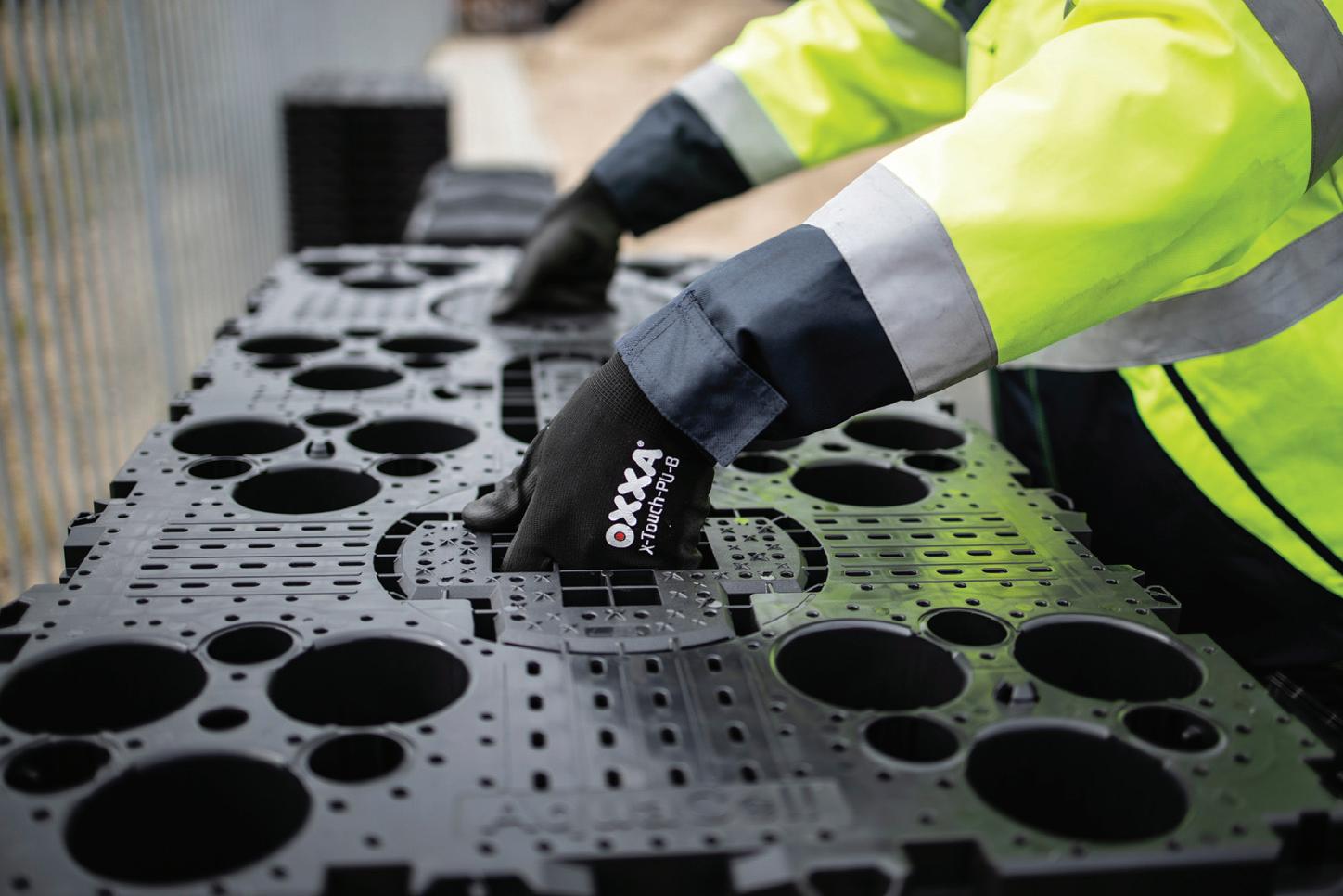 Lambley,
Lambley,
can make their installation process as straightforward as possible.
Push-fit connectivity, for example, is an important development that removes the
grips. These seemingly small changes to the design have been made with usability front-of-mind, making the new generation three times faster to install than its predecessor.
Modular design is another phenomenon that’s making a splash across the built environment when it comes to reducing installation times, and it can make a big difference with below ground drainage as well. Attenuation tanks made from smaller modules give builders crucial flexibility to adapt to whatever conditions they find on site and ensure that these powerful solutions are still an option, no matter the size or shape of the space available. There is no onesize-fits-all solution when it comes to SuDS, so systems have to be adaptable to the huge variety of worksites out there.
Many builders, particularly those working in urban environments, don’t have the luxury of spacious sites with

straightforward access arrangements. Crowded sites can pose serious health and safety risks to workers, while having to close roads to receive deliveries incurs costs and has a negative impact on the local community.
AquaCell NG is designed to thrive in a tight spot. The nested design allows it to be easily stacked; it requires four times less storage space than the previous generation, contributing to a safer site and meaning it can be delivered in a quarter of the number of trips. The end result is a less cramped worksite and fewer health and safety risks for builders to manage.
Quick and easy installation also has its benefits when it comes to site safety. There are some risks that can’t be avoided, such as having workers in the trench to install the system. However, push-fit technology that doesn’t require tools, and modules that are easy to handle with one pair of hands, can reduce
It’s important that SuDS aren’t just seen as another thing added to already busy workloads; they offer genuine, commercial benefits to a build. New research by Wavin found that flood resilience is a high priority for homebuyers – with more than 73% of those surveyed saying they would be willing to pay a premium for flood
ground solutions. Some of the benefits of soft SuDS solutions such as ponds, swales and tree pits were also a hit with buyers, with 43% and 55% willing to pay more for increased biodiversity and water quality, respectively. It highlights the value that sustainable drainage can add to a project by directly appealing to buyer wants and needs.
As SuDS increase in importance, making them as adaptable as possible will be crucial in ensuring they are accessible to a wider range of projects. This is where innovative solutions that are built to be easily, quickly and safely installed will help builders use them to add value to their offering.
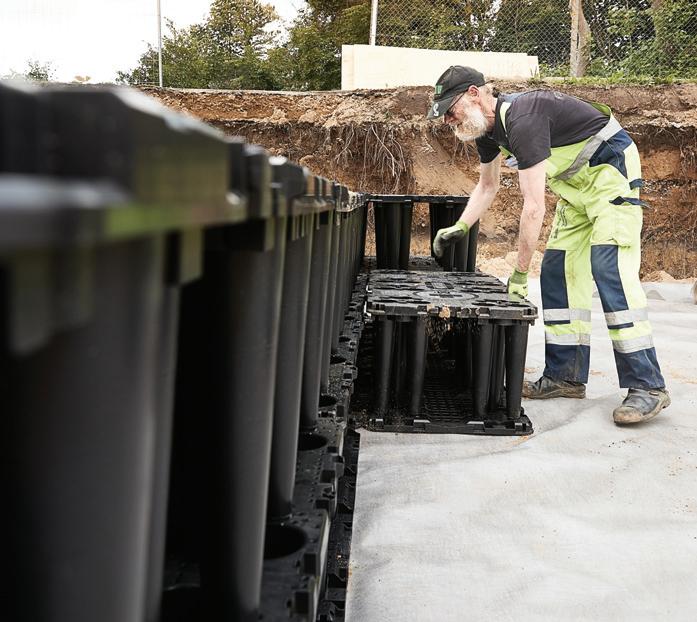
FOR MORE INFORMATION ABOUT AQUACELL NG VISIT
WWW.RDR.LINK/BAU047

 TO ACCESS WAVIN’S RESEARCH ON THE VALUE OF SUDS TO NEW
TO ACCESS WAVIN’S RESEARCH ON THE VALUE OF SUDS TO NEW
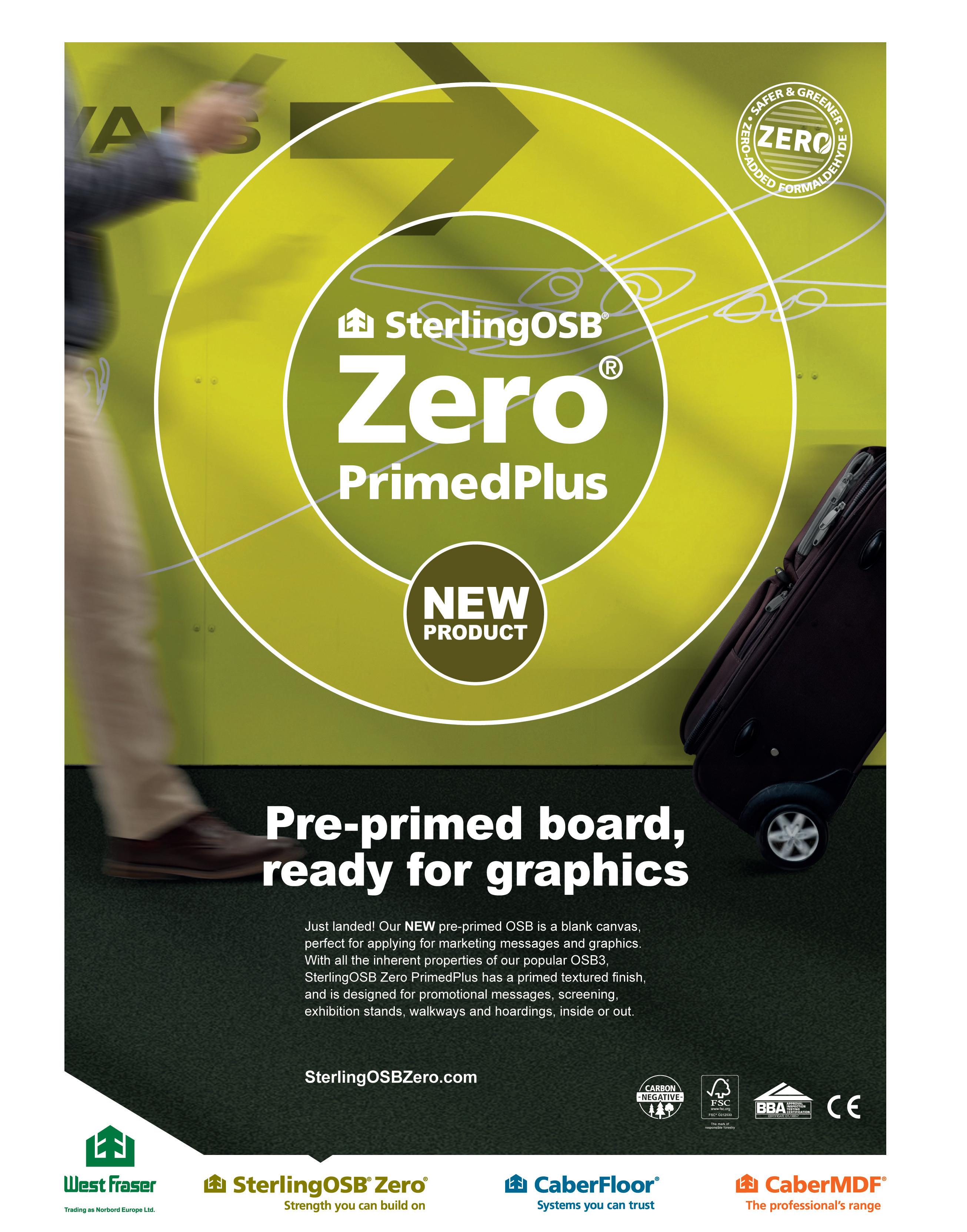
Creating a sustainable home is now a top priority for house builders, from locally sourced materials to energy efficiency measures. In a recent survey by Marshalls, 43.5% of people would pay more for a home built with sustainable materials – motivated mainly by doing their bit for the environment and saving or generating energy for their home.
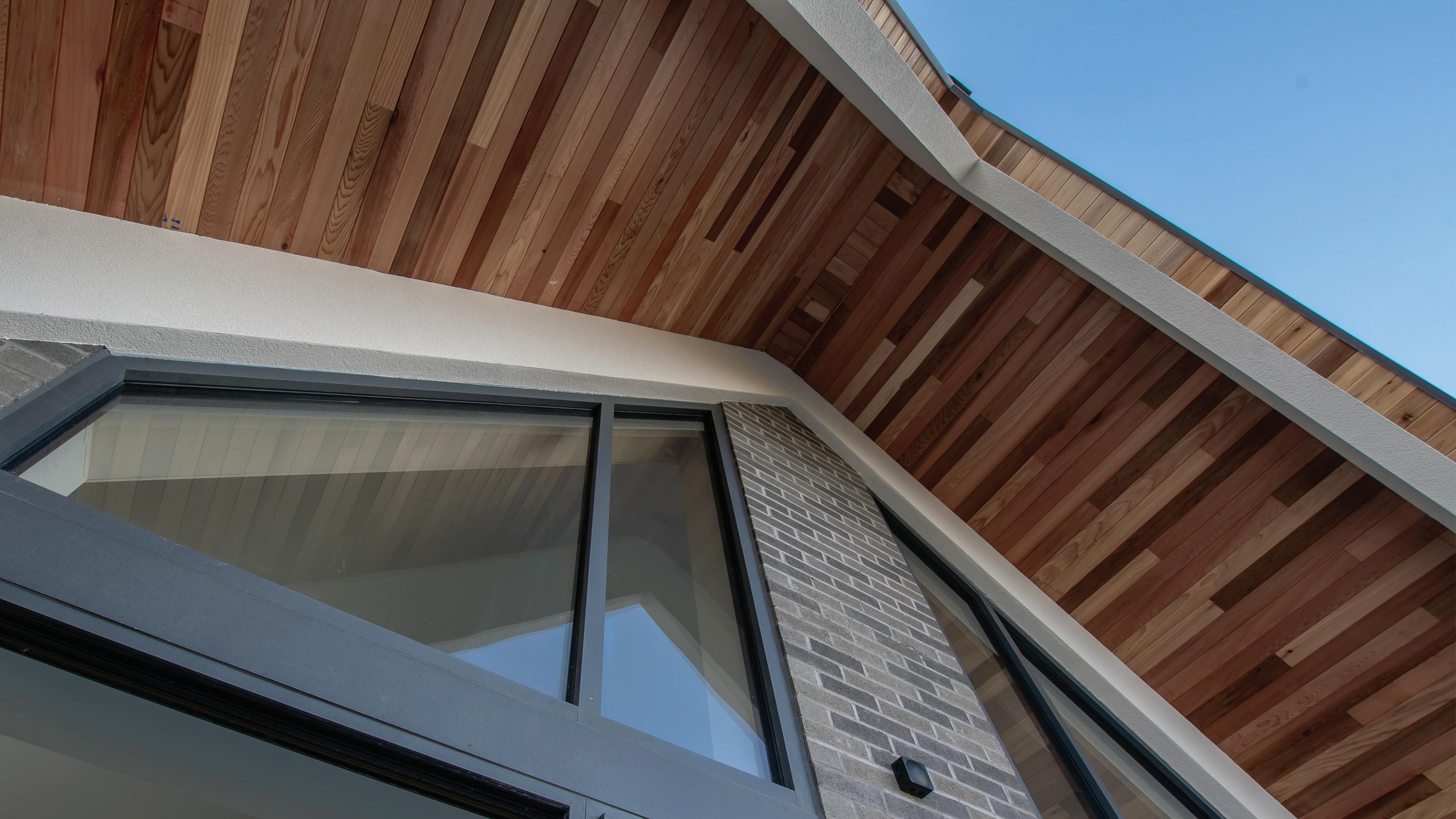
Professionals and homeowners alike welcome the growth of sustainable material choices – but how easy is it to know what makes the most significant difference and what sets some materials apart from the rest? Many housebuilders are trying to achieve their sustainability goals through solar panels, improved insulation, more efficient white goods, alternative heating technologies and LED light fittings, which are all positive steps. But, can more materials be changed to unlock extra carbon savings and create more sustainable developments?
In this article, we will explore three
innovative approaches that you may not have considered before to enhance the sustainability of your projects without compromising on style or design.
The manufacturing process of concrete bricks is partly what makes them a more sustainable option over traditional clay facing bricks. For clay bricks to harden they need to be fired in fossil-fuelled kilns, creating significant carbon emissions. Concrete facing bricks, on the other hand, harden naturally through an exothermic process, meaning that significantly less energy is needed in their curing.
In addition, concrete actually absorbs CO2 over its lifetime –a completely natural process referred to as carbonation or “sequestration”; bricks absorb CO2 from the atmosphere as they age and harden. Once the CO2 comes into contact
with the concrete, a catalytic process permanently transforms it and locks it into the material, so even when the product is crushed at the end of its lifecycle the

Innovative
water to soak into the ground where it lands. This can lead to overwhelmed drains and flooding, so you should consider permeable paving or grass paving to get around this.
Permeable paving looks like regular block paving but features a specially engineered wide joint and carefully specified jointing material which allows water to seep through the joints and reach the ground rather than accumulating on the surface and running off into a drain. For driveways, you could also look at grass paving, which is a loadbearing grid system which allows grass to grow through the openings in the grid. As well as reducing surface water runoff this has the extra benefit of increasing biodiversity, creating a more attractive, natural finish, and potentially lowering the temperature around the properties on very hot days.
reduction in CO2 compared to traditional clay facing bricks on the market has been calculated at 49.1%.

Cement is a crucial ingredient in many building materials, but although it accounts for around just 10% of the ingredients within a concrete mix, it can account for over 80% of the total carbon footprint. For building projects, concrete is a solid, durable, cost-effective material for which a suitable alternative has yet to be found. So, how can you make better choices to lessen the impact on the environment but continue benefitting from this versatile and durable material?
As we’ve seen above, concrete has carbon absorbing benefits, and it’s the cement ingredient which can make it less sustainable. As manufacturers develop more sustainable materials, many are investing in low or no cement options, so ask your suppliers or merchants to point you in the right direction.
If you’re interested in the science behind the process, it’s helpful to know how it all works. Marshalls, for example, has collaborated with several suppliers to harness by-products from other industrial processes and waste materials. These materials exhibit properties comparable to cement-based systems when activated. Activators are composed of a blend of
raw materials, which chemically react when combined with cement replacement materials to produce concrete with equivalent strength and durability to regular concrete.

When it comes to hard landscaping the outdoor spaces and communal areas of

These examples show that revisiting simple material choices can help create more environmentally friendly homes and communities without compromising on quality or aesthetics. With the demand for sustainable homes on the rise, embracing these practices aligns with environmental goals and positions builders at the forefront of the industry.
FOR MORE INFORMATION ON MARSHALLS’ LOW CARBON FAIRWAY FACING BRICKS, USE THE RDR LINK: WWW.RDR.LINK/BAU049

As the UK works towards net zero targets, how can housebuilders make their newbuilds more energy efficient and sustainable?
England and Wales both have a median energy efficiency rating of band D, according to the Office for National Statistics. But the right investment can have a significant impact, with taking a home from a D rating to a B saving the average resident around £500 per year.
Traditionally, caulking and tape have been used to seal gaps in homes. This time-consuming and costly process can be open to human error, as installers have to trust that they have found and covered every gap. Even with the greatest attention to detail this is unlikely, as some gaps will be invisible to the naked eye.
Installers only know how effective their work is once the home is tested, which can be after the project has finished when options are limited to improve airtightness further.

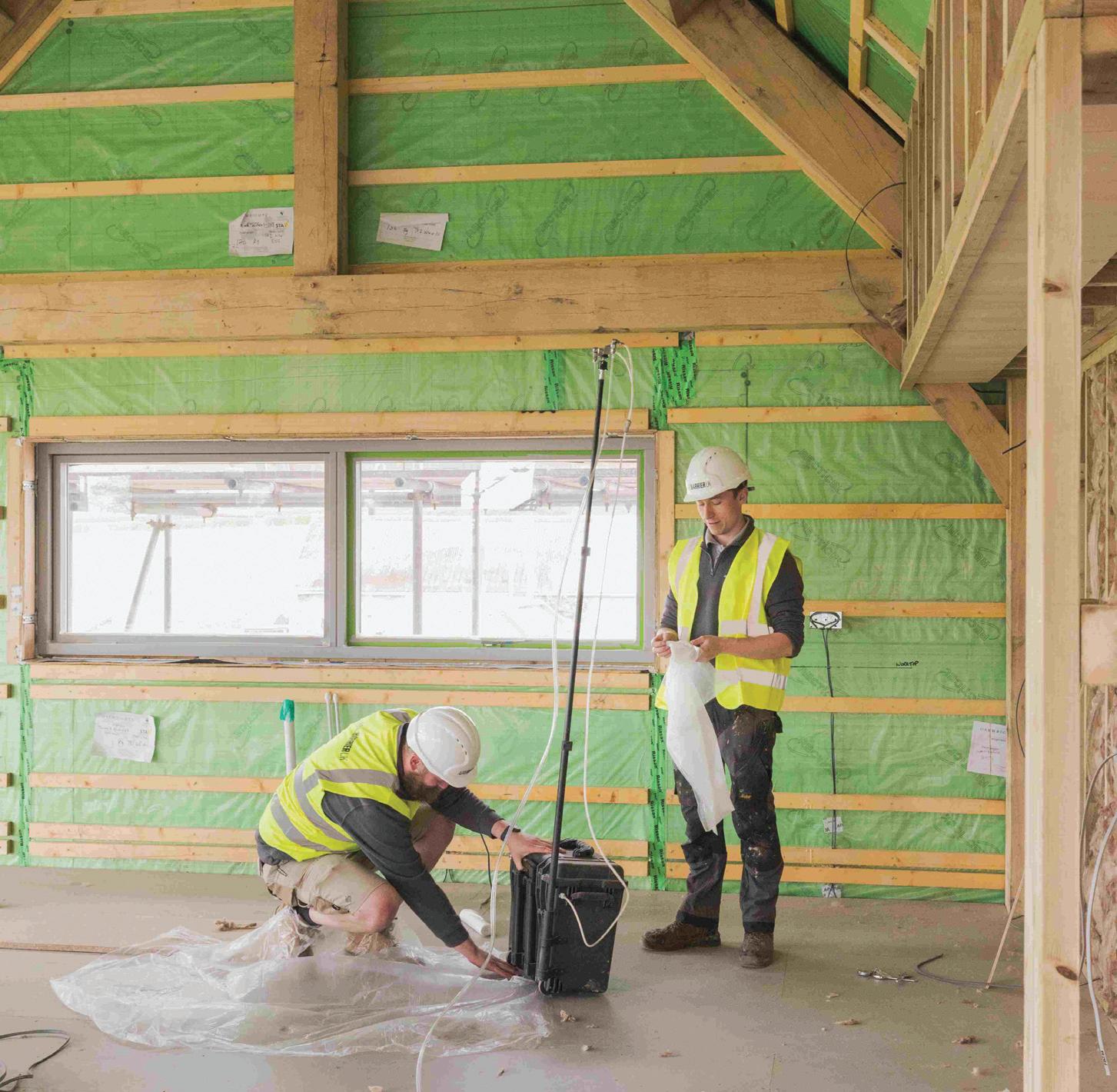
Air movement occurs in two forms; deliberately controlled ventilation, such as air supplied through a mechanical ventilation system, and infiltration, which is unintentional air movement through cracks and gaps in the building fabric. Cold, damp, condensation and poor air quality can be caused by air leakage. This has a significant impact on the quality of living for residents and the maintenance costs to upkeep the house.
One of the most common misconceptions about creating an airtight home is that it needs to breathe. One thing is certain, if a building is ‘breathing’ through its envelope, it doesn’t mean clean air is finding its way into and out of
the structure – in fact, exactly the opposite is happening. Walls contain all sorts of things, from dust to mites to fibreglass. When you add in the issues of external pollution from roads, any local industry, and penetrating water, the issues quickly mount up.
Damp conditions, caused by a lack of controlled ventilation, can have tragic consequences, as illustrated by the death of two-year-old Awaab Ishack, who suffered a cardiac arrest following a respiratory illness caused by mould in a Rochdale flat in 2020. His death highlighted the need for actively ventilated and accurately designed airtight homes, especially for the more vulnerable people in our society.
Modern building should consider bringing fresh air into the building as a higher priority – by reducing infiltration and improving ventilation, many of these concerns can either be reduced or entirely removed.

Fortunately, since June 2022, every new dwelling in England and Wales has required an airtightness test to meet Building Regulations. Measuring the effectiveness of airtightness provides a benchmark and allows an accurate understanding of return on investment. Accurate data gives house builders and their customers the peace of mind that the airtightness solutions deliver on their
intended promise and improve the living conditions of residents.
Businesses can go one step further and test air leakage as the airtightness solution is being applied to the property. Widely used across tens of thousands of homes in the US, UAE and Canada, AeroBarrier has now been launched in Britain. Homes are pressurised before a sealant mist is distributed. The pressure guides the sealant to all visible and invisible gaps where it solidifies to create a seal and improve air tightness. An operator with a laptop monitors the level of air tightness seal required by the builder, architect or contractor so they can stop the process as soon as the desired level is achieved. Construction can resume normally half an hour after the process is complete with little or no impact on standard schedules.
AeroBarrierUK talks airtightness and making homes more energy efficient and sustainable


In January this year, the Government published plans to make the incorporation of sustainable drainage systems (SuDS) mandatory in new developments in England. This is a result of a review into the implementation of Schedule 3 to The Flood and Water Management Act 2010. The aim of SuDs

‘SuDs’ has been bandied about for many years, and that we have been experiencing an alarming increase in flooding events in recent years, it is perhaps surprising that the incorporation of SuDs in new developments is not already mandated in England (as it is in Wales). However, that is all set to change, with the Department for Environment, Food and Rural Affairs (Defra) consulting on the proposals later this year and planning to implement them in 2024.
For many years, driveways (and other surfaces) have been landscaped with impermeable materials such as asphalt or concrete. At times of sudden heavy rainfall, which we are seeing increasingly, water flows off these surfaces very quickly, flowing into gullies or channels which lead to traditional drainage systems. Whilst these systems served us well when they were built, our societies have now industrialised and urbanised to a point where these systems are struggling to
cope at times of peak rainfall. Much of the land on which our towns and cities are based is covered with impermeable hard landscaping, and it is not surprising that the sheer volume of water run-off often overwhelms drainage systems, leading to flooding, damage, and the pollution of watercourses. Around 325,000 English properties are currently at high risk of flooding caused by heavy rainfall and that number is set to increase over the coming decades. Flooding causes major disruption to people’s lives and livelihoods and sometimes even loss of life.
Whilst asphalt and block paving can be made ‘SuDs-compliant’, it is an expensive and work-intensive option. It’s better to have a completely porous surface area rather than an expensive SuDs-compliant workaround.
The material used to create permeable paving is not permeable itself, instead, the gaps between the pavers are what allow water to filter through. If the gaps
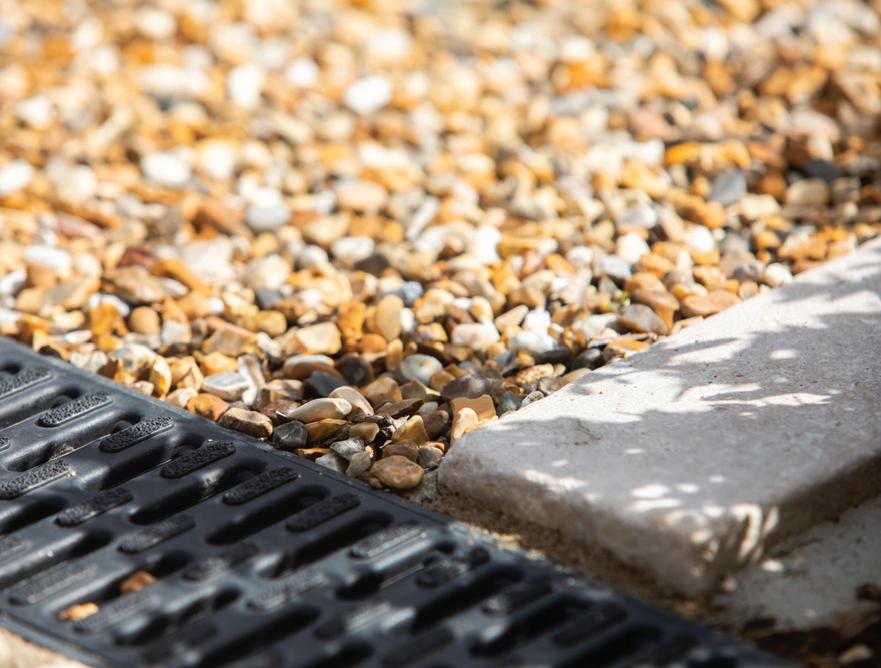

between the pavers become clogged up with dirt, the surface becomes impermeable. Similar problems occur with porous asphalt, the pores are small and prone to blockage. With asphalt, drag is an even bigger problem and slows down the water flow rate. Both surface finishings ultimately can cause water to run off and infiltrate traditional drainage systems if they are not regularly maintained. Using a genuine permeable material, such as gravel, is a far simpler and more effective option.
Many homeowners still have the perception that ‘gravel is ok but it moves around and can end up indoors’. However, gravel retention systems have changed all that. Beauxfort was the first to market with its clever ‘Gravelrings’ grid system which locks the gravel into cells, preventing migration and providing a
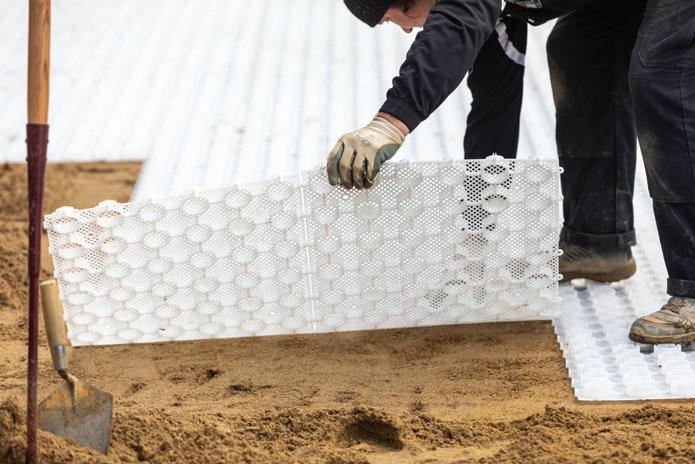
mesh-backed base, which means that water can permeate and soak into the ground below, making it a much more environmentally friendly option. Installation is quick and easy and requires less gravel than competing systems. Given all the benefits of the Gravelrings system, it will soon become difficult to justify using more expensive, labourintensive materials.

As a natural drainage solution, SuDs
is only a matter of time before the incorporation of SuDs becomes mandatory across England and the hope is that it will make a significant difference in urban areas that have experienced destructive sudden flood events, as well as those that are at risk in the future. Fortunately, as well as being the right thing to do environmentally, the cost benefits of using permeable surfaces –instead of impermeable ones –are clear, making this an easy swap to make. We can expect the SuDs philosophy to become the norm rather than the exception within the next few years. It makes sense to be ahead of the curve and start incorporating them on a voluntary basis as well as enjoying the savings they can deliver sooner rather than later.
FOR MORE ON BEAUXFORT’S GRAVELRINGS SYSTEM, VISIT THE


Now in full effect, Part L of the Building Regulations is not only driving the nation’s journey towards the development of energy efficient, low carbon dwellings, but also forcing an industry-wide push towards greater sustainability, clarity and transparency when it comes to the origins and environmental credentials of the products that are used.
Daniel said: ‘For professional roofing contractors, navigating their way through the additional layers of legislation that are now required, along with the essential and growing importance placed upon environmental responsibility, the use of a single trusted full roof system supplier –with the capability to deliver on every level from product and service to transparency and traceability – can provide real benefits for the roofer, including streamlined ordering, product compatibility, product traceability through the supply chain and a meaningful warranty.
‘Marley is the only manufacturer to provide a genuinely complete full roof system. Ordering all roof products from a single manufacturer has real benefits for the roofing contractor. It removes the worry of mix & matching products, hoping that they will fit together and remain watertight. Marley’s roof products are designed to work together seamlessly, preventing this issue. In addition, when utilising a complete system from one source only, manufacturer technical support can be on hand to provide guidance on all aspects of the roof installation.

‘Designed to work together seamlessly, the Marley fully integrated roof system includes JB Red battens, underlay, clay or concrete tiles, fixings, accessories, fire barriers plus the hugely in-demand integrated Marley SolarTile® and provides a tried, tested and trusted solution. With each individual roofing component proven and evaluated, the system helps to make the roofer’s life on site much easier than ever before.

‘A full roof system, designed and installed correctly, will be fully compliant with current Building Regulations, including fire safety and eradicates the risk of product substitution that can compromise roof performance over the long term.
Once installed, Marley’s full roof system –including Marley SolarTile –comes with a comprehensive 15-year warranty.
Daniel said: ‘Once again, a full system approach gives roofing contractors and their customers real peace of mind. If there is an issue, it can be resolved swiftly with one point of contact, saving roofers’ valuable time and resources. Our 15-year warranty is a demonstration of the
company’s confidence in its integrated roof solution but also is an indication of its pledge to operate as a responsible and transparent roof systems manufacturer.
‘Marley offers complete technical support for roofers, both before they get on the roof, with fixing specifications and estimates, as well as once on the roof, with comprehensive fixing guides, tutorials and training. In addition, we offer an expert team of technical advisors on hand over the phone, for queries that need immediate attention on site.
‘For those roofing contractors moving into the growing area of solar PV, Marley’s onsite training, available with their first installation, provides a real benefit helping to ensure that roofers have full confidence when in installing our Marley SolarTile integrated panels.
‘Marley’s comprehensive full roof system makes life easier for roofing contractors. From ordering and on-site delivery right through to installation, everything is streamlined. With full product traceability plus a comprehensive 15-year warranty, the full roof system is a great choice for roofing contractors.’



The Roofshield roofing membrane from A. Proctor Group is a pitched roof underlay that is air and vapour permeable. Its patented SMS structure allows even very complex pitched roofs to breathe without the need for air gaps or secondary venting. It also removes the need for an additional vapour control layer in cold


For composite entrance doors, Hörmann UK has its Truedoor range, available in an extensive choice of designs, styles, colours, glazing options and accessories. The company also has steel and aluminium product ranges, including the Clima63 thermal door range focusing on insulation properties and the Thermosafe
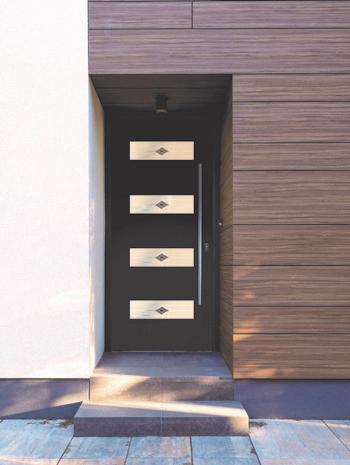

Shadow Gap is Freefoam’s latest Fortex Embossed PVC Cladding product. This, like all other products in the range, is available in the new Anthracite Grey colour. The cladding can be fitted horizontally or vertically and is co-extruded with a rigid foam core and durable textured surface. It is also manufactured to make storing, handling and fitting as quick and easy as possible.
With Part S of the Building Regulations outlining all newly constructed homes in England must include electric vehicle (EV) charging points, Marley has introduced its Electric Vehicle Charger. Coming complete with a 3-year warranty, the 7kW wall mounted socketed charging unit can be controlled via

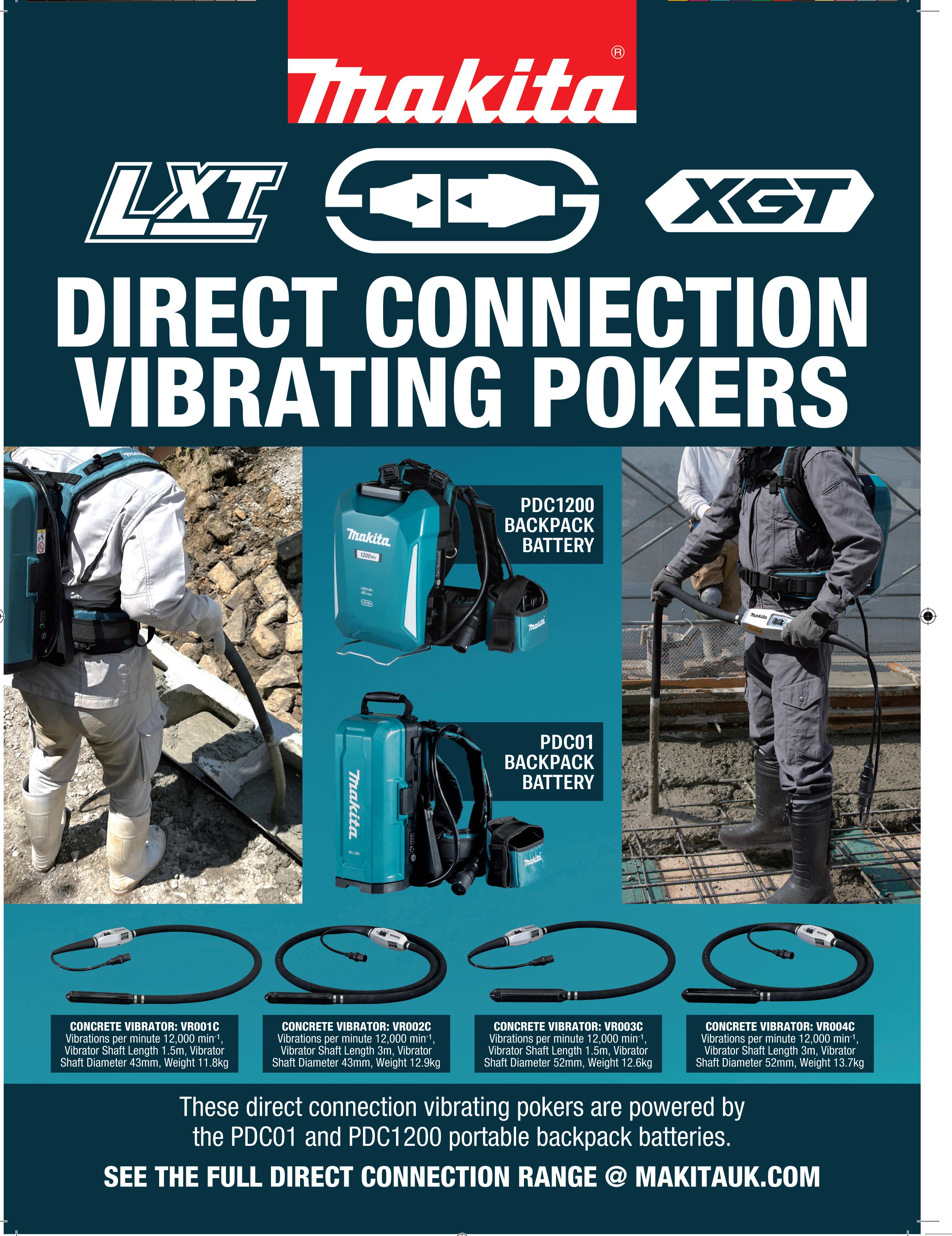

For specialist glass needs when building a new home, TuffX can supply single conservatory glass units up to 4,000mm. The company offers custom quotes and manufactures its glass for use inside and outside a project. Other applications include stair treads, doors, rooflights and walk on floors. The toughened glass from the company comes in a range of thicknesses, with the laminated variant going up to 39.5mm.
WWW.RDR.LINK/BAU057
Answering contractor demand for a more efficient and robust composite geogrid, Wrekin Products has introduced SX Composite 3030, a brand-new two-inone solution. This consists of a nonwoven geotextile thermally bonded to its existing SX geogrid. Developed with contractor feedback in mind – it combines reinforcement, separation and filtration into one single product.

GET MORE DETAILS AT:





A premium range of highly durable and weather resistant external door blanks is being introduced by James Latham from Moralt. FERRO door blanks are made from top-quality natural and engineered timbers with a range of decorative options available. Each one also contains two thermally isolated solid steel stabilising bars in its core and comes with a 10-year anti-bowing guarantee.
WWW.RDR.LINK/BAU059
As part of its Legacy suite of entrance doors, Comar Aluminium Architectural Systems has unveiled its Fuzion option. The durability and thermal properties of these combines the thermal efficiency of aluminium with the beauty and environmental credentials of timber. All doors are supplied with a Winkhaus AV3 slam shut lock as well as a 3-star security cylinder and 2-star security escutcheon.
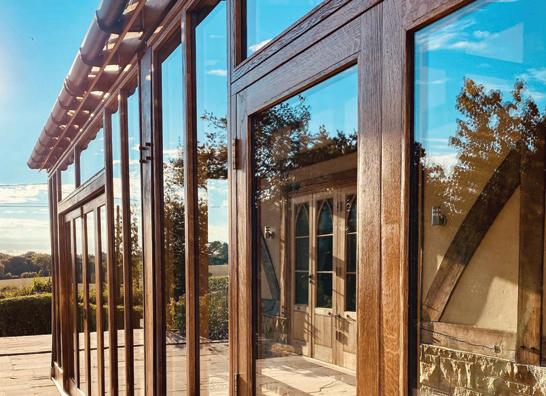
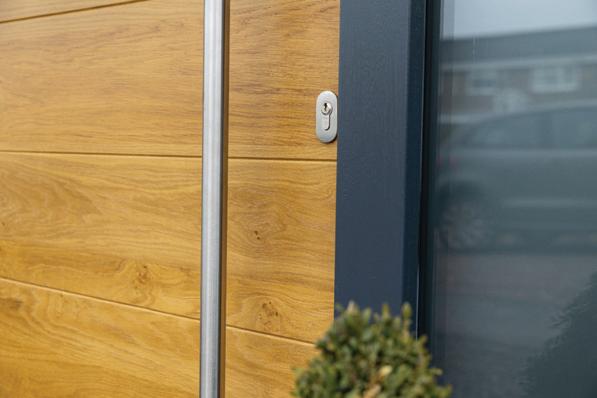
GET MORE DETAILS AT: WWW.RDR.LINK/BAU060





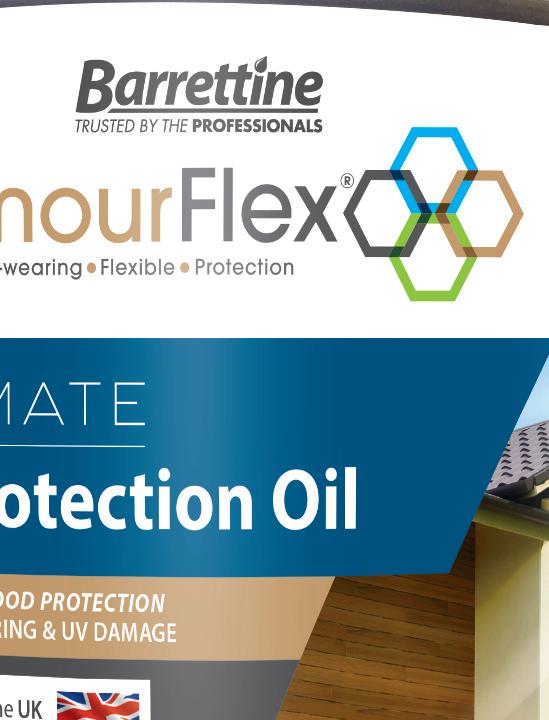
Sustainable modern architecture has evolved into the industry standard for construction projects, generating increasingly ambitious designs and incorporating natural materials – such as wood. This trend can be seen across many sectors in the construction of
The new Armourflex® Ultimate UV Protection Oil protects timber cladding and timber-faced structures from the sun’s UV rays, which quickly fade the wood’s natural colour. No matter what the type of wood, softwood, hardwood or even modified wood, they all have one thing in common – a suitable coating is usually needed to protect and prolong the service life of exterior wooden surfaces. Softwoods such as pine or spruce offer cost effective solutions but have the most need for protective coatings as they are less resistant to the elements.
Oak, chestnut, or larch can be left to weather naturally for a period of time but will lose its natural vibrancy if left untreated. Therefore, a UV Protection Oil is vital to protect any exterior wooden feature.
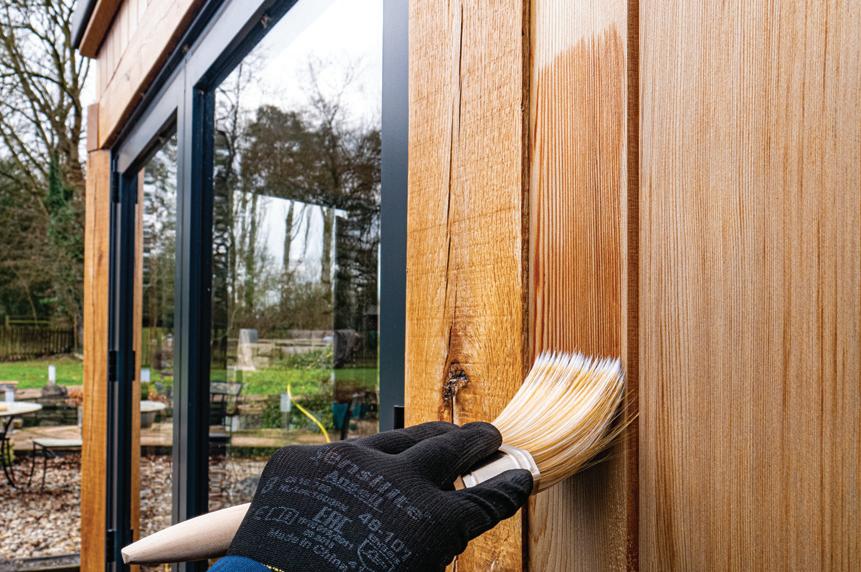
Ultimate UV Protection Oil is the latest high-performance addition to the specialist range of Armourflex coatings from Barrettine, offering an highly
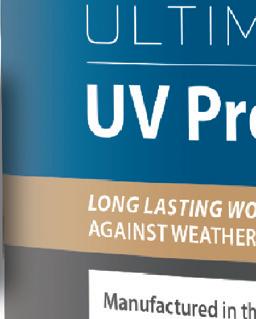



effective solution to protect exterior wooden facades, vertical surfaces and exterior timber building additions. The product has been formulated with a careful balance of UV absorbers and antioxidants, designed to capture the damaging UV rays from the sun and dissipate them safely away as heat. Containing performance-tested resins, the product also resists water and dirt, thereby reducing potential discolouration of the surface from fungal attack. This gives an overall picture of healthy-looking timber, with an extended service life and reduced maintenance expense.
Wooden facades will regress to grey and warp if left unprotected even for

relatively short periods of time. This weathering may not be uniform, changing and degrading the appearance of the building over time. If treated with a UV Protection Oil, this will avert greying and hinders swelling, shrinkage, splitting, and warping of wooden surfaces. Untreated timber eventually necessitates the expense of re-cladding and reduces the eco-credentials of the design. A coating which is vapour permeable, such as Barrettine’s, Armourflex Ultimate UV Protection Oil, is specially developed for external timber, as it is resistant to the cracking, flaking and peeling associated with more brittle varnishes or paints which can trap water under their surface.
The product retains the timber or cladding as a protected investment, looking newer for longer and maintaining its structural integrity, and protects the wooden surface when subjected to the intense variety of our now annual weather cycle.
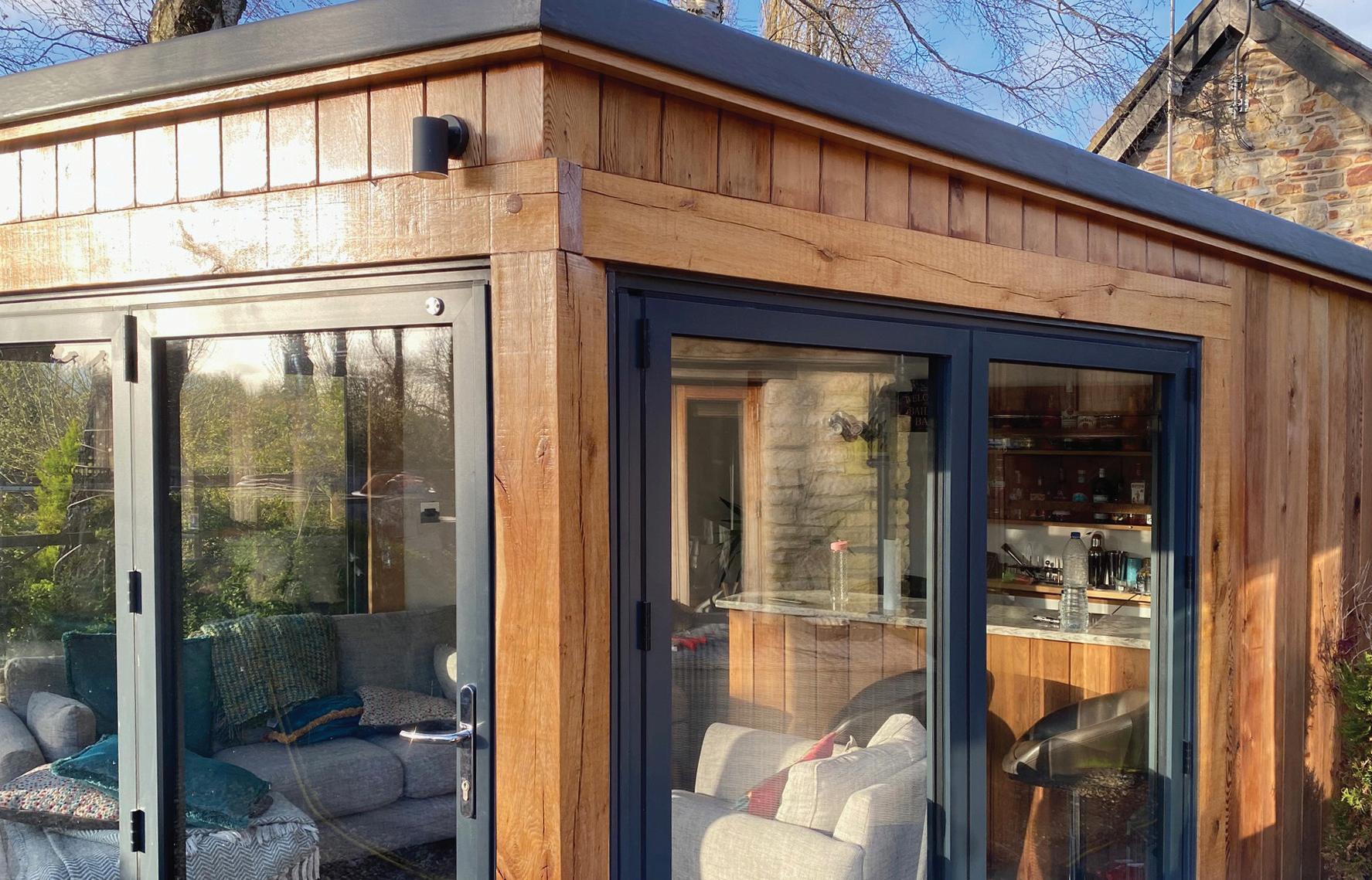
Armourflex Ultimate UV Protection Oil is not limited to wide expanses of cladding, it is equally suitable for exterior doors, window frames and joinery, to protect the wood against UV damage and weathering. A growing trend is the use of attractive, durable timber such as oak for the gentrification of older houses, particularly those from the 1970s, ‘80’s, & ‘90’s. The addition of new cladding, porches, porticos, solid timber doors and windows enhances the look and kerb appeal, easily transforming these homes into residences fit for the 21st Century.

Other areas of use are in old farm or commercial outbuildings, where sensitive conversions have retained many original features. These features need to be protected in order to fulfil planning permission. Stable doors, windows and windowsills, external joinery and exposed timber frames all need something that will preserve not only the character of the building, but also the investment. Application is easy, the product glides onto the wood with a brush or roller. Both coats can be applied within one working day and cured by morning.
Surface coatings work best on dimensionally stable timbers that are

unlikely to move when subject to moisture changes. Surface texture is important. Coatings generally perform better applied to sawn rather than smooth planed timber as absorption into the timber surface is greater.
Another consideration is building orientation. South & west facing facades are more exposed, not only to sunlight but also driving wind and rain, so will weather more quickly. North or east facing facades receive more shade and appear darker and, because of this, may require more frequent maintenance to prevent deterioration due to mould.
Shade from overhanging trees or other buildings may also have a localised impact and cause variations in colour on the same elevation. This can be more or less pronounced due to the season. To counteract these factors, or simply to add another dimension to your timber or cladding, Armourflex Ultimate UV Protection Oil will offer an ideal protective performance coating solution, which is
available in 1, 2.5 and 4litre sizes, depending on project size.

Barrettine also manufactures full range of protective wood treatments for your home and garden. These include premium Decking Oils, Wood Preservers and Wood Protective Treatments. They nourish and provide long lasting protection due to their oil-based formula which penetrates deeply into the wood grain, ensuring your exterior wood stands the test of time. All products are available now and can be purchased through their trusted stockists via their website below.
Barrettine is a Bristol-based, UK manufacturer with over 140 years history, specialising in high-quality protective wood coatings for professionals. With access to leading global suppliers, the manufacturer selects the best raw materials for its manufacturing processes to achieve the first-class durability expected from high-performance products. Through diligent product development, this allows the company to answer modern construction challenges with new, innovative solutions.
“No matter what the type of wood ... they all have one thing in common –a suitable coating is usually needed to protect and prolong the service life of exterior wooden surfaces.”
As the name suggests, these frames are designed for fast installation and mean that one of the company’s up & over doors can be fitted quickly and easily with as little as 7 fixings.
The steel frames are fixed straight onto the brickwork, so there’s no need for a traditional timber sub-frame which can warp or rot over time. Added to which, these steel frames have been developed with longevity in mind and are fully galvanised to protect them against rust. Plus, with the tight and accurate fit they provide, there is no need for infill with strips of uPVC.
With the easy and fast fitting of a steel frame, a canopy geared Garador garage door can be installed with just 7 fixings and its retractable gear door with just 11 fixings, saving a great deal of time and effort. Another bonus is that the Garador steel frame is supplied factory painted to exactly match the colour of the Up & Over garage

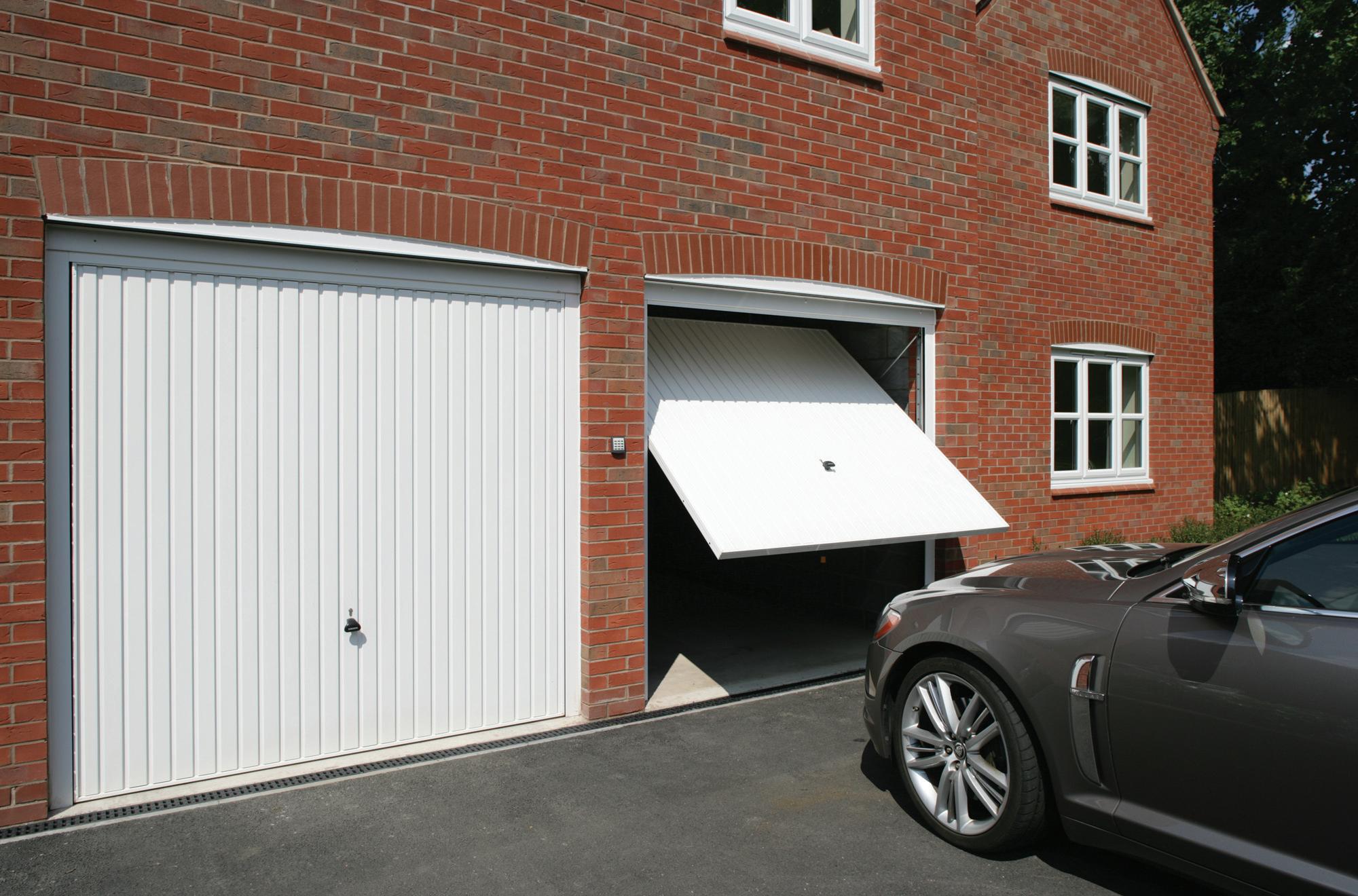
doors have always been among our top sellers, and in the current demanding market, we are not surprised to see sales of these doors continuing to surge.”
The company’s up & over steel garage doors are available in a huge range of styles and colours to make sure they suit the overall look of a home. They are also available in a number of sizes to fit a range of different sized openings. The garage doors can be fully automated too and fitted with the company’s own GaraMatic electric door operator, which allows even the wider garage door to be automated. This operator is equally designed for ease of use with specific attention to ensuring a quiet, smooth and fast opening. For peace of mind when it comes to safety, these electric operators comply with the latest European standards (BS 13241), including automatic reversal and built-in force limitation.
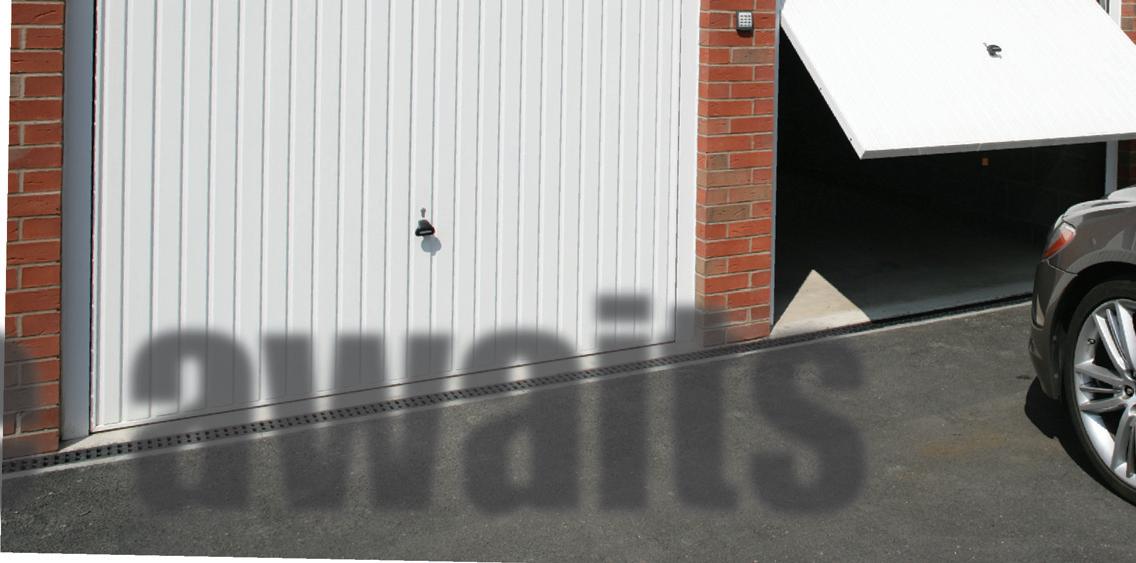

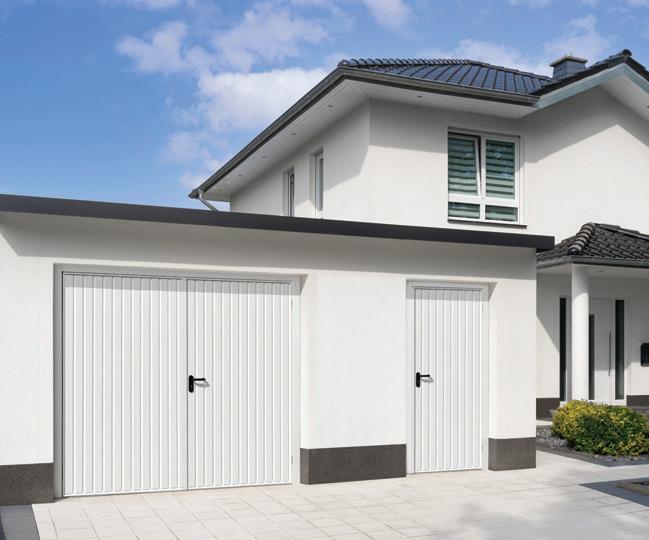

The company says the 6’8’’ and 7’2’’ door heights for its up & over garage doors have continued to grow in popularity. Standard 6’6” and 7’0” garage door heights don’t always match openings and gaps often have to be filled with uPVC. These taller 6’8” and 7’2” door heights from Garador are intended to offer a perfect fit for taller standard openings, with a 6mm fitting tolerance. This means
there is no need for uPVC cladding, saving both time and materials. The 6’8” door heights can be supplied with either canopy or retractable lifting gear, whilst the 7’2” door heights only come with retractable lifting gear. Both heights are available in the Carlton and Horizon range.
■ As an alternative to the up & over style, Garador has recently introduced an improved side-hinged garage door range. This is specifically designed for modern homes where garages are often used for storing garden equipment, bicycles and tools. In addition to its robust and versatile design, the improved range has been engineered with a variety of
Whilst the beginning of the year has presented a challenge for much of the construction industry and homeowners, there is positivity on the horizon as inflation rates begin to fall. Homeowners still want to improve their properties and our data shows that they are continuing to invest in renovations. However, homeowners’ priorities for their dream renovations are changing.
The modern conservatory Conservatories have been a mainstay extension for homeowners for decades. However, we are all too familiar with their lack of thermal efficiency.
They were preferred for their ability to let in natural light and to be constructed as a permitted development. But even this isn’t enough to entice the modern homeowner and some reports suggest that old-fashioned conservatories can diminish the value of a home by as much as £15,000.
Instead, homeowners that still want to benefit from additional living space and an abundance of natural light are turning their attention to sunrooms. A modern sunroom
doors and large windows can create the same illusion of a conservatory but with significantly better thermal efficiency. For example, Origin’s OB-72 Bi-fold Door can achieve U-Values as low as 1.1 W/m2K, exceeding current Building Regulations. What’s more, the Origin OW-80 Premium Window can be upgraded to use Aerogel, to achieve an ultra-low U-Value of 0.8 W/m2K. Not only does this mean that homeowners save on their energy bills, but it also means their beautiful extension can be enjoyed all year round.
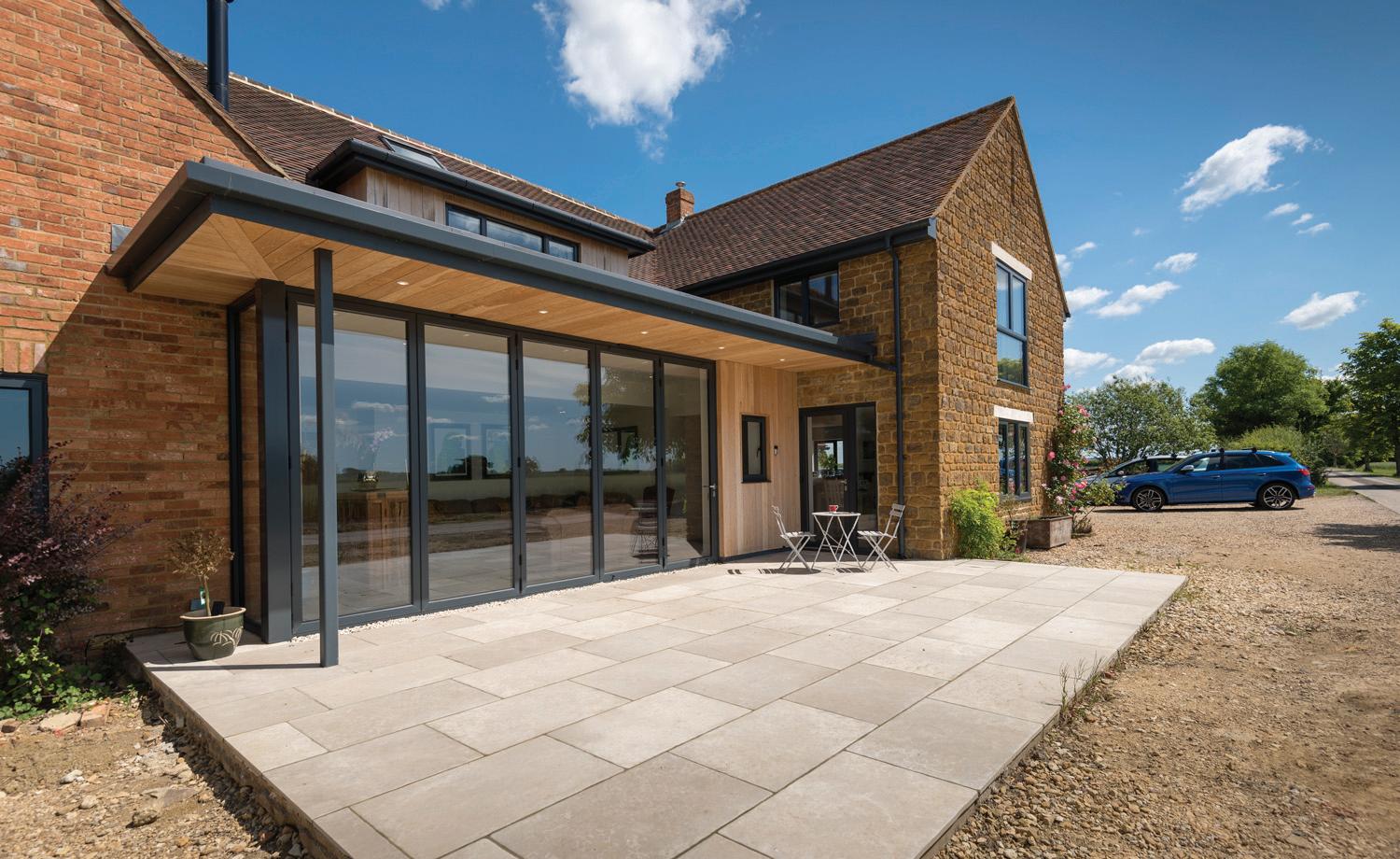

The pandemic proved to many that the open-plan way of living popularised in the 1970s is no longer a practical solution for modern living. Instead, families need ‘broken spaces’ that offer greater flexibility. For example, spaces that can be opened when entertaining, but easily shut off to create tranquil work environments or act as children’s playrooms.
Whilst homeowners want to divide their internal living spaces, they don’t want to compromise on the amount of natural light open-plan configurations afford them. Internal glazing is a great way to create separate spaces that don’t compromise on light. To respond to increasing homeowner demand, we launched our OI-30 Internal Door last year
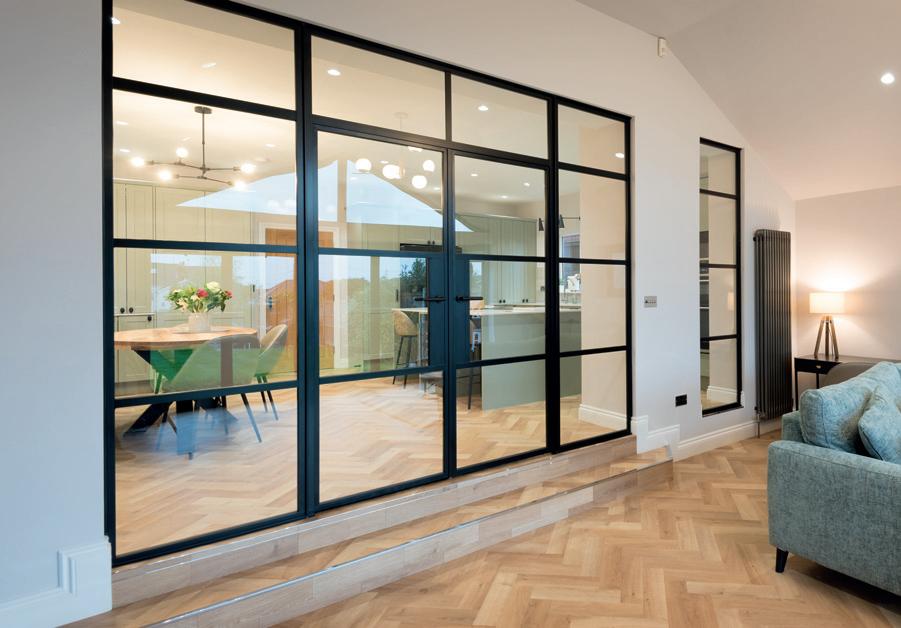
and it has been met with a fantastic response.
Made bespoke from high-grade aluminium, the OI-30 offers a more affordable alternative to traditional steel that doesn’t compromise on aesthetics. Available as a single or French door, or as a fixed screen, a combination of the two can be coupled with a corner post to create entirely new rooms as well as separate existing ones. Homeowners can also choose from over 150 RAL colours and the number of glazing bars to perfectly complement their interiors.
In 2023, homeowners want their spaces to work harder than ever before. They want conservatories they can use all year round and multi-functional spaces that accommodate the whole family’s activities. They will look to their builder for advice on how they can achieve these ambitions and –at a time of low consumer trust amidst financial strain –it’s critical that professionals remain up to date on trends and the products that can provide the functionality and aesthetics that is demanded.
Ben Brocklesby, Director at Origin, discusses the two leading renovation trends in 2023 and the products to help homeowners achieve their dream property.
Everyone loves a wrinkle that saves time or money or better still, a bit of both! And there’s a number of things that are being touted around now that busy builders can consider to make things a bit easier, or stick a couple of extra quid in the pocket…and a few things to watch out for too.
You’ll be fitting lots of bi-folds this summer and, at the risk of getting a ‘now you tell me’, something to look out for is the new tap in beads that we and some others are offering on these ever-popular aluminium folders. Supplied cut to size they are
If you’ve a good relationship with your local sealed unit supplier, you might just save a few quid by taking frames not only unglazed, but with the glass supplied locally to you by a favoured supplier, something that we are happy to accommodate. It can put extra money in your pocket and, should there be a breakage then a local supplier should invariably be able to supply a replacement quicker, perhaps in a few hours in a real emergency.

Bear in mind, however, that the glass unit will determine the overall specification including PAS24 security and U-value of the whole window and that the frame manufacturer cannot provide the full paperwork for compliance – the FENSA or Certass certificate in other words – if they did not supply the


fitted with co-extruded gaskets that are so easy to fit…. literally tap ‘em in and the glazing is sorted.
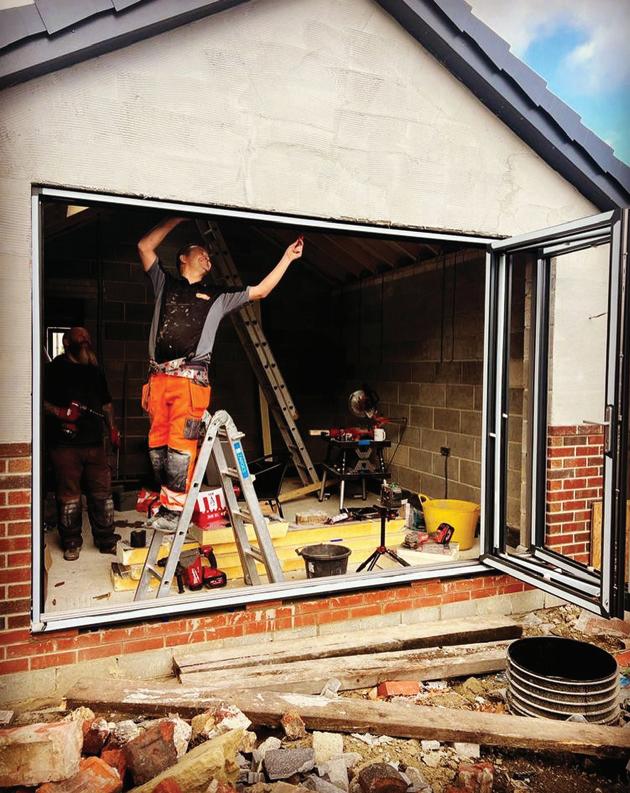
And while we are on the subject – to glaze or not to glaze; that is the question. Whilst heavier items like sliders and bifolds are supplied unglazed due to the weight, many builders like windows to be delivered ready glazed. Even if they are heavy and require a bit more elbow grease, the sheer convenience of installing windows pre-glazed can be quicker and slicker. On vertical sliders the sashes may even be supplied with quick release tilt arms to lighten the load a little during installation.
Quickslide’s Ade writes about the little things to consider this summer when fitting windows and doors, and how these can make a big impact
The bay window is a defining characteristic of British homes and one that spread in popularity to Ireland, Canada, the US and Australia. But, rather than some more historic versions that can be found on British buildings dating back to Medieval times, those that most builders will be asked to refurb with replacement windows in aluminium or PVCu are likely to be

After a year of trickle vents and an initial rebellion, the market has settled down and us windowmakers have pretty much sorted it, with a number of simple options. We offer trickle vents installed in sashes or add-ons for example, which in addition to providing compliance with the revised Building Regs that came in this time last year, it also saves worrying about plaster lines.
Now that anyone with any nous has got trickle vents sorted, you can start to get choosy: your supplier should have options suitable for the product ordered…VS should be available with heritage-choices such as woodgrain and colour-matched vents; for bi-folds, contemporary flush vents should also be available –just ask!






Performance labels stating the product assessment specification, name of the manufacturer, and date of manufacture are a mandatory requirement on all products with PAS 24 security. If it isn’t there, then it should ring alarm bells…it’s a silly corner to cut so what else isn’t up to scratch? The industry’s representative body the Glass & Glazing Federation (GGF), recently advised that the lack of proof of performance catches more people out than trickle vent non-compliance. No label, no FENSA certificate.
And finally, if you haven’t learned yet from bitter experience, make sure your supplier packs all loose or prone accessories thoroughly. Handles, trickle vents that extend past the frame, lift hooks and so forth...anything that can cause damage or be damaged during transit should be carefully packaged and labelled separately, or virtually mummified if fitted, to ensure it doesn’t become a major delay to the job because it snapped off enroute.
Adhesives and sealants have come a long way in recent years; what was once a simple toolbox addition now offers tradespeople superior performance onsite. Construction adhesives are now highly sought after by trade professionals due to their diverse qualities and the range of projects they cater for. But with so many types, brands, and formulas on the market, it’s hard to know which product is best for which job.
One product type which has been growing in popularity is hybrid adhesives and sealants, as they offer a cost-effective solution that combines many benefits. This includes different types of adhesive and sealant all in one product, resulting in improved performance and longer-lasting results.
In addition, some MS hybrid adhesives, just like those in the OneBond range, offer unique properties, such as high UV and humidity resistance to withstand high temperatures, the ability to be painted


once cured and are suitable for underwater applications.
Adhesive bonding is widely used in modern construction due to its ability to permanently join dissimilar materials, such as metals and plastic substrates. This type of bonding also permits higher construction rates and allows for more freedom in the design process. It’s perfect for working with materials that cannot be welded or secured with traditional fasteners.

Cyanoacrylate or “instant adhesives” are designed to quickly bond small plastic or metal parts. While long open-time epoxy-based adhesives are ideal for assembling and repairing large applications or complex shapes where maximum durability is required, such as sealing exterior pipe joints, sealing cracked concrete, filling oversized bolt holes, fixing anchors and repairing pipes and tanks.
Adhesives and sealants are perfect for maintenance and repair operations on structural components and can meet almost any process requirement in terms of environmental resistance, heat resistance and curing time, amongst many other examples. These substances can even help the end product to have a lighter mass than its metallic fastener counterparts.
In bathroom and kitchen settings, it is vital that all products, including sealants, are both sanitary and waterproof –two
benefits found across the OneBond range. At OneBond, we have worked to ensure our silicone sealants feature resistance against sunlight, temperature variation, humidity, shrinkage and even ozone.
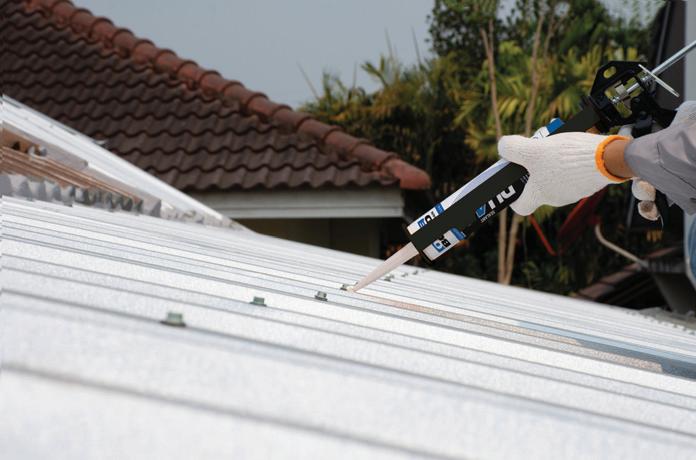
For day-to-day applications, polyurethane products have become the go-to product for tradespeople.


OneBond’s polyurethane products can fill expansion joints and seal joints between concrete structures, brickwork, and masonry. They can also seal gutters, secure roof tiles, and assemble and seal door/window framing components.

As the industry works to become more sustainable, adhesives and sealants can be a fantastic tool when considering the environmental impact of a project. When creating OneBond, for example, we focused on making our products as environmentally friendly as possible, prioritising low emissions and eco-friendly packaging options.
Tradespeople should check their adhesive products for Volatile Organic Compounds (VOCs), which can be harmful to human health. Looking for the EMICODE label on product packaging will also mean adhesives and sealants comply with the most stringent emission limits. At OneBond, we have made low-emissions a priority for our products, with most of our products having an A+ EMICODE label.

There are a few key factors that contractors should be taking into consideration when dealing with
adhesives and sealants – toxicity, flammability and irritants.
Contractors are often advised to use adhesives and sealants in well-ventilated areas to avoid inhaling the fumes and vapours due to the potentially harmful formulas, or to strictly avoid contact with the skin or eyes.

Manufacturers work to ensure that these raw materials are compounded in a safe environment. However, once formulated, it’s the user who has the responsibility to handle and dispose of adhesive and sealant products safely.
To ensure you are working with the safest and most user-friendly adhesives, look out for low toxicity, low VOC and low odour formulas – particularly for users prone to sensitivities.

Our OneBond range addresses all the core needs of tradespeople working in the construction sector. We have focused on keeping the range concise and easy to understand with clear and informative packaging.
OneBond ensures there is an adhesive or sealant for every kind of job, no matter how big or small, and offers more economical options in its acrylic sealant range. Prioritising user safety with low toxicity, low VOC and low odour formulas, these sealants boast high-end, architectural performance at competitive prices.
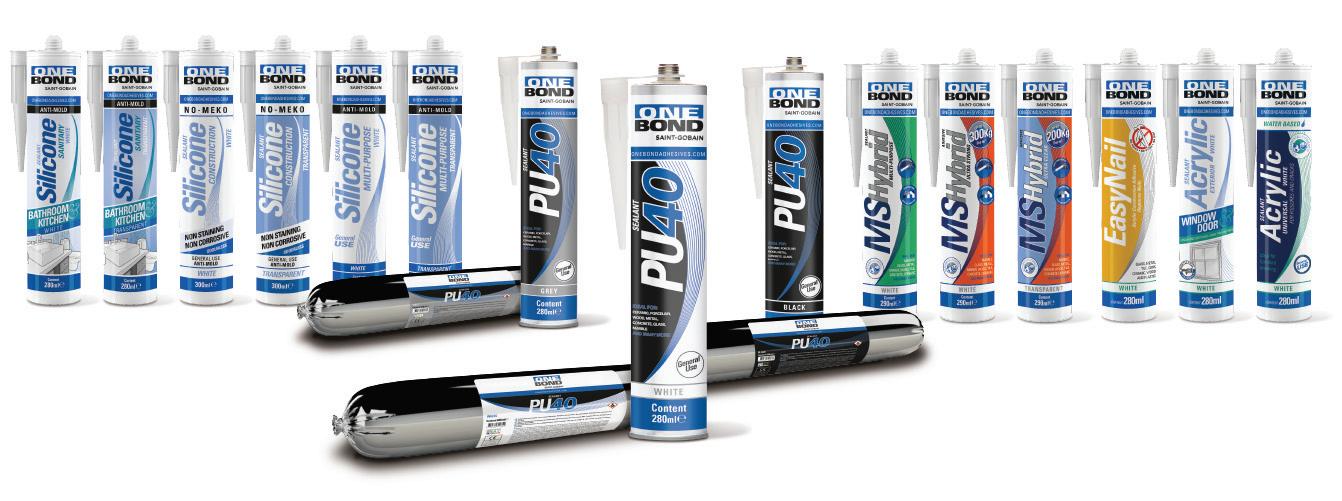
In construction, measuring equipment is a must in any trade, particularly in carpentry and joinery when the rule is to ‘measure twice, cut once’. I got the chance to play around with OX’s new Pro Tuff Rule to see if it really did rule when it comes to measuring.




I was impressed with the size of the rule because when it’s folded up it can fit into your pocket without you noticing that it’s there. When opening the rule, you can feel the quality as it’s operated with premium brass hinges and when fully opened it measures 600mm in length. This is a common measurement for stud and joist spacings which makes it handy for setting out. It’s made from ABS plastic meaning it has many qualities from good balance of impact, heat, chemical and abrasion resistance just to name a few.
The rule is clearly marked every 1mm making it easy to read, plus 50mm highlighted increments for quick measuring and marking. Another feature
that is well thought out is that the thickness of the rule is 5mm, when folded
to measure or even mark something quickly without having to open the rule. When you keep looking and playing with the rule you’ll notice new features. Another one that caught my eye was the centre line feature which is ideal for marking screw holes on brackets.
Finally, something that I find handy is the angle finder. Folding rules usually don’t have these, so this is a bonus. In carpentry and joinery, there’s many occasions where you need to measure angles, and this allows you to find angles from 0-180 degree. It doesn’t have a lock but with the swivel hinge it’s been designed so it stays at the angle it’s been set at and doesn’t move easily.
This OX Tool’s product really does rule. Thanks to its extensive range of features, it will will give you the power to undertake so many tasks.
FOR MORE INFORMATION ON THE OX TUFF RULE, USE THE RDR LINK: WWW.RDR.LINK/BAU068


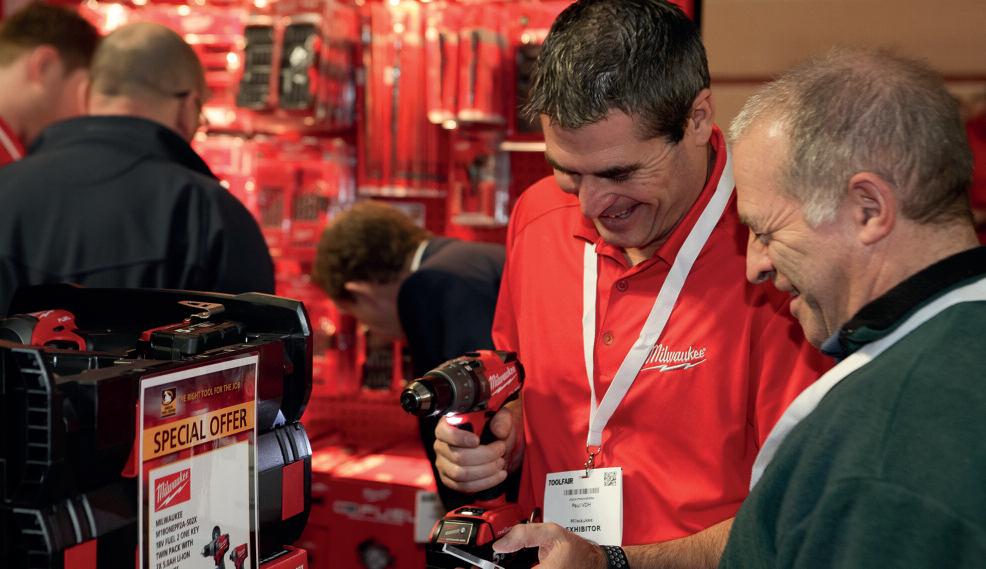




VISIT THE PROFESSIONAL BUILDER YOUTUBE CHANNEL FOR THIS AND OTHER GREAT VIDEOS



WWW.RDR.LINK/BAU069
Carpenter Richard from the Mr A Builders Youtube Channel recently took to the Professional Builder YouTube channel to review the Festool TS 60 K. Here’s what he thought:
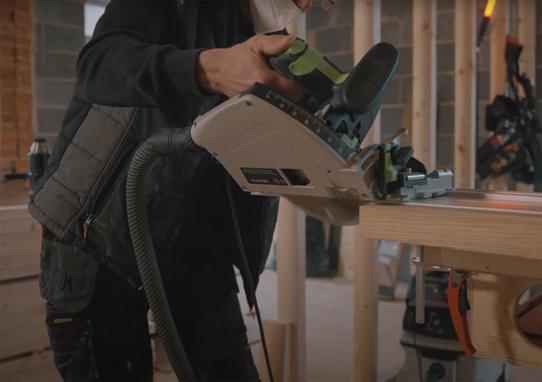


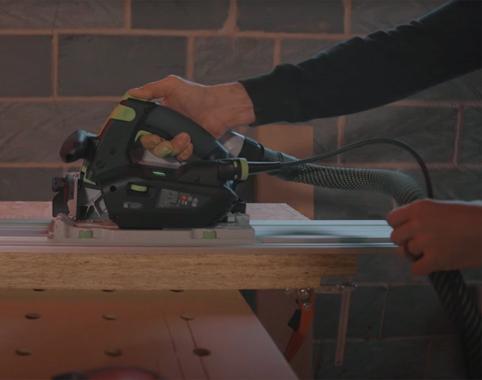
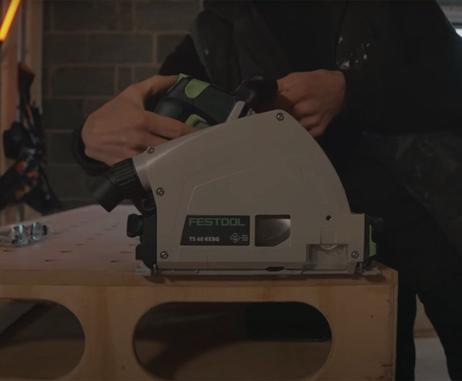
Festool is a brand that already enjoys a loyal following and the manufacturer has been very busy with new power tool launches. One such example is the TS 60 K: a plunge-cut circular saw that is adept at undertaking a range of different functions.
We here at Professional Builder thought this seemed like the perfect tool for a video review, so got in touch with Richard, a professional carpenter who features on the Mr A Builders YouTube Channel.
We filmed a great review with him at a job he was working on, where he got to test out and demo the saw, which is now available to watch on our YouTube channel @ProBuilderMag.
To start off, Richard gave himself (and us!) a quick “tour” of the TS 60 K and its features. One of the first things he pointed out was the handy green buttons on the saw. (Festool uses these for easy visibility for the main operating controls.) He liked that these prevented the awkward fumbling when you’re getting used to a new tool.
Next, Richard gave us a look at the
depth gauge and fine adjustment, which lets you use just the right amount of blade, making cutting safer and preventing unwanted damage to surfaces underneath. Richard then explained the anti-kick stop feature, which stops the blade when it detects it has caught on a material or been plunged too quickly. This stops the saw from “kicking” back at the operator and causing damage.
Richard was impressed with the locking feature for the plunge movement too. Festool has incorporated this into the blade changing, removing the usual hassle and meaning it just uses an allen key.
With an advertised 62mm of cutting depth, Richard thought cutting three OSB boards screwed together would be a good start for testing out the TS 60 K. He was impressed with how smoothly this worked, with a nice clean cut, plus some help from the splinter guard and guard rail. (The saw is also compatible with FSK cross cutting guide rails).
Richard also had a go at using the tilt feature on the saw, which cuts up to 40mm at a 47°. He did this with a piece of
oak at a 45° angle to make a floating shelf, proudly showing us how neatly the bits could fit together.
Festool offers a lot of options on the accessory front, something our reviewer really liked, including a dust extractor, which he believes is vital for safety. In a handy side by side, he showed us just how much dust cutting with power tools creates.
At the end of the video, Richard provided a summary of his thoughts on the saw. Overall, he was really satisfied with the TS 60 K and recommend it. His main highlights were the anti-kick stop, precision cutting and the quality accessories available.
THE PROFESSIONAL BUILDER YOUTUBE CHANNEL IS GOING TO BE SHOWCASING MORE REVIEWS LIKE THIS ONE, AS WELL AS HOW TO VIDEO GUIDES AND SAFETY TIPS FOR WORKING ON SITE, SO WATCH THIS SPACE!
THE RDR LINK BELOW TO WATCH THE REVIEW AND LET US KNOW WHAT YOU’D LIKE TO SEE NEXT!
WWW.RDR.LINK/BAU070
FOR FURTHER INFORMATION ON THE FESTOOL TS 60 K VISIT
WWW.RDR.LINK/BAU071
Here at PB we’re certainly no strangers to reviewing workwear and PPE on site but a recent experience was one of those rare occasions when a tradesman remarked that he “really likes those boots!”. That admiring digger driver was not wrong, of course. These PUMA Safety Conquest High Safety Boots in black are very imposing pieces of footwear. Indeed, that Conquest moniker is certainly apt because they look like they’re engineered to withstand a war zone – and the appeal is far from skin deep.
It goes without saying that comfort is king, and when you introduce these boots to your feet the warm hug of an inner lining is a satisfying first impression. In addition, that lining benefits from a breathable COA Tex® membrane that stops water from getting in but at the same time rather cleverly will let sweat and moisture out.
There’s further relief for your overworked feet from a fibreglass reinforced composite toecap that helps lighten the weight – whilst providing all the protection you’ll need – with the added bonus of thermal insulating properties. Continuing that theme, FAP® (Flexible Anti Penetration) technology protects the feet from penetrating objects. Unlike many brands –which make use of metallic anti-penetration technology –the PUMA solution is metal-free. It is, therefore, lightweight more flexible than a metal one and has better heat and cold insulating proeprties.
We found that the extra high shaft up the ankle provides plenty of support, whilst there’s also a pleasing level of flexibility when you’re kneeling or moving up and down a ladder. If you are brought to your knees by work on a regular basis, then the likes of floor layers will welcome the extra high scuff cap at the front of the


boot. It’s a feature that will increase their useful life and keep them looking better for longer.
For those who have previously owned boots of longer than average dimensions they might be put off by what can often be the mission of getting them off an on. Here, the zipper on the side makes that task almost as straightforward as removing a pair of slippers, whilst a dust flap behind the zipper prevents the ingress of dirt or dust – and you’ll never feel the zip on your ankle. There’s also a Velcro flap that provides further support and protection to that zip.

For the uninitiated a ‘last’ is the device that is used in shoe design. Here it has been developed for enhanced comfort with a deliberately wider construction at the small toes and the balls of the feet. As

you’d expect they’re waterproof, with a 300ºC heat resistant rubber outsole that’s equipped with a heavy-duty pattern, which is both slip resistant and mud releasing.
Overall, this is safety footwear that exhibits an impressive blend of strength, comfort and functional features and you can bet your boots that there will be many builders who will find the same.
When it comes to EV, Vauxhall is on the charge. Parent company Stellantis is the only OEM manufacturing LCVs on these shores and has already announced that its Ellesmere Port facility will be producing electric vans, with the Cheshire plant receiving a £100 million worth of investment to make the transition. Moreover, the company has announced that it will switch its entire product line-up to electric vehicles by 2028 – seven years ahead of the UK government deadline, and is one of the few makers that already offers an electric variant of every model.
As more and more builders make the transition to zero emissions they will, however, require support from manufacturers and Vauxhall is equally on hand to provide it. The current portfolio includes an EV Combo, Vivaro and Movano, with advances in load carrying ability and range moving apace. One thing that this UK-based maker of commercial vehicles prides itself on is the honesty with which it approaches the issue of range.
The Vauxhall range calculator tool is designed to ease some of the anxiety that
In the next issue of Professional Builder we will be reviewing the latest Vauxhall EV – the Vivaro GS Electric. Here, Lee Jones talks to Brad Miller, Head of LCV Product and Pricing about some of the latest developments from the manufacturer.

still exists around the issue by providing real world examples. “The WLTP (Worldwide Harmonised Light Vehicle Test Procedure) figure for the Vivaro is 205 miles but we want to be more transparent than that,” explains Brad. “The winter performance is something that is queried a lot and it’s not just about ambient temperature, of course, because there’s a number of factors that affect the range, including speed, payload and driving style.”
“As with every other manufacturer, the WLTP number is based on specific parameters, including a 28 per cent payload, at 20°C and taking into account a city, suburban, country and motorway cycle. Everyone uses WLTP because it allows a comparison between different brands but the range calculator on our website allows van users to play with things like speed and
provides a much greater degree of clarity. If you’re doing more urban driving, for instance, then you can achieve a much higher range.”

Living with an EV is, of course, a different experience to an internal combustion engine vehicle but Vauxhall is doing what it can to help with the move to electric motoring. One such initiative is the Lutonbased firm’s partnership with Octopus Energy that will supply an integrated home and public charging package. The latter’s Electroverse service has over 430,000 public chargers, and new and existing Vauxhall van users can access these as well as enjoying home charging through an Ohme home smart wall box installation, also available from Octopus Energy.
In addition, Intelligent Octopus is a home energy tariff that allows for smart charging of your electric vehicle to ensure you charge both at times with a higher mix of renewable energy sources as well as on the most affordable rate. By bringing home and public charging together tradespeople can then power their vehicle via one monthly bill with a single card and app.
“One of the frequent criticisms is that the EV charging market is fragmented, which means van drivers need to utilise multiple apps and cards depending on where they are,” continues Brad. “This partnership brings everything together for the end user with what is already the largest charging service provider at the disposal of Vauxhall owners.”
The Vauxhall van portfolio was also recently reconfigured with a simplified choice of trim. Prime and Pro variants have replaced the outgoing Dynamic, Sportive, Elite, and Edition trims, whilst the Vivaro Electric GS is now the UK’s first fully electric ‘sports’ van. “This is our halo vehicle,” enthuses Brad. “Vauxhall remains unique in having that third trim level, and it is heavily laden with style, safety and connectivity features.”


Indeed, this high spec addition features a bold road presence with 18-in. Y-spoke black alloy wheels, a lip spoiler at the front, side skirts around the vehicle and a two-piece spoiler at the rear to improve stability when unladen. Inside, there’s hand-crafted eco-leather seats
with red stitching and a GS logo.

Elsewhere in the EV range the Movano Electric now benefits from a larger 75kWh battery, replacing the outgoing 70kWh unit. That delivers up to 15 extra miles of range, allowing for a full range of up to

improvements, with a 0-80% charge from a 22kW AC charger now taking four hours (down from eight hours). The Movano-e also comes as standard with 50kW DC (CCS) rapid charging capability, enabling a 0-80% charge to be completed in just one hour.
Versatility is one of the guiding principles of the Vauxhall range and that’s why it’s one of the only companies to offer a choice of batteries on an electric van –with the Vivaro equipped with either a 50kW or 75kW unit. With a lighter battery pack the former has the advantage of an increased payload of up to 1,226kg.
Many builders will not be putting in high levels of mileage, especially with their van parked up outside the job for much of the day. That means they could well be ideally placed to make the transition to electric vehicles and Vauxhall provides one of the most extensive ranges on the market. The company now has its own dedicated LCV Business Unit, allowing it to get closer to its customers, improve the buying experience, and squarely focus on the van portfolio.
Continuing to expand its product range with the launch of Flexi Lock is UAP. The multi-point lock is versatile and can be paired with a vast range of rose handles. It is suitable for timber, composite and aluminium doors with a 45mm lock backset and is ideal with 1* or 3* cylinder. Additionally, it has a non-handed easily reversible latch and a bevelled edge and high tensile

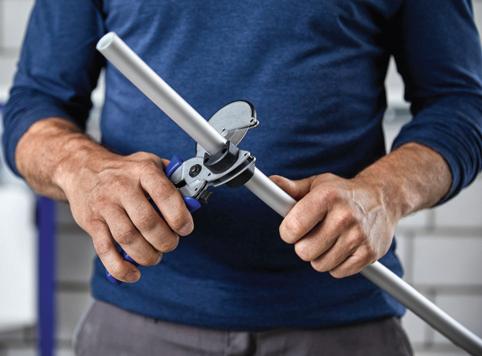
Designed to create one, consistent look-and-feel across a building, and manufactured using recycled aluminium for a sustainable solution, WICONA has launched a new range of minimalistic handles. The WICTOUCH range allows one handle design for all of its aluminium window, door and sliding systems.

GET MORE DETAILS AT: WWW.RDR.LINK/BAU075
Natural light in the home is known for its physical and mental health benefits as well as its ability to cut down on heating bills. With that in mind, Rainclear Systems has added a range of rooflights to its website including heritage and contemporary style pitched roof rooflights and contemporary style flat glass rooflights.

GET MORE DETAILS AT: WWW.RDR.LINK/BAU076
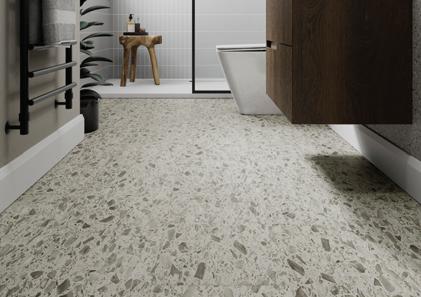
The terrazzo pattern Marma is one of four tile styles to join Malmo’s Rigid Comfort Vinyl Tile flooring range. The range is a durable and costeffective alternative to real stone and ceramic tiles and is easy to install thanks to a push down system. All designs are 5.5mm thick, have a rigid SPC waterproof core and are R10 slip resistant.
GET MORE DETAILS AT: WWW.RDR.LINK/BAU077
WWW.RDR.LINK/BAU078






The EASYJoint Select product range from Azpects expands with a Platinum colour, designed to complement emerging trends in landscape design. The jointing compound boasts a ready-to-use, sweep-in application method that is designed for a smooth finish. It is available in a number of colours and packaged in a 30% recycled plastic, 100% recyclable container.

The Sabik 350 & 500 series make up EnviroVent’s, Mechanical Ventilation Heat Recovery range, which is Passivhaus certified and designed for balanced and sustainable ventilation. The range offers a number of smart features as standard, with optional features like wall spacer brackets for tight installations available too.

Geberit has launched a multi-layer supply piping system to the UK market. FlowFit combines the versatility of the company’s multi-layer piping system with the installation benefits of its press-fit method. It is suitable for both potable water and heating application and is available in eight dimensions, with only two pressing jaws required for the entire range.
As a proactive approach to resolving common challenges caused by incorrect installation or lack of maintenance, Graf UK is offering free commissioning for its wastewater treatment systems. It is also offering a three-year warranty on these systems when the purchaser takes up a service agreement with one of the company’s network of accredited service providers. Use



Working with experts from across the housebuilding industry, the Future Homes Hub released a report on the Government’s 2025 Future Homes Standard and what factors the Government should consider when refining it. The report looks at the implications of specific areas of the standard and recommends what is needed to prepare

WWW.RDR.LINK/BAU083
To enhance its customer experience, Allur has posted a professional installation video showing how to install its longlasting composite decking range. The nine-minute video serves as a valuable training resource for installers and is available on the company’s YouTube channel and website. The website is also home to product FAQs, downloadable installation instructions and a handy decking calculator.

GET MORE DETAILS AT:
A new partnership between Planning Portal and BarbourABI, called FastPlan, will provide the construction industry with quicker access to planning application data. The new system is expected to speed up the release of this information by an average of one month compared to the current process, where tradespeople have to wait for local authorities to publish the information.


GET MORE DETAILS AT: WWW.RDR.LINK/BAU085
Designed to provide a broader understanding of fire door safety, Allegion UK has launched a set of best practice guides. In support of fire safety practice, the three Briton ‘Fire Door Safety in Review’ guides have been compiled drawing upon key insights from building managers and door hardware specialists. The guides are available upon request.
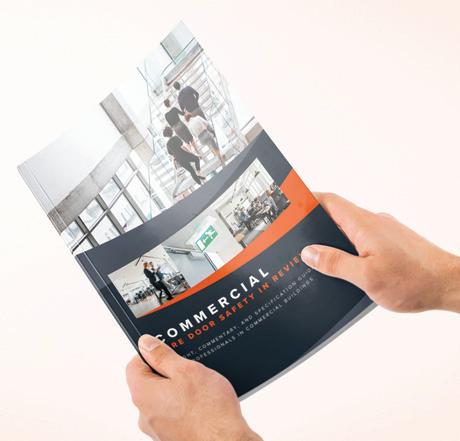
Use
history of society. Civilians often say they know nothing about building, but when they go on holiday they visit museums, and castles and medieval towns, and lap it all up. History is everywhere in building and construction.
It’s not just the walls, floors and ceilings of a building’s structure that make their mark in history, though. Flicking through the TV channels the other day I landed on a programme about the British army in the eighteenth century. Red coats (so they could see each other), big furry hats (to make them look taller), and marching in straight rows towards the enemy’s musket balls, hoping to kill more of them than they killed of us. (One of the few professions to offer a pension, though, if you were lucky enough to still be alive after seven years of such foolhardy practices.)
But the bit that caught my attention most was the bayonets. When the chilling cry of “fix bayonets” went down the line, the infantryman would slide his socket bayonet over the muzzle of his rifle, and give it a twist. A protruding lug on the gun barrel would engage in a slot in the bayonet, and lock it in place.
And hence we have the expression “bayonet cap”, still used for our traditional British design of light bulbs (or “lamps”, as my electrician friends always remind me is the correct term). I have been talking about bayonet cap lamp holders all my life, and never once put two-and-two together to even imagine
where the term might have originated. Blimey.
Until I learned this latest fact, I thought my only use of a military term was “soldier”, as in a soldier course of bricks or a soldier arch. Although now I come to think of it, there’s the use of “barrel” in relation to gas pipes. This stemmed from the use of redundant steel rifle barrels from the Napoleonic wars, for the fledgling domestic coal-gas industry. Just cut a thread on the two ends of the barrel, screw on a threaded female connector, and you’re cooking on gas –to coin a phrase.
And while we are on the subject of guns, there is always the recycling of big naval weaponry as street bollards. With a cannon ball welded into its open mouth, the gun-bollard has even been copied in modern replicas –but if you keep your eyes open, you can still spot some of the genuine originals around in London and our other cities (although recently some have been snaffled by the unscrupulous metal-theft gangsters).
But whether it’s bayonet caps, soldier courses or street bollards, military history is never far from the built environment.
Jeff HowellWhen you think about it, the history of building is the
Alufold Direct Ltd................................................................(page 65) www.rdr.link/BAU120
Azpects Ltd..........................................................................(page 59) www.rdr.link/BAU121
Barrettine Group................................................................(page 22) www.rdr.link/BAU122
Blue Circle............................................................................(page 64) www.rdr.link/BAU123
Bond-it..................................................................................(page 40) www.rdr.link/BAU124
Brett Martin BLDG Products Ltd..........................................(page 6) www.rdr.link/BAU125
Buckbootz............................................................................(page 38) www.rdr.link/BAU126
Build Aviator........................................................................(page 36) www.rdr.link/BAU127
Continal UFH......................................................................(page 62) www.rdr.link/BAU128
Dakea....................................................................................(page 48) www.rdr.link/BAU129
Eclisse UK Ltd......................................................................(page 25) www.rdr.link/BAU130
estimators.com....................................................(inside front cover) www.rdr.link/BAU131
Faithfull Tools......................................................................(page 44) www.rdr.link/BAU132
Federation Of Master Builders Ltd..................................(page 42) www.rdr.link/BAU133
Festool..................................................................................(page 55) www.rdr.link/BAU134
Garador................................................................................(page 44) www.rdr.link/BAU135
Hallstone..............................................................................(page 50) www.rdr.link/BAU136
House Builder XL Ltd..........................................................(page 11) www.rdr.link/BAU137
Knipex Tools UK..................................................................(page 35) www.rdr.link/BAU138
Made for Trade....................................................................(page 13) www.rdr.link/BAU139
Made for Trade..............................................................(pages 14,15) www.rdr.link/BAU140
Makita (UK) Ltd....................................................................(page 63) www.rdr.link/BAU141
MAN Truck & Bus Ltd............................................................(page 8) www.rdr.link/BAU142
Marley Ltd............................................................................(page 56) www.rdr.link/BAU143
NFU Mutual..........................................................................(page 39) www.rdr.link/BAU144
Omnie..................................................................................(page 30) www.rdr.link/BAU145
Origin Doors Ltd..................................................................(page 21) www.rdr.link/BAU146
Origin Doors Ltd......................................................(bound-in insert) www.rdr.link/BAU147
Ox Group UK..................................................................(back cover) www.rdr.link/BAU148
Pro Builder Online..............................................................(page 71) www.rdr.link/BAU149
Pnu-Point Ltd......................................................................(page 44) www.rdr.link/BAU150
Quickslide..............................................................................(page 5) www.rdr.link/BAU151
Rockwool UK Ltd..................................................................(page 18) www.rdr.link/BAU152
Smiths of the Forest of Dean Ltd......................................(page 73) www.rdr.link/BAU153
Soudal (UK) Ltd....................................................................(page 33) www.rdr.link/BAU154
STABILA UK Ltd..................................................................(page 59) www.rdr.link/BAU155
Thunderbolt........................................................................(page 58) www.rdr.link/BAU156
Toolfair..................................................................................(page 75) www.rdr.link/BAU157
Tuffx Processed Glass Ltd..................................................(page 60) www.rdr.link/BAU158
West Fraser Ltd....................................................................(page 51) www.rdr.link/BAU159
Here is a useful summary of all the adverts that appear in this issue of Professional Builder Each is listed with its page number and a direct URL that will get you straight to the relevant online informationLet’s start with the first A: abdominal. This refers to the abdomen – your tummy area. The second A is for aorta –the main artery that supplies blood around the body. The aorta carries blood away from the heart; it lies within the chest and the abdomen. The aorta is a big blood vessel – in adults it is normally 1.5 –2cm wide.
The final A stands for aneurysm. An aneurysm is when the muscular wall of a blood vessel is stretched so the vessel gets wider and wider. Abdominal aortic aneurysms usually get bigger over a long period of time – typically 1-2mm per year. When the aorta reaches a diameter of 5.5cm it becomes high risk – this is because the blood vessel’s muscular wall has been stretched thinly and due to high pressures in the blood vessel, the wall may start to leak or burst completely. If this happens it is a life-threatening medical emergency. Sadly, 80% of people who have a ruptured AAA will not survive as too much blood is lost too quickly before an operation can be done to help. Around 5,000 people in the UK will die of AAA every year according to the British Heart Foundation.
Many people with an AAA will have no symptoms. They are often found only at screening or when people have tests for other reasons. Some people may have a strong pulsing sensation they can feel in their tummy, or abdominal and back pain that does not go away. If the aneurysm ruptures, it can cause the following symptoms:

● sudden onset severe abdominal or lower back pains
● becoming pale, sweaty and clammy
● feeling dizzy
● feeling short of breath
● collapsing
● having a racing heartbeat
These symptoms relate to signs of shock and a 999 ambulance must be called immediately.
Although many people will die of a ruptured AAA each year, many more will have the condition and it will never cause
any problems. We are lucky in the UK to have a screening programme to check men for AAAs when they turn aged 65. This test is an ultrasound scan (USS) to look at the aorta in the abdominal region and measure it to see if there is any widening. It is done at this age as it is unlikely to happen in younger people. If there is an aneurysm seen on the ultrasound, what happens next will depend on the size of it. If it is small (3 –4.4cm wide) then yearly ultrasounds are offered to keep an eye on how much it grows, if it is medium sized (4.5 – 5.5cm) then ultrasounds are offered every three months to check its size, and people with large AAAs over 5.5cm may be offered surgery to try and prevent it getting bigger or bursting. Surgery to fix an AAA is a major operation that carries risks. It is not always successful, and if done as an
emergency, due to the aorta bursting, it is less likely to succeed.
Men are screened for AAAs as they are six times more likely to be affected than women. Woman with AAAs tend to be slightly older than men (over 70 years), but it does happen to them too. There are several things that increase the risk of an AAA developing:

● having high blood pressure
● Having chronic obstructive pulmonary disease (smoking related lung disease)
● Having high cholesterol
● Family history of AAA

● Having cardiovascular disease – heart disease or stroke
● Being a smoker or an ex-smoker.
You will notice that this list of risk factors contains all the common culprits for raising the risks of many diseases. Addressing these risk factors by having a healthy diet, losing weight, exercising regularly, controlling your blood pressure, reducing alcohol intake and stopping smoking can have a tremendous health benefit. They may also help stop an aneurysm increasing in size. If you have a family history of AAA, and are a woman, it may be worth discussing the possibility of having a screening USS with your GP as you will not be offered one routinely when you reach 65 years old.
IF YOU HAVE ANY CONCERNS ABOUT HAVING A AAA, OR THINK YOU MIGHT HAVE MISSED YOUR SCREENING APPOINTMENT, THEN YOU SHOULD CHECK IN WITH YOUR GP PRACTICE. THE ADMINISTRATIVE TEAM SHOULD BE ABLE TO DIRECT YOU TO THE SCREENING SERVICE TO CONTACT TO ARRANGE AN APPOINTMENT IF REQUIRED. MORE INFORMATION ABOUT SCREENING FOR AAAS CAN BE FOUND AT: WWW.RDR.LINK/BAU087
